Crochet Cable Cardigan
Learn to make a crochet cable cardigan that will keep the chill off while you’re at the office or just lounging around at home.
This cable cardigan has a slightly oversized fit, tapered sleeves, inset pockets, and last, but not least, it’s nearly seamless! The size inclusive crochet cardigan pattern includes women’s sizes XS through 5X.
The crochet cable cardigan pattern is free below, or you’ll find an ad-free printable PDF (including all photo tutorials + a BONUS garment schematic + BONUS crochet cable stitch charts) on Ravelry, or on Etsy (aff).
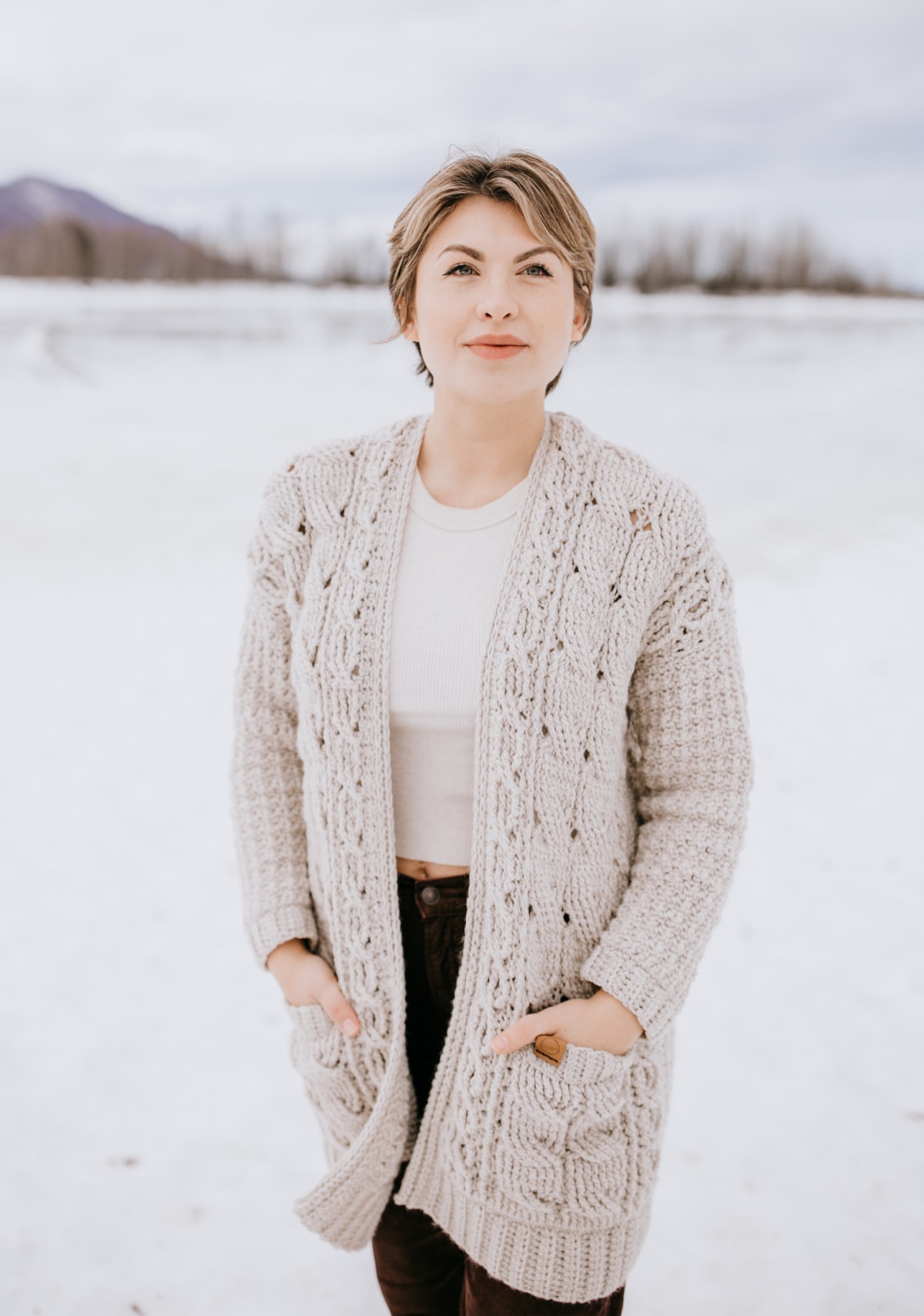
The Cozy Cabled Cardigan will keep the chill off while you’re at the office or just lounging around at home. This timeless crochet cardigan has a slightly oversized fit, tapered sleeves, inset pockets, and last, but not least, it’s nearly seamless!
Crochet cables tend to add a decent amount of weight and bulk to projects, so I designed this cardigan with cables on the front only. The sleeves and back of the sweater are made with a textured stitch pattern using extended single crochet stitches.
How to Crochet a Cabled Cardigan
If you’re searching for crochet patterns for cardigan sweaters, a long crochet cardigan, a cardigan with pockets, plus size crochet sweaters, or a one piece cardigan crochet pattern, this crochet cable cardigan pattern checks all the boxes.
This cardigan is worked from the bottom up.
You’ll begin by crocheting the wide ribbed bottom hem, then rotate to work the body of cardigan onto the long edge of the ribbed edge.
The body of cardigan is worked by beginning and ending each row with post stitches to create the cabled sections. In between the cabled sections, you’ll alternate working extended single crochet stitches in front and back loops to create the textured stitch pattern.
You’ll chain to create holes for the inset pockets while working the body. Then, continue with the body of cardigan until you reach the bottom of the armhole opening.
After you reach the bottom of the armholes, you’ll then split this into three panels and crochet the upper right panel, then back panel, then upper left panel.
After the body of cardigan is complete, you will then seam the shoulders with a whipstitch.
Next, you’ll crochet the sleeves right onto the armhole openings in joined and turned rows. After your sleeve is to length, you’ll then add a stretchy ribbed sleeve cuff.
Then, you’ll crochet two pocket pouches for the inset pockets and attach them to the pocket openings. You can make your pockets as deep as you’d like. Finish off the pockets with a decorative ribbing along the top edge.
Lastly, you’ll crochet a simple edging right onto the front cardigan opening.
And there you have it! That’s how you make a crochet cable cardigan with pockets!

Choosing Which Size to Crochet
Model wears a women’s size medium and is modeling a size medium cardigan.
To choose your size, look over the size chart below.
- ‘Fits Chest’ measurement is the measurement of the intended wearer, not the garment’s finished measurement.
- Finished Chest, Sleeve Length, and Cardigan Length are measurements of the finished garment.
- This cardigan has 6-8″+ of positive ease built in for a classic fit.
- If you prefer more of an oversized cardigan, I would suggest making one size larger than chest size.
- If you prefer a more fitted look, I would suggest sizing down (as long as your chest size fits range of the smaller size).
- Cardigan length is measured from the nape of the neck down and includes the bottom ribbing.
- Sleeve length is measured from the underarm of the cardigan to edge of the cuff.
- Adjusting Sleeve Length: If you need to adjust sleeve length, there are instructions with how to do so in the sleeve section.
Size & Yardage Chart
The notes above refer to this size chart.
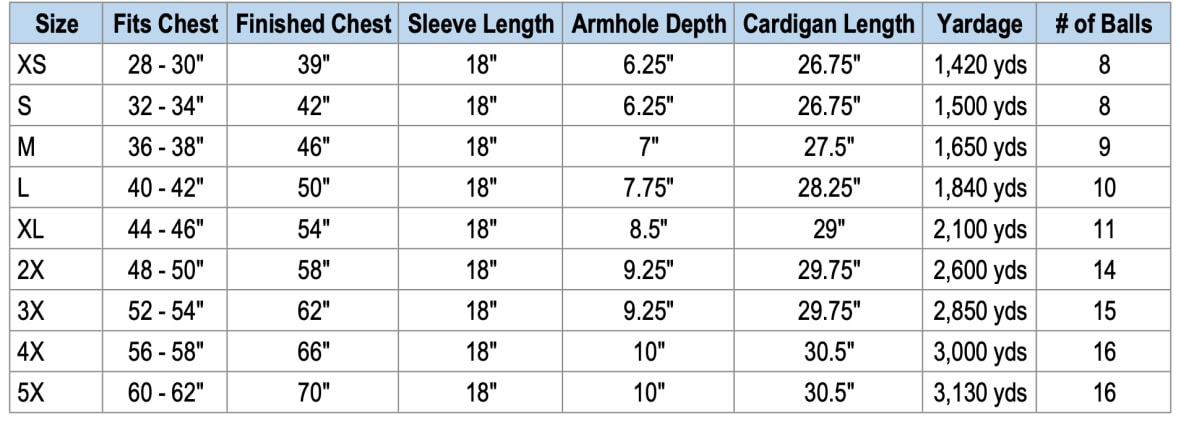
Yarn
This beige crochet cardigan was designed using Lion Brand Yarn Wool Ease in the colorway Linen. Wool Ease is my go-to worsted weight yarn for garments. It’s the best of both worlds with the feel, warmth and softness of wool, and the easy care of an acrylic worsted weight yarn.
Yarn Substitutions
You can substitute another worsted weight yarn as long as you’re able to meet gauge and you’re happy with the drape of the crochet fabric of the cabled cardigan.
I personally recommend a light worsted weight yarn that is similar to Wool Ease. When I say light worsted weight yarn, it’s not to be confused with a DK or double knit yarn that is often referred to as a light worsted. What I mean is a worsted weight 4 yarn that is lighter than others in the same category.

Crochet Cable Cardigan – Free Crochet Cardigan Pattern
The crochet cable cardigan pattern is below, but if you love to work offline, I’ve got a couple other great options for you.
Purchase the ad-free, printable PDF, including all photo tutorials + BONUS crochet garment schematic + BONUS crochet cable stitch charts, on Ravelry, or on Etsy (aff).
Purchase this cable crochet cardigan kit! (aff): Lion Brand has a full kit of the Cozy Cabled Crochet Cardigan, available on their website. The crochet cardigan kit includes your choice of colors and a digital copy of the crochet pattern.
This post contains affiliate links.
Materials
- Yarn: Worsted Weight / 4 / Yarn, (Lion Brand Yarn Wool Ease in Linen was used for the sample in the photos) (80% Acrylic / 20% Wool (197 yds / 180 m / 85 g / 3 oz).
- Yardage: See Size Chart Above
- Crochet Hooks: J/10/6.00mm; G/6/4.00mm; or size needed to obtain gauge (My favorite crochet hooks are the Clover Amour Crochet Hooks, I’ve never had an ache in my hand since switching).
- Locking Stitch Markers
- Scissors
- Yarn Needle
Abbreviations (US Terms)
- ch(s): chain(s)
- sl st(s): slip stitch(es)
- st(s): stitch(es)
- yo: yarn over
- sp(s): space(s)
- sc: single crochet
- hdc: half double crochet
- dc: double crochet
- ext sc: extended single crochet
- extsc2tog: extended single crochet decrease
- fpdc: front post double crochet
- bpdc: back post double crochet
- FPdbltr: front post double treble
- FPtrtr: front post triple treble
- hdslst: half double slip stitch
- Join with a standing single crochet
- SM: stitch marker
- Rep: repeat
- Rnd: round
- RS: Right Side
- WS: Wrong Side
- BLO: back loop only
Experience Level
- Intermediate
Gauge
- See individual sections for gauge.
Sizes
- Women’s XS through 5XL
- See size chart above.
Special Stitches
- Extended Single Crochet (ext sc): Insert hook into stitch indicated, yo, pull up a loop, yo, pull thru 1 loop on hook, yo, pull thru remaining two loops on hook.
- Extended Single Crochet Decrease (extsc2tog): Insert hook into stitch indicated, yo, pull up a loop, yo, pull thru 1 loop on hook, insert hook into next st, yo, pull up a loop, yo, pull thru 1 loop on hook, yo, pull thru remaining loops on hook.
- Half Double Crochet Decrease (hdc2tog): (Yo, insert hook into next stitch, yo, pull up a loop) twice, yo, pull through all loops on your hook.
- Front Post Double Crochet (fpdc): Yo, insert hook from front to back to front around the post of the indicated stitch, yo, pull up a loop, yo, pull thru 2 loops, yo, pull thru remaining 2 loops.
- Back Post Double Crochet (bpdc): Yo, insert hook from back to front to back around the post of the indicated stitch, yo, pull up a loop, yo, pull thru 2 loops, yo, pull thru remaining 2 loops.
- Front Post Double Treble (FPdbltr): Yo 3 times, insert hook from front to back to front around the post of the indicated stitch, yo, pull up a loop (5 loops on hook), (yo, pull thru 2 loops) 4 times.
- Front Post Triple Treble (FPtrtr): Yo 4 times, insert hook from front to back to front around the post of the indicated stitch, yo, pull up a loop, (yo, pull thru 2 loops) 5 times.
- Half Double Slip Stitch (hdslst): Yo, insert your hook into the stitch indicated, yo, pull up a loop and pull that loop through all loops on your hook.
- Join yarn with a standing single crochet: Begin with a slip knot on your hook, insert your hook into the stitch or space indicated, yo, pull up a loop, yo and draw thru both loops on hook.
Pattern Notes
- Turning chains are not counted as stitches, unless noted otherwise.
- The first stitch of each row is worked into the same stitch as the beginning chain, unless noted otherwise.
- Yarn Notes: Lion Brand Yarns Wool Ease was used for the samples. Another comparable worsted weight yarn may be used as long as gauge is met.
- Lion Brand Yarns Wool Ease: 80% Acrylic / 20% Wool (197 yds / 180 m / 85 g / 3 oz)
- Colorway & Yardage
- Linen: #620-096A (see yardage in chart above)
- Changes for Sizes are written as follows: XS (S, M, L, XL, 2XL, 3XL, 4XL, 5XL) unless noted otherwise.
- Stitch Counts are written at the end of the rows as follows: (XS, S, M, L, XL, 2XL, 3XL, 4XL, 5XL) unless noted otherwise.
- Cardigan Construction Notes: This cardigan is worked from the bottom hem up to the shoulders. First, you’ll crochet the wide ribbed bottom edge, then crochet the body onto the long edge of this ribbed edging. Once you reach the bottom of the armholes, you’ll split this into three panels and crochet the upper right panel, then back panel, then upper left panel. You’ll then seam the shoulders. Next, crochet the sleeves right onto the armhole openings. Pockets are then crocheted and whipstitched onto the pocket openings. Next, crochet a small pocket ribbing and whipstitch that on. Lastly, you’ll add a simple edging around the front opening of the cardigan.
- Cable Stitch Photo Tutorial: Scroll down to near the bottom of this post for step by step photos of the narrow and wide cables used on this cardigan.
- Model wears a women’s medium and is wearing a medium sample.
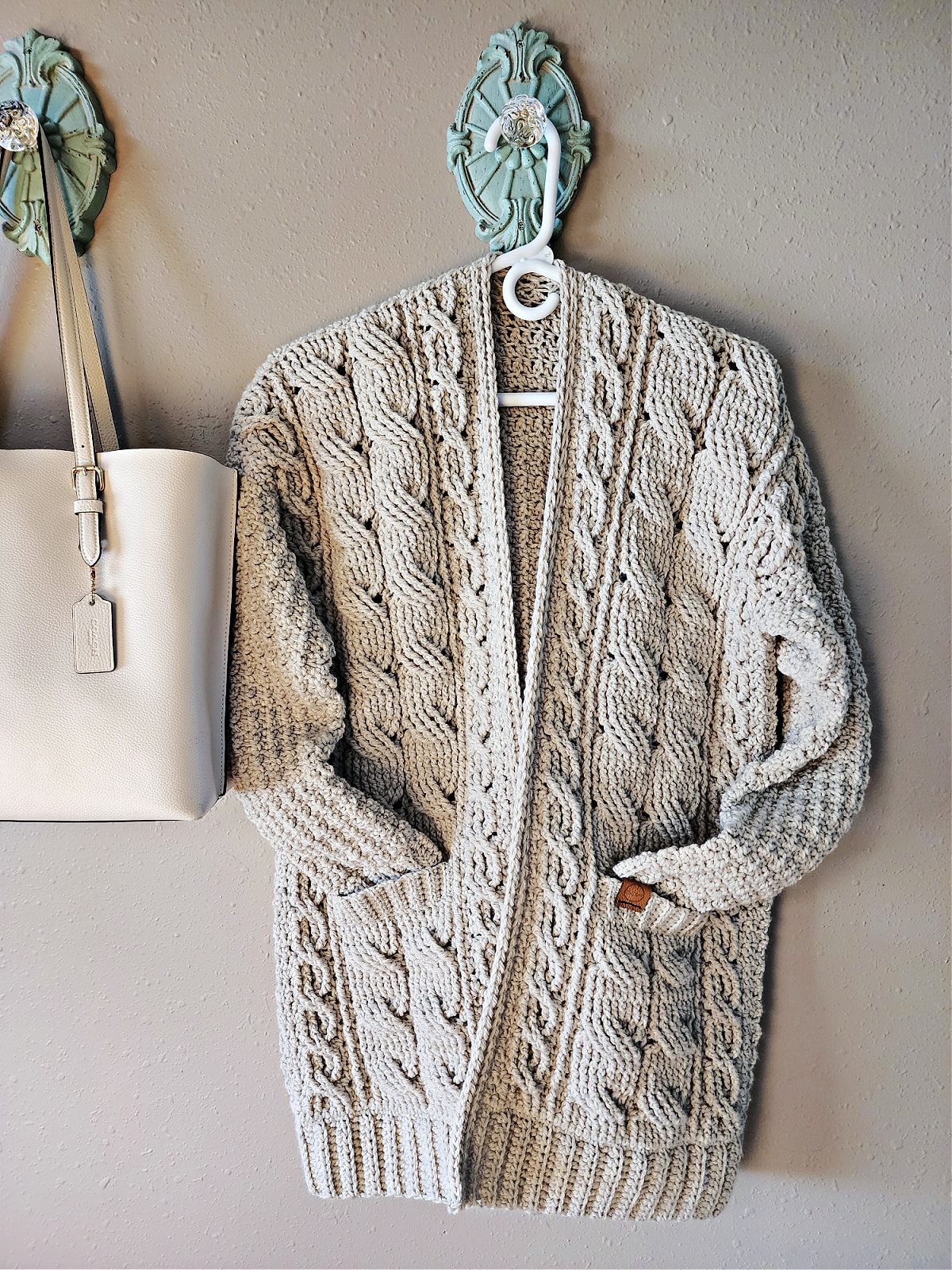
How To Get The
Cozy Cabled Crochet Cardigan
Option 1: Scroll down for the free crochet cardigan pattern right here in this blog post.
Option 2: Purchase the ad-free printable PDF from one of my shops:
Changes for Sizes as Follows: XS (S, M, L, XL, 2XL, 3XL, 4XL, 5XL)
Stitch Counts as Follows: (XS, S, M, L, XL, 2XL, 3XL, 4XL, 5XL)
Bottom Ribbing
Gauge: With a 6.00mm crochet hook, in BLO hdc: 10 sts = 2.75″; 12 rows = 5″.
Row 1: With yarn & a 6.00mm crochet hook, ch 11, working into the back humps of the ch, hdc in the 2nd ch from your hook and in each ch across. Turn. (10 sts)
Rows 2 – 85 (91, 100, 104, 112, 129, 135, 137, 144) : Ch 1, BLO hdc in each st across. Turn. (10 sts)
Do not fasten off. Continue on to Body of Cardigan. Your Bottom Ribbing should measure approximately 2.75″ W x 36″ (38.25″, 42″, 43.75″, 47″, 54″, 56.75″, 57.5″, 60.5″) L.
Body of Cardigan
Row 1 Gauge Only: With a 6.00mm crochet hook, in sc: 12 sts = 3.5″.
Size XS
Row 1 (RS): After turning at the end of the last row of the ribbing, rotate to work along the long edge of the ribbing, work 2 sc in the first st, then (2 sc in the next st, sc in the next st) work from ( to ) 42 times. Turn. (128 sts)
Do not fasten off. Continue below to X-Small – Body of Cardigan. The width of Row 1 should be approximately 37.5″.
Size S
Row 1 (RS): After turning at the end of the last row of the ribbing, rotate to work along the long edge of the ribbing, work 1 sc in the first st, then (2 sc in the next st, sc in the next st) work from ( to ) 45 times. Turn. (136 sts)
Do not fasten off. Continue below to Small – Body of Cardigan. The width of Row 1 should be approximately 40″.
Size M
Row 1 (RS): After turning at the end of the last row of the ribbing, rotate to work along the long edge of the ribbing, work (2 sc in the next st, sc in the next st) work from ( to ) 50 times. Turn. (150 sts)
Do not fasten off. Continue below to Medium – Body of Cardigan. The width of Row 1 should be approximately 44″.
Size L
Row 1 (RS): After turning at the end of the last row of the ribbing, rotate to work along the long edge of the ribbing, work (2 sc in the next st, sc in the next st) work from ( to ) 52 times. Turn. (156 sts)
Do not fasten off. Continue below to Large – Body of Cardigan. The width of Row 1 should be approximately 46″.
Size XL
Row 1 (RS): After turning at the end of the last row of the ribbing, rotate to work along the long edge of the ribbing, work (2 sc in the next st, sc in the next st) work from ( to ) 56 times. Turn. (168 sts)
Do not fasten off. Continue below to X-Large – Body of Cardigan. The width of Row 1 should be approximately 49″.
Size 2X
Row 1 (RS): After turning at the end of the last row of the ribbing, rotate to work along the long edge of the ribbing, work 2 sc in the first st, then (2 sc in the next st, sc in the next st) work from ( to ) 64 times. Turn. (194 sts)
Do not fasten off. Continue below to 2X-Large – Body of Cardigan. The width of Row 1 should be approximately 56.5″.
Size 3X
Row 1 (RS): After turning at the end of the last row of the ribbing, rotate to work along the long edge of the ribbing, work 2 sc in the first st, 2 sc in each of the next 2 sts, then (2 sc in the next st, sc in the next st) work from ( to ) 66 times. Turn. (204 sts)
Do not fasten off. Continue below to 3X-Large – Body of Cardigan. The width of Row 1 should be approximately 59.5″.
Size 4X
Row 1 (RS): After turning at the end of the last row of the ribbing, rotate to work along the long edge of the ribbing, work 2 sc in the first st, then (2 sc in the next st, sc in the next st) work from ( to ) 68 times. Turn. (206 sts)
Do not fasten off. Continue below to 4X-Large – Body of Cardigan. The width of Row 1 should be approximately 60.5″.
Size 5X
Row 1 (RS): After turning at the end of the last row of the ribbing, rotate to work along the long edge of the ribbing, work (2 sc in the next st, sc in the next st) work from ( to ) 72 times. Turn. (216 sts)
Do not fasten off. Continue below to 5X-Large – Body of Cardigan. The width of Row 1 should be approximately 63.5″.
Progression Photos of Body of Cardigan
The following photos are to show the progression of your cabled cardigan as you crochet the body. The photos are of a size medium, but the process is the same for all sizes.
Important Row 2 Tip: Row 2 of the Body of Cardigan is the cable set-up row. If you’re struggling with knowing exactly where the post of the stitch is that you need to work a post stitch around, make sure to check out my 2 Tips for Proper Post Stitch Placement. There is a quick video and a photo tutorial that will not only help you with the Cozy Cable Cardigan, it will help you with all other crochet cable patterns.
Additional progression photos are included in other sections below.
You’ll find cable stitch tutorials near the end of this post.
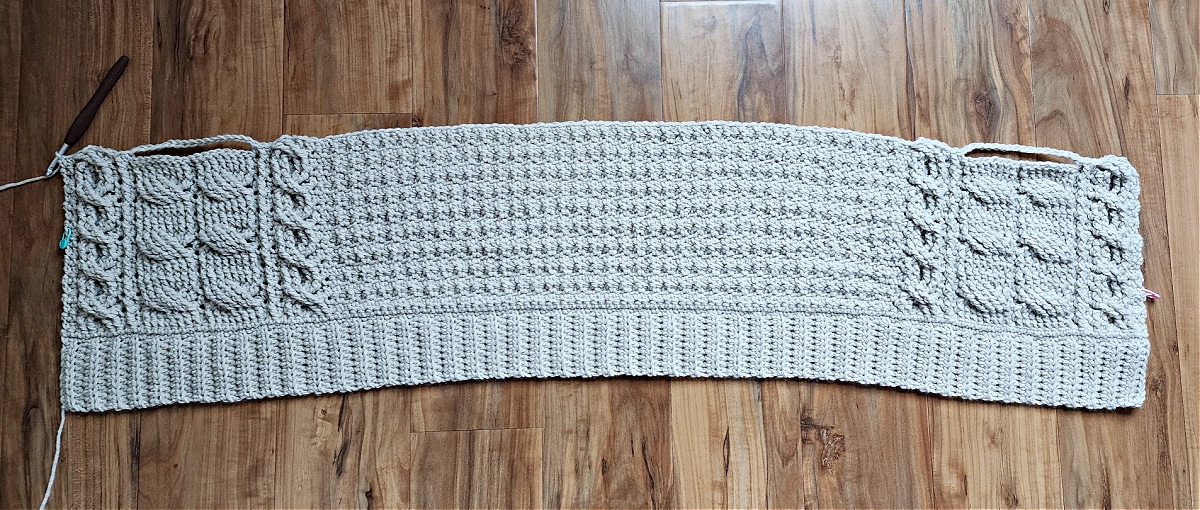
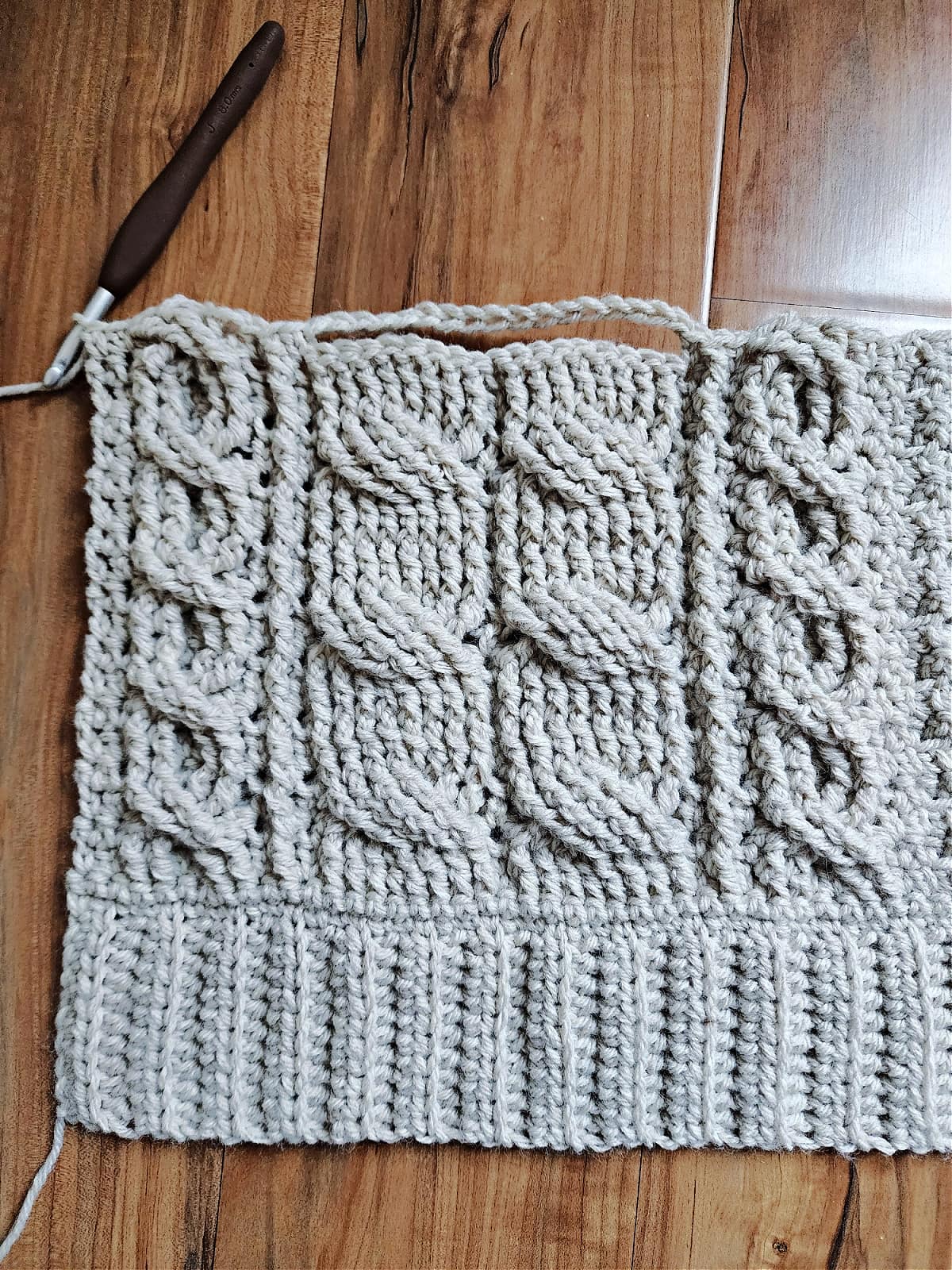
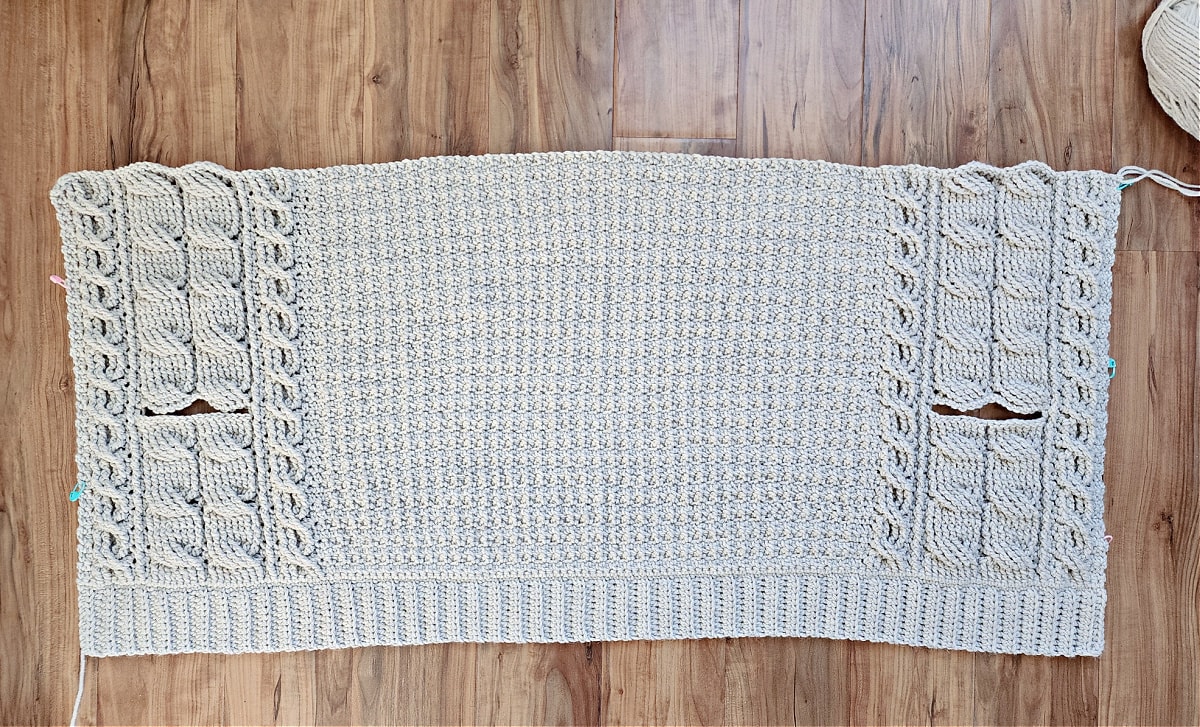
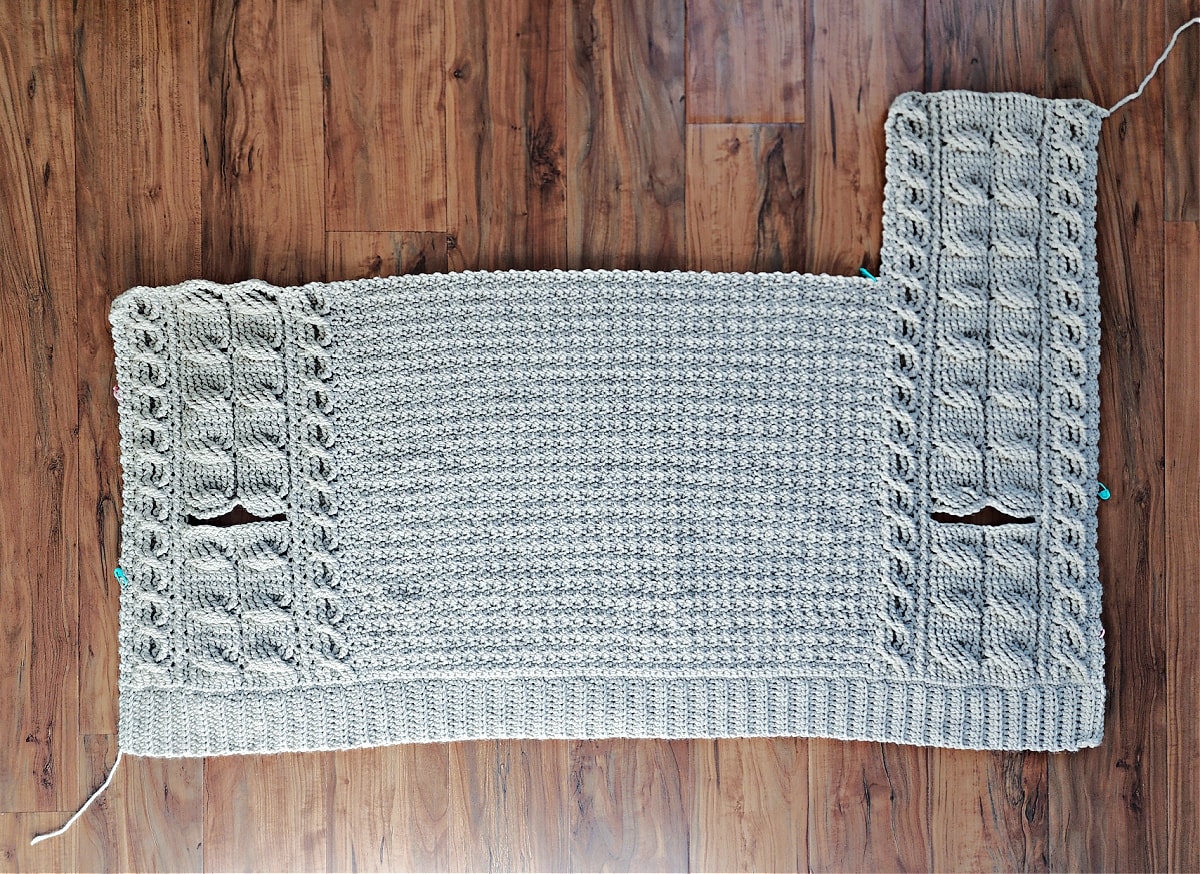
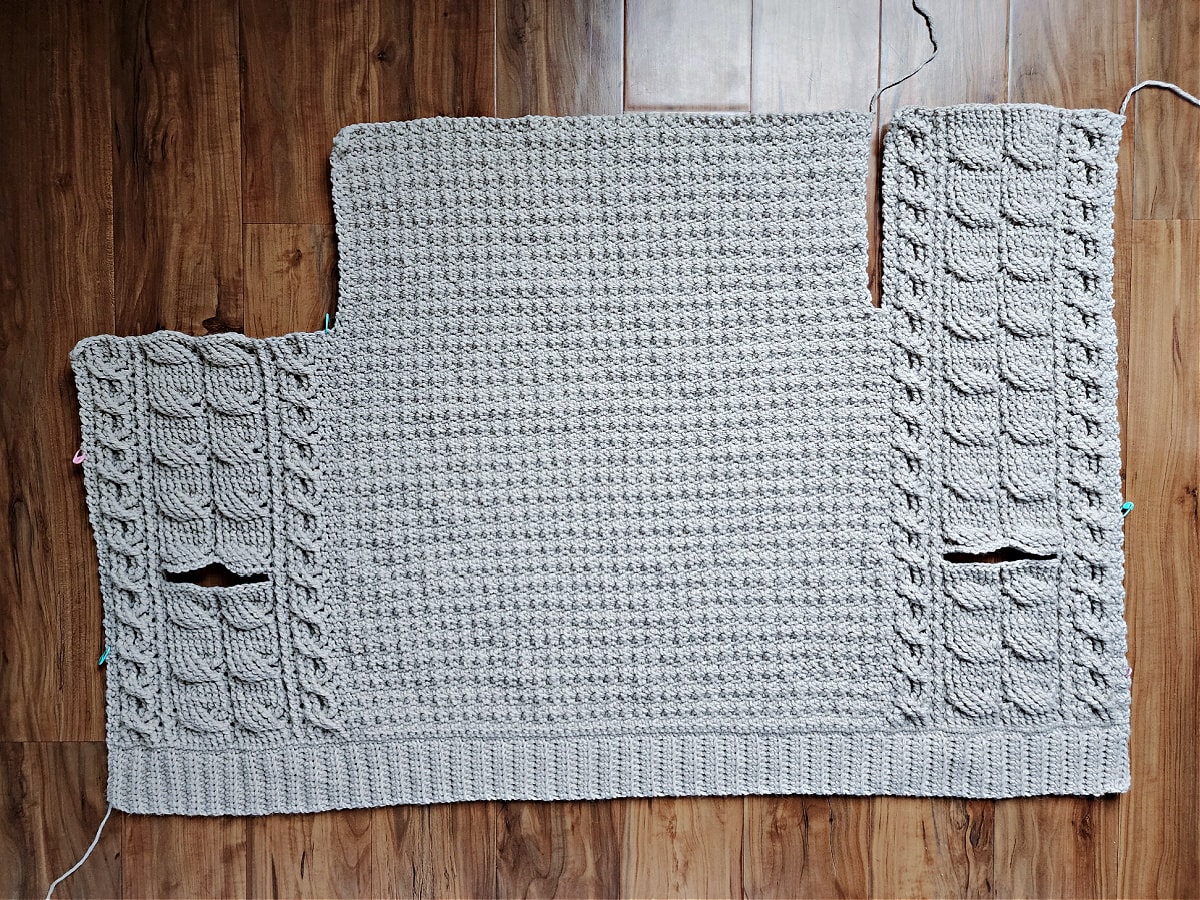
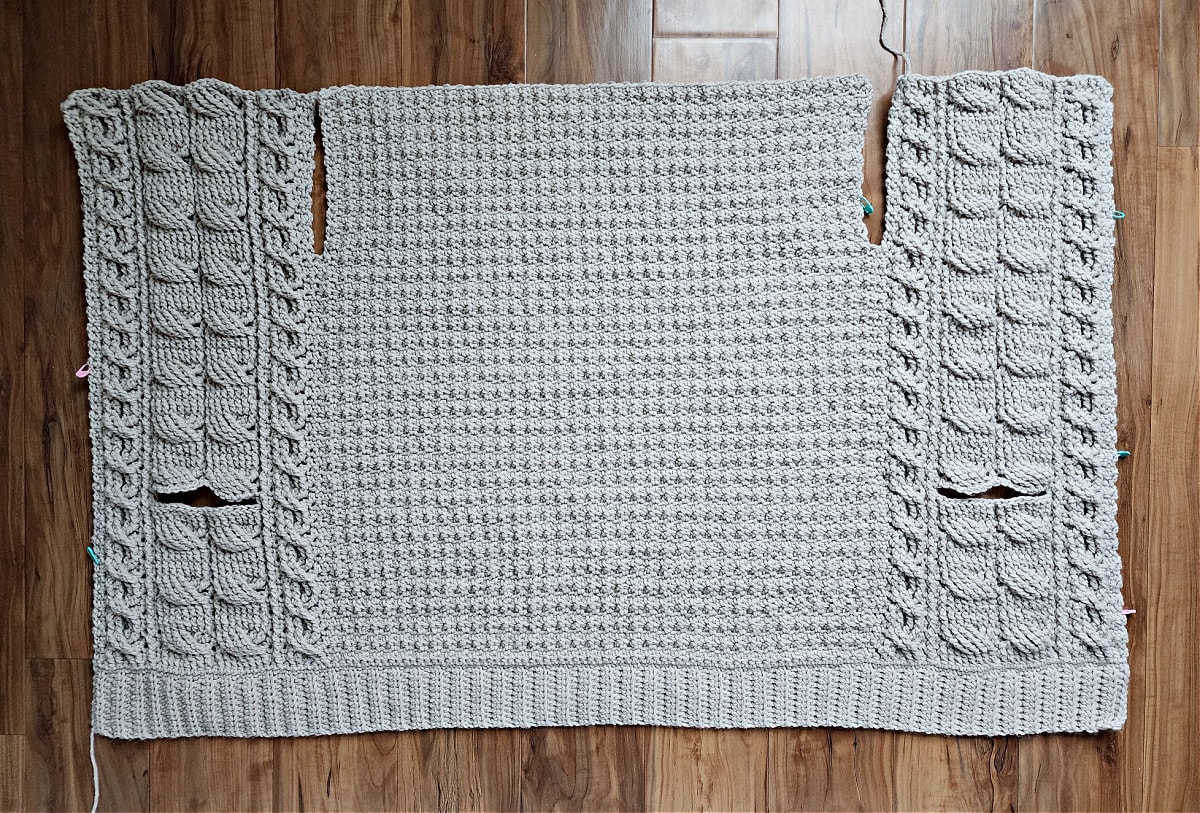
X-Small – Body of Cardigan
Gauge: With a 6.00mm crochet hook, in ext sc alternating FLO & BLO: 11 sts = 3.5″; 11 rows = 4.25″.
Cable Gauge: With a 6.00mm crochet hook, in cabled stitch pattern: 13 sts = 3.5″; 11 rows = 4.25″.
Cable Stitch Photo Tutorials- Scroll down to near the end of this post for the crochet cable stitch tutorials.
Row 1 (WS): Ch 1, sc in each st across. Turn. (128 sts)
Row 2 (RS): Ch 1, * ext sc in the next st, fpdc around each of the next 2 sts, ext sc in each of the next 2 sts, fpdc around each of the next 2 sts, ext sc in the next st, fpdc around the next st, (ext sc in the next st, fpdc around each of the next 6 sts) 2 times, ext sc in the next st, fpdc around the next st, ext sc in the next st, fpdc around each of the next 2 sts, ext sc in each of the next 2 sts, fpdc around each of the next 2 sts, ext sc in the next st *, then (ext sc in the BLO of the next st, ext sc in the FLO of the next st) work from ( to ) 31 times, lastly, repeat from * to *. Turn. (128 sts)
Row 3: Ch 1, * ext sc in the next st, bpdc around each of the next 2 post sts, ext sc in each of the next 2 sts, bpdc around each of the next 2 post sts, ext sc in the next st, bpdc around the next post st, (ext sc in the next st, bpdc around each of the next 6 post sts) 2 times, ext sc in the next st, bpdc around the next post st, ext sc in the next st, bpdc around each of the next 2 post sts, ext sc in each of the next 2 sts, bpdc around each of the next 2 post sts, ext sc in the next st *, then (ext sc in the FLO of the next st, ext sc in the BLO of the next st) work from ( to ) 31 times, lastly, repeat from * to *. Turn. (128 sts)
Row 4: Ch 1, * ext sc in the next st, skip each of the next 2 post sts & 2 ext sc, FPdbltr around each of the next 2 post sts, ext sc in each of the 2 skipped ext sc, working in front of the FPdbltr just worked, FPdbltr around each of the 2 skipped post sts, ext sc in the next st, fpdc around the next post st, (ext sc in the next st, skip each of the next 3 post sts, FPtrtr around each of the next 3 post sts, working in front of the FPtrtr just worked, FPtrtr around each of the 3 skipped post sts) 2 times, ext sc in the next st, fpdc around the next post st, ext sc in the next st, skip each of the next 2 post sts & 2 ext sc, FPdbltr around each of the next 2 post sts, ext sc in each of the 2 skipped ext sc, working in front of the FPdbltr just worked, FPdbltr around each of the 2 skipped post sts, ext sc in the next st *, then (ext sc in the BLO of the next st, ext sc in the FLO of the next st) work from ( to ) 31 times, lastly, repeat from * to *. Turn. (128 sts)
Row 5: Rep Row 3.
Row 6: Rep Row 2.
Row 7: Rep Row 3.
Row 8: Ch 1, * ext sc in the next st, skip each of the next 2 post sts & 2 ext sc, FPdbltr around each of the next 2 post sts, ext sc in each of the 2 skipped ext sc, working in front of the FPdbltr just worked, FPdbltr around each of the 2 skipped post sts, ext sc in the next st, fpdc around the next post st, (ext sc in the next st, fpdc around each of the next 6 sts) 2 times, ext sc in the next st, fpdc around the next post st, ext sc in the next st, skip each of the next 2 post sts & 2 ext sc, FPdbltr around each of the next 2 post sts, ext sc in each of the 2 skipped ext sc, working in front of the FPdbltr just worked, FPdbltr around each of the 2 skipped post sts, ext sc in the next st *, then (ext sc in the BLO of the next st, ext sc in the FLO of the next st) work from ( to ) 31 times, lastly, repeat from * to *. Turn. (128 sts)
Row 9: Rep Row 3.
Row 10: Ch 1, * ext sc in the next st, fpdc around each of the next 2 sts, ext sc in each of the next 2 sts, fpdc around each of the next 2 sts, ext sc in the next st, fpdc around the next st, (ext sc in the next st, skip each of the next 3 post sts, FPtrtr around each of the next 3 post sts, working in front of the FPtrtr just worked, FPtrtr around each of the 3 skipped post sts) 2 times, ext sc in the next st, fpdc around the next st, ext sc in the next st, fpdc around each of the next 2 sts, ext sc in each of the next 2 sts, fpdc around each of the next 2 post sts, ext sc in the next st *, then (ext sc in the BLO of the next st, ext sc in the FLO of the next st) work from ( to ) 31 times, lastly, repeat from * to *. Turn. (128 sts)
Row 11: Rep Row 3.
Row 12: Rep Row 8.
Row 13: Rep Row 3.
Row 14: Rep Row 2.
Row 15: Rep Row 3.
Rows 16 – 19: Rep Rows 4 – 7. Height is approximately 10″ H at end of Row 19.
In this next Row, we’ll create an opening for the pocket.
Row 20: Ch 1, * ext sc in the next st, skip each of the next 2 post sts & 2 ext sc, FPdbltr around each of the next 2 post sts, ext sc in each of the 2 skipped ext sc, working in front of the FPdbltr just worked, FPdbltr around each of the 2 skipped post sts, ext sc in the next st, fpdc around the next post st, ext sc in the next st, Ch 13, skip each of the next 13 sts, ext sc in the next st, fpdc around the next post st, ext sc in the next st, skip each of the next 2 post sts & 2 ext sc, FPdbltr around each of the next 2 post sts, ext sc in each of the 2 skipped ext sc, working in front of the FPdbltr just worked, FPdbltr around each of the 2 skipped post sts, ext sc in the next st *, then (ext sc in the BLO of the next st, ext sc in the FLO of the next st) work from ( to ) 31 times, lastly, repeat from * to *. Turn. (128 sts) includes chains
Row 21: Ch 1, * ext sc in the next st, bpdc around each of the next 2 post sts, ext sc in each of the next 2 sts, bpdc around each of the next 2 post sts, ext sc in the next st, bpdc around the next post st, ext sc in each of the next 15 sts, bpdc around the next post st, ext sc in the next st, bpdc around each of the next 2 post sts, ext sc in each of the next 2 sts, bpdc around each of the next 2 post sts, ext sc in the next st *, then (ext sc in the FLO of the next st, ext sc in the BLO of the next st) work from ( to ) 31 times, lastly, repeat from * to *. Turn. (128 sts)
Row 22: Ch 1, * ext sc in the next st, fpdc around each of the next 2 post sts, ext sc in each of the next 2 sts, fpdc around each of the next 2 sts, ext sc in the next st, fpdc around the next st, (ext sc in the next st, skip each of the next 3 sts, FPtrtr around each of the next 3 sts, working in front of the FPtrtr just worked, FPtrtr around each of the 3 skipped sts) 2 times, ext sc in the next st, fpdc around the next st, ext sc in the next st, fpdc around each of the next 2 sts, ext sc in each of the next 2 sts, fpdc around each of the next 2 post sts, ext sc in the next st *, then (ext sc in the BLO of the next st, ext sc in the FLO of the next st) work from ( to ) 31 times, lastly, repeat from * to *. Turn. (128 sts)
Rows 23 – 27: Rep Rows 11 – 15.
Rows 28 – 39: Rep Rows 4 – 15.
Rows 40 – 47: Rep Rows 4 – 11.
Do not fasten off. Continue on to the Upper Front Right Panel – X-Small. At this point, your cardigan should measure 37-1/2″ W x 20-1/2″ H.
Upper Front Right Panel – X-Small
Cable Gauge: With a 6.00mm crochet hook, in cabled stitch pattern: 13 sts = 3.5″; 11 rows = 4.25″.
Row 1 (RS): Ch 1, ext sc in the next st, skip each of the next 2 post sts & 2 ext sc, FPdbltr around each of the next 2 post sts, ext sc in each of the 2 skipped ext sc, working in front of the FPdbltr just worked, FPdbltr around each of the 2 skipped post sts, ext sc in the next st, fpdc around the next post st, (ext sc in the next st, fpdc around each of the next 6 sts) 2 times, ext sc in the next st, fpdc around the next post st, ext sc in the next st, skip each of the next 2 post sts & 2 ext sc, FPdbltr around each of the next 2 post sts, ext sc in each of the 2 skipped ext sc, working in front of the FPdbltr just worked, FPdbltr around each of the 2 skipped post sts, ext sc in the next st. Before turning, place a locking SM in the next st to mark where you will later join yarn to begin the Back Panel. Turn. (33 sts)
Row 2: Ch 1, ext sc in the next st, bpdc around each of the next 2 post sts, ext sc in each of the next 2 sts, bpdc around each of the next 2 post sts, ext sc in the next st, bpdc around the next post st, (ext sc in the next st, bpdc around each of the next 6 post sts) 2 times, ext sc in the next st, bpdc around the next post st, ext sc in the next st, bpdc around each of the next 2 post sts, ext sc in each of the next 2 sts, bpdc around each of the next 2 post sts, ext sc in the next st. Turn. (33 sts)
Row 3: Ch 1, ext sc in the next st, fpdc around each of the next 2 post sts, ext sc in each of the next 2 sts, fpdc around each of the next 2 sts, ext sc in the next st, fpdc around the next st, (ext sc in the next st, fpdc around each of the next 6 sts) 2 times, ext sc in the next st, fpdc around the next st, ext sc in the next st, fpdc around each of the next 2 post sts, ext sc in each of the next 2 sts, fpdc around each of the next 2 sts, ext sc in the next st. Turn. (33 sts)
Row 4: Rep Row 2.
Row 5: Ch 1, ext sc in the next st, skip each of the next 2 post sts & 2 ext sc, FPdbltr around each of the next 2 post sts, ext sc in each of the 2 skipped ext sc, working in front of the FPdbltr just worked, FPdbltr around each of the 2 skipped post sts, ext sc in the next st, fpdc around the next post st, (ext sc in the next st, skip each of the next 3 post sts, FPtrtr around each of the next 3 post sts, working in front of the FPtrtr just worked, FPtrtr around each of the 3 skipped post sts) 2 times, ext sc in the next st, fpdc around the next post st, ext sc in the next st, skip each of the next 2 post sts & 2 ext sc, FPdbltr around each of the next 2 post sts, ext sc in each of the 2 skipped ext sc, working in front of the FPdbltr just worked, FPdbltr around each of the 2 skipped post sts, ext sc in the next st. Turn. (33 sts)
Row 6: Rep Row 2.
Row 7: Rep Row 3.
Row 8: Rep Row 2.
Row 9: Ch 1, ext sc in the next st, skip each of the next 2 post sts & 2 ext sc, FPdbltr around each of the next 2 post sts, ext sc in each of the 2 skipped ext sc, working in front of the FPdbltr just worked, FPdbltr around each of the 2 skipped post sts, ext sc in the next st, fpdc around the next post st, (ext sc in the next st, fpdc around each of the next 6 sts) 2 times, ext sc in the next st, fpdc around the next post st, ext sc in the next st, skip each of the next 2 post sts & 2 ext sc, FPdbltr around each of the next 2 post sts, ext sc in each of the 2 skipped ext sc, working in front of the FPdbltr just worked, FPdbltr around each of the 2 skipped post sts, ext sc in the next st. Turn. (33 sts)
Row 10: Rep Row 2.
Row 11: Ch 1, ext sc in the next st, fpdc around each of the next 2 post sts, ext sc in each of the next 2 sts, fpdc around each of the next 2 sts, ext sc in the next st, fpdc around the next st, (ext sc in the next st, skip each of the next 3 post sts, FPtrtr around each of the next 3 post sts, working in front of the FPtrtr just worked, FPtrtr around each of the 3 skipped post sts) 2 times, ext sc in the next st, fpdc around the next st, ext sc in the next st, fpdc around each of the next 2 sts, ext sc in each of the next 2 sts, fpdc around each of the next 2 post sts, ext sc in the next st. Turn. (33 sts)
Row 12: Rep Row 2.
Rows 13 – 16: Rep Rows 1 – 4.
Fasten off leaving a tail of yarn that is 3-4 times the width of the panel. This tail of yarn will be used later to seam the shoulders. Continue on to the Back Panel – X-Small. Your Upper Front Right Panel should measure 9″ W x 6-1/4″ H.
Back Panel – X-Small
Gauge: With a 6.00mm crochet hook, in ext sc alternating FLO & BLO: 11 sts = 3.5″; 11 rows = 4.25″.
Row 1 (RS): With yarn & a 6.00mm crochet hook, join yarn with a sl st in the st you previously marked to begin the Back Panel, ch 1, ext sc in the same st, (ext sc in the FLO of the next st, ext sc in the BLO of the next st) rep from ( to ) across to the last st, BOTH LOOPS, ext sc in the last st. Before turning, place a locking SM in the next st to mark where you will later join yarn to begin the Upper Front Left Panel. Turn. (62 sts)
Row 2: Ch 1, Both Loops ext sc in the first st, (ext sc in the BLO of the next st, ext sc in the FLO of the next st) rep from ( to ) across to the last st, BOTH LOOPS, ext sc in the last st. Turn. (62 sts)
Row 3: Ch 1, Both Loops ext sc in the first st, (ext sc in the FLO of the next st, ext sc in the BLO of the next st) rep from ( to ) across to the last st, BOTH LOOPS, ext sc in the last st. Turn. (62 sts)
Rows 4 – 16: Rep Rows 2 – 3, ending with a Row 2.
Fasten off. Weave in ends. Continue on to the Upper Front Left Panel – X-Small. Your Back Panel should measure 19-1/2″ W x 6-1/4″ H.
Upper Front Left Panel – X-Small
Cable Gauge: With a 6.00mm crochet hook, in cabled stitch pattern: 13 sts = 3.5″; 11 rows = 4.25″.
Row 1 (RS): With yarn & a 6.00mm crochet hook, join yarn with a sl st in the st you previously marked to begin the Back Panel, ch 1, ext sc in the same st, skip each of the next 2 post sts & 2 ext sc, FPdbltr around each of the next 2 post sts, ext sc in each of the 2 skipped ext sc, working in front of the FPdbltr just worked, FPdbltr around each of the 2 skipped post sts, ext sc in the next st, fpdc around the next post st, (ext sc in the next st, fpdc around each of the next 6 sts) 2 times, ext sc in the next st, fpdc around the next post st, ext sc in the next st, skip each of the next 2 post sts & 2 ext sc, FPdbltr around each of the next 2 post sts, ext sc in each of the 2 skipped ext sc, working in front of the FPdbltr just worked, FPdbltr around each of the 2 skipped post sts, ext sc in the next st. Turn. (33 sts)
Row 2: Ch 1, ext sc in the next st, bpdc around each of the next 2 sts, ext sc in each of the next 2 sts, bpdc around each of the next 2 post sts, ext sc in the next st, bpdc around the next post st, (ext sc in the next st, bpdc around each of the next 6 post sts) 2 times, ext sc in the next st, bpdc around the next post st, ext sc in the next st, bpdc around each of the next 2 post sts, ext sc in each of the next 2 sts, bpdc around each of the next 2 post sts, ext sc in the next st. Turn. (33 sts)
Row 3: Ch 1, ext sc in the next st, fpdc around each of the next 2 post sts, ext sc in each of the next 2 sts, fpdc around each of the next 2 sts, ext sc in the next st, fpdc around the next st, (ext sc in the next st, fpdc around each of the next 6 sts) 2 times, ext sc in the next st, fpdc around the next st, ext sc in the next st, fpdc around each of the next 2 sts, ext sc in each of the next 2 sts, fpdc around each of the next 2 post sts, ext sc in the next st. Turn. (33 sts)
Row 4: Rep Row 2.
Row 5: Ch 1, ext sc in the next st, skip each of the next 2 post sts & 2 ext sc, FPdbltr around each of the next 2 post sts, ext sc in each of the 2 skipped ext sc, working in front of the FPdbltr just worked, FPdbltr around each of the 2 skipped post sts, ext sc in the next st, fpdc around the next post st, (ext sc in the next st, skip each of the next 3 post sts, FPtrtr around each of the next 3 post sts, working in front of the FPtrtr just worked, FPtrtr around each of the 3 skipped post sts) 2 times, ext sc in the next st, fpdc around the next post st, ext sc in the next st, skip each of the next 2 post sts & 2 ext sc, FPdbltr around each of the next 2 post sts, ext sc in each of the 2 skipped ext sc, working in front of the FPdbltr just worked, FPdbltr around each of the 2 skipped post sts, ext sc in the next st. Turn. (33 sts)
Row 6: Rep Row 2.
Row 7: Rep Row 3.
Row 8: Rep Row 2.
Row 9: Ch 1, ext sc in the next st, skip each of the next 2 post sts & 2 ext sc, FPdbltr around each of the next 2 post sts, ext sc in each of the 2 skipped ext sc, working in front of the FPdbltr just worked, FPdbltr around each of the 2 skipped post sts, ext sc in the next st, fpdc around the next post st, (ext sc in the next st, fpdc around each of the next 6 sts) 2 times, ext sc in the next st, fpdc around the next post st, ext sc in the next st, skip each of the next 2 post sts & 2 ext sc, FPdbltr around each of the next 2 post sts, ext sc in each of the 2 skipped ext sc, working in front of the FPdbltr just worked, FPdbltr around each of the 2 skipped post sts, ext sc in the next st. Turn. (33 sts)
Row 10: Rep Row 2.
Row 11: Ch 1, ext sc in the next st, fpdc around each of the next 2 post stst, ext sc in each of the next 2 sts, fpdc around each of the next 2 sts, ext sc in the next st, fpdc around the next st, (ext sc in the next st, skip each of the next 3 post sts, FPtrtr around each of the next 3 post sts, working in front of the FPtrtr just worked, FPtrtr around each of the 3 skipped post sts) 2 times, ext sc in the next st, fpdc around the next st, ext sc in the next st, fpdc around each of the next 2 sts, ext sc in each of the next 2 sts, fpdc around each of the next 2 post sts, ext sc in the next st. Turn. (33 sts)
Row 12: Rep Row 2.
Row 13: Ch 1, ext sc in the next st, skip each of the next 2 post sts & 2 ext sc, FPdbltr around each of the next 2 post sts, ext sc in each of the 2 skipped ext sc, working in front of the FPdbltr just worked, FPdbltr around each of the 2 skipped post sts, ext sc in the next st, fpdc around the next post st, (ext sc in the next st, fpdc around each of the next 6 sts) 2 times, ext sc in the next st, fpdc around the next post st, ext sc in the next st, skip each of the next 2 post sts & 2 ext sc, FPdbltr around each of the next 2 post sts, ext sc in each of the 2 skipped ext sc, working in front of the FPdbltr just worked, FPdbltr around each of the 2 skipped post sts, ext sc in the next st. Turn. (33 sts)
Rows 14 – 16: Rep Rows 2 – 4.
Fasten off leaving a tail of yarn that is 3-4 times the width of the panel. This tail of yarn will be used later to seam the shoulders. Continue on to Seaming the Shoulders below. Your Upper Front Left Panel should measure 9″ W x 6-1/4″ H.
Small – Body of Cardigan
Gauge: With a 6.00mm crochet hook, in ext sc alternating FLO & BLO: 11 sts = 3.5″; 11 rows = 4.25″.
Cable Gauge: With a 6.00mm crochet hook, in cabled stitch pattern: 13 sts = 3.5″; 11 rows = 4.25″.
Cable Stitch Photo Tutorials- Scroll down to near the end of this post for the crochet cable stitch tutorials.
Row 1 (WS): Ch 1, sc in each st across. Turn. (136 sts)
Row 2 (RS): Ch 1, * (ext sc in each of the next 2 sts, fpdc around each of the next 2 sts) 2 times, ext sc in the next st, fpdc around the next st, (ext sc in the next st, fpdc around each of the next 6 sts) 2 times, ext sc in the next st, fpdc around the next st, ext sc in the next st, (fpdc around each of the next 2 sts, ext sc in each of the next 2 sts) 2 times *, then (ext sc in the BLO of the next st, ext sc in the FLO of the next st) work from ( to ) 33 times, lastly, repeat from * to *. Turn. (136 sts)
Row 3: Ch 1, * (ext sc in each of the next 2 sts, bpdc around each of the next 2 post sts) 2 times, ext sc in the next st, bpdc around the next post st, (ext sc in the next st, bpdc around each of the next 6 post sts) 2 times, ext sc in the next st, bpdc around the next post st, ext sc in the next st, (bpdc around each of the next 2 post sts, ext sc in each of the next 2 sts) 2 times *, then (ext sc in the FLO of the next st, ext sc in the BLO of the next st) work from ( to ) 33 times, lastly, repeat from * to *. Turn. (136 sts)
Row 4: Ch 1, * ext sc in each of the next 2 sts, skip each of the next 2 post sts & 2 ext sc, FPdbltr around each of the next 2 post sts, ext sc in each of the 2 skipped ext sc, working in front of the FPdbltr just worked, FPdbltr around each of the 2 skipped post sts, ext sc in the next st, fpdc around the next post st, (ext sc in the next st, skip each of the next 3 post sts, FPtrtr around each of the next 3 post sts, working in front of the FPtrtr just worked, FPtrtr around each of the 3 skipped post sts) 2 times, ext sc in the next st, fpdc around the next post st, ext sc in the next st, skip each of the next 2 post sts & 2 ext sc, FPdbltr around each of the next 2 post sts, ext sc in each of the 2 skipped ext sc, working in front of the FPdbltr just worked, FPdbltr around each of the 2 skipped post sts, ext sc in each of the next 2 sts *, then (ext sc in the BLO of the next st, ext sc in the FLO of the next st) work from ( to ) 33 times, lastly, repeat from * to *. Turn. (136 sts)
Row 5: Rep Row 3.
Row 6: Rep Row 2.
Row 7: Rep Row 3.
Row 8: Ch 1, * ext sc in each of the next 2 sts, skip each of the next 2 post sts & 2 ext sc, FPdbltr around each of the next 2 post sts, ext sc in each of the 2 skipped ext sc, working in front of the FPdbltr just worked, FPdbltr around each of the 2 skipped post sts, ext sc in the next st, fpdc around the next post st, (ext sc in the next st, fpdc around each of the next 6 sts) 2 times, ext sc in the next st, fpdc around the next post st, ext sc in the next st, skip each of the next 2 post sts & 2 ext sc, FPdbltr around each of the next 2 post sts, ext sc in each of the 2 skipped ext sc, working in front of the FPdbltr just worked, FPdbltr around each of the 2 skipped post sts, ext sc in each of the next 2 sts *, then (ext sc in the BLO of the next st, ext sc in the FLO of the next st) work from ( to ) 33 times, lastly, repeat from * to *. Turn. (136 sts)
Row 9: Rep Row 3.
Row 10: Ch 1, * (ext sc in each of the next 2 sts, fpdc around each of the next 2 sts) 2 times, ext sc in the next st, fpdc around the next st, (ext sc in the next st, skip each of the next 3 post sts, FPtrtr around each of the next 3 post sts, working in front of the FPtrtr just worked, FPtrtr around each of the 3 skipped post sts) 2 times, ext sc in the next st, fpdc around the next st, ext sc in the next st, (fpdc around each of the next 2 sts, ext sc in each of the next 2 sts) 2 times *, then (ext sc in the BLO of the next st, ext sc in the FLO of the next st) work from ( to ) 33 times, lastly, repeat from * to *. Turn. (136 sts)
Row 11: Rep Row 3.
Row 12: Rep Row 8.
Row 13: Rep Row 3.
Row 14: Rep Row 2.
Row 15: Rep Row 3.
Rows 16 – 19: Rep Rows 4 – 7. Height is approximately 10″ H at end of Row 19.
In this next Row, we’ll create an opening for the pocket.
Row 20: Ch 1, * ext sc in each of the next 2 sts, skip each of the next 2 post sts & 2 ext sc, FPdbltr around each of the next 2 post sts, ext sc in each of the 2 skipped ext sc, working in front of the FPdbltr just worked, FPdbltr around each of the 2 skipped post sts, ext sc in the next st, fpdc around the next post st, ext sc in the next st, Ch 13, skip each of the next 13 sts, ext sc in the next st, fpdc around the next post st, ext sc in the next st, skip each of the next 2 post sts & 2 ext sc, FPdbltr around each of the next 2 post sts, ext sc in each of the 2 skipped ext sc, working in front of the FPdbltr just worked, FPdbltr around each of the 2 skipped post sts, ext sc in each of the next 2 sts *, then (ext sc in the BLO of the next st, ext sc in the FLO of the next st) work from ( to ) 33 times, lastly, repeat from * to *. Turn. (136 sts) includes chains
Row 21: Ch 1, * (ext sc in each of the next 2 sts, bpdc around each of the next 2 post sts) 2 times, ext sc in the next st, bpdc around the next post st, ext sc in each of the next 15 sts, bpdc around the next post st, ext sc in the next st, (bpdc around each of the next 2 post sts, ext sc in each of the next 2 sts) 2 times *, then (ext sc in the FLO of the next st, ext sc in the BLO of the next st) work from ( to ) 33 times, lastly, repeat from * to *. Turn. (136 sts)
Row 22: Ch 1, * (ext sc in each of the next 2 sts, fpdc around each of the next 2 sts) 2 times, ext sc in the next st, fpdc around the next st, (ext sc in the next st, skip each of the next 3 sts, FPtrtr around each of the next 3 sts, working in front of the FPtrtr just worked, FPtrtr around each of the 3 skipped sts) 2 times, ext sc in the next st, fpdc around the next st, ext sc in the next st, (fpdc around each of the next 2 sts, ext sc in each of the next 2 sts) 2 times *, then (ext sc in the BLO of the next st, ext sc in the FLO of the next st) work from ( to ) 33 times, lastly, repeat from * to *. Turn. (136 sts)
Rows 23 – 27: Rep Rows 11 – 15.
Rows 28 – 39: Rep Rows 4 – 15.
Rows 40 – 47: Rep Rows 4 – 11.
Do not fasten off. Continue on to the Front Right Panel – Small. At this point, your cardigan should measure 40″ W x 20-1/2″ H.
Upper Front Right Panel – Small
Cable Gauge: With a 6.00mm crochet hook, in cabled stitch pattern: 13 sts = 3.5″; 11 rows = 4.25″.
Row 1 (RS): Ch 1, ext sc in each of the next 2 sts, skip each of the next 2 post sts & 2 ext sc, FPdbltr around each of the next 2 post sts, ext sc in each of the 2 skipped ext sc, working in front of the FPdbltr just worked, FPdbltr around each of the 2 skipped post sts, ext sc in the next st, fpdc around the next post st, (ext sc in the next st, fpdc around each of the next 6 sts) 2 times, ext sc in the next st, fpdc around the next post st, ext sc in the next st, skip each of the next 2 post sts & 2 ext sc, FPdbltr around each of the next 2 post sts, ext sc in each of the 2 skipped ext sc, working in front of the FPdbltr just worked, FPdbltr around each of the 2 skipped post sts, ext sc in each of the next 2 sts. Before turning, place a locking SM in the next st to mark where you will later join yarn to begin the Back Panel. Turn. (35 sts)
Row 2: Ch 1, (ext sc in each of the next 2 sts, bpdc around each of the next 2 post sts) 2 times, ext sc in the next st, bpdc around the next post st, (ext sc in the next st, bpdc around each of the next 6 post sts) 2 times, ext sc in the next st, bpdc around the next post st, ext sc in the next st, (bpdc around each of the next 2 post sts, ext sc in each of the next 2 sts) 2 times. Turn. (35 sts)
Row 3: Ch 1, (ext sc in each of the next 2 sts, fpdc around each of the next 2 sts) 2 times, ext sc in the next st, fpdc around the next st, (ext sc in the next st, fpdc around each of the next 6 sts) 2 times, ext sc in the next st, fpdc around the next st, ext sc in the next st, (fpdc around each of the next 2 sts, ext sc in each of the next 2 sts) 2 times. Turn. (35 sts)
Row 4: Rep Row 2.
Row 5: Ch 1, ext sc in each of the next 2 sts, skip each of the next 2 post sts & 2 ext sc, FPdbltr around each of the next 2 post sts, ext sc in each of the 2 skipped ext sc, working in front of the FPdbltr just worked, FPdbltr around each of the 2 skipped post sts, ext sc in the next st, fpdc around the next post st, (ext sc in the next st, skip each of the next 3 post sts, FPtrtr around each of the next 3 post sts, working in front of the FPtrtr just worked, FPtrtr around each of the 3 skipped post sts) 2 times, ext sc in the next st, fpdc around the next post st, ext sc in the next st, skip each of the next 2 post sts & 2 ext sc, FPdbltr around each of the next 2 post sts, ext sc in each of the 2 skipped ext sc, working in front of the FPdbltr just worked, FPdbltr around each of the 2 skipped post sts, ext sc in each of the next 2 sts. Turn. (35 sts)
Row 6: Rep Row 2.
Row 7: Rep Row 3.
Row 8: Rep Row 2.
Row 9: Ch 1, ext sc in each of the next 2 sts, skip each of the next 2 post sts & 2 ext sc, FPdbltr around each of the next 2 post sts, ext sc in each of the 2 skipped ext sc, working in front of the FPdbltr just worked, FPdbltr around each of the 2 skipped post sts, ext sc in the next st, fpdc around the next post st, (ext sc in the next st, fpdc around each of the next 6 sts) 2 times, ext sc in the next st, fpdc around the next post st, ext sc in the next st, skip each of the next 2 post sts & 2 ext sc, FPdbltr around each of the next 2 post sts, ext sc in each of the 2 skipped ext sc, working in front of the FPdbltr just worked, FPdbltr around each of the 2 skipped post sts, ext sc in each of the next 2 sts. Turn. (35 sts)
Row 10: Rep Row 2.
Row 11: Ch 1, (ext sc in each of the next 2 sts, fpdc around each of the next 2 sts) 2 times, ext sc in the next st, fpdc around the next st, (ext sc in the next st, skip each of the next 3 post sts, FPtrtr around each of the next 3 post sts, working in front of the FPtrtr just worked, FPtrtr around each of the 3 skipped post sts) 2 times, ext sc in the next st, fpdc around the next st, ext sc in the next st, (fpdc around each of the next 2 sts, ext sc in each of the next 2 sts) 2 times. Turn. (35 sts)
Row 12: Rep Row 2.
Rows 13 – 16: Rep Rows 1 – 4.
Fasten off leaving a tail of yarn that is 3-4 times the width of the panel. This tail of yarn will be used later to seam the shoulders. Continue on to the Back Panel – Small. Your Upper Front Right Panel should measure 9.5″ W x 6-1/4″ H.
Back Panel – Small
Gauge: With a 6.00mm crochet hook, in ext sc alternating FLO & BLO: 11 sts = 3.5″; 11 rows = 4.25″.
Row 1 (RS): With yarn & a 6.00mm crochet hook, join yarn with a sl st in the st you previously marked to begin the Back Panel, ch 1, ext sc in the same st, (ext sc in the FLO of the next st, ext sc in the BLO of the next st) rep from ( to ) across to the last st, BOTH LOOPS, ext sc in the last st. Before turning, place a locking SM in the next st to mark where you will later join yarn to begin the Upper Front Left Panel. Turn. (66 sts)
Row 2: Ch 1, Both Loops ext sc in the first st, (ext sc in the BLO of the next st, ext sc in the FLO of the next st) rep from ( to ) across to the last st, BOTH LOOPS, ext sc in the last st. Turn. (66 sts)
Row 3: Ch 1, Both Loops ext sc in the first st, (ext sc in the FLO of the next st, ext sc in the BLO of the next st) rep from ( to ) across to the last st, BOTH LOOPS, ext sc in the last st. Turn. (66 sts)
Rows 4 – 16: Rep Rows 2 – 3, ending with a Row 2.
Fasten off. Weave in ends. Continue on to the Upper Front Left Panel – Small. Your Back Panel should measure 21″ W x 6-1/4″ H.
Upper Front Left Panel – Small
Cable Gauge: With a 6.00mm crochet hook, in cabled stitch pattern: 13 sts = 3.5″; 11 rows = 4.25″.
Row 1 (RS): With yarn & a 6.00mm crochet hook, join yarn with a sl st in the st you previously marked to begin the Back Panel, ch 1, ext sc in the same st, ext sc in the next st, skip each of the next 2 post sts & 2 ext sc, FPdbltr around each of the next 2 post sts, ext sc in each of the 2 skipped ext sc, working in front of the FPdbltr just worked, FPdbltr around each of the 2 skipped post sts, ext sc in the next st, fpdc around the next post st, (ext sc in the next st, fpdc around each of the next 6 sts) 2 times, ext sc in the next st, fpdc around the next post st, ext sc in the next st, skip each of the next 2 post sts & 2 ext sc, FPdbltr around each of the next 2 post sts, ext sc in each of the 2 skipped ext sc, working in front of the FPdbltr just worked, FPdbltr around each of the 2 skipped post sts, ext sc in each of the next 2 sts. Turn. (35 sts)
Row 2: Ch 1, (ext sc in each of the next 2 sts, bpdc around each of the next 2 post sts) 2 times, ext sc in the next st, bpdc around the next post st, (ext sc in the next st, bpdc around each of the next 6 post sts) 2 times, ext sc in the next st, bpdc around the next post st, ext sc in the next st, (bpdc around each of the next 2 post sts, ext sc in each of the next 2 sts) 2 times. Turn. (35 sts)
Row 3: Ch 1, (ext sc in each of the next 2 sts, fpdc around each of the next 2 sts) 2 times, ext sc in the next st, fpdc around the next st, (ext sc in the next st, fpdc around each of the next 6 sts) 2 times, ext sc in the next st, fpdc around the next st, ext sc in the next st, (fpdc around each of the next 2 sts, ext sc in each of the next 2 sts) 2 times. Turn. (35 sts)
Row 4: Rep Row 2.
Row 5: Ch 1, ext sc in each of the next 2 sts, skip each of the next 2 post sts & 2 ext sc, FPdbltr around each of the next 2 post sts, ext sc in each of the 2 skipped ext sc, working in front of the FPdbltr just worked, FPdbltr around each of the 2 skipped post sts, ext sc in the next st, fpdc around the next post st, (ext sc in the next st, skip each of the next 3 post sts, FPtrtr around each of the next 3 post sts, working in front of the FPtrtr just worked, FPtrtr around each of the 3 skipped post sts) 2 times, ext sc in the next st, fpdc around the next post st, ext sc in the next st, skip each of the next 2 post sts & 2 ext sc, FPdbltr around each of the next 2 post sts, ext sc in each of the 2 skipped ext sc, working in front of the FPdbltr just worked, FPdbltr around each of the 2 skipped post sts, ext sc in each of the next 2 sts. Turn. (35 sts)
Row 6: Rep Row 2.
Row 7: Rep Row 3.
Row 8: Rep Row 2.
Row 9: Ch 1, ext sc in each of the next 2 sts, skip each of the next 2 post sts & 2 ext sc, FPdbltr around each of the next 2 post sts, ext sc in each of the 2 skipped ext sc, working in front of the FPdbltr just worked, FPdbltr around each of the 2 skipped post sts, ext sc in the next st, fpdc around the next post st, (ext sc in the next st, fpdc around each of the next 6 sts) 2 times, ext sc in the next st, fpdc around the next post st, ext sc in the next st, skip each of the next 2 post sts & 2 ext sc, FPdbltr around each of the next 2 post sts, ext sc in each of the 2 skipped ext sc, working in front of the FPdbltr just worked, FPdbltr around each of the 2 skipped post sts, ext sc in each of the next 2 sts. Turn. (35 sts)
Row 10: Rep Row 2.
Row 11: Ch 1, (ext sc in each of the next 2 sts, fpdc around each of the next 2 sts) 2 times, ext sc in the next st, fpdc around the next st, (ext sc in the next st, skip each of the next 3 post sts, FPtrtr around each of the next 3 post sts, working in front of the FPtrtr just worked, FPtrtr around each of the 3 skipped post sts) 2 times, ext sc in the next st, fpdc around the next st, ext sc in the next st, (fpdc around each of the next 2 sts, ext sc in each of the next 2 sts) 2 times. Turn. (35 sts)
Row 12: Rep Row 2.
Row 13: Ch 1, ext sc in each of the next 2 sts, skip each of the next 2 post sts & 2 ext sc, FPdbltr around each of the next 2 post sts, ext sc in each of the 2 skipped ext sc, working in front of the FPdbltr just worked, FPdbltr around each of the 2 skipped post sts, ext sc in the next st, fpdc around the next post st, (ext sc in the next st, fpdc around each of the next 6 sts) 2 times, ext sc in the next st, fpdc around the next post st, ext sc in the next st, skip each of the next 2 post sts & 2 ext sc, FPdbltr around each of the next 2 post sts, ext sc in each of the 2 skipped ext sc, working in front of the FPdbltr just worked, FPdbltr around each of the 2 skipped post sts, ext sc in each of the next 2 sts. Turn. (35 sts)
Rows 14 – 16: Rep Rows 2 – 4.
Fasten off leaving a tail of yarn that is 3-4 times the width of the panel. This tail of yarn will be used later to seam the shoulders. Continue on to Seaming the Shoulders below. Your Upper Front Left Panel should measure 9.5″ W x 6-1/4″ H.
Medium & Large – Body of Cardigan
Gauge: With a 6.00mm crochet hook, in ext sc alternating FLO & BLO: 11 sts = 3.5″; 11 rows = 4.25″.
Cable Gauge: With a 6.00mm crochet hook, in cabled stitch pattern: 13 sts = 3.5″; 11 rows = 4.25″.
Cable Stitch Photo Tutorials- Scroll down to near the end of this post for the crochet cable stitch tutorials.
Changes for Sizes: Medium (Large)
Stitch Counts: (Medium, Large)
Row 1 (WS): Ch 1, sc in each st across. Turn. (150, 156 sts)
Row 2 (RS): Ch 1, * (ext sc in each of the next 2 sts, fpdc around each of the next 2 sts) 2 times, ext sc in the next st, fpdc around the next st, (ext sc in the next st, fpdc around each of the next 8 sts) 2 times, ext sc in the next st, fpdc around the next st, ext sc in the next st, (fpdc around each of the next 2 sts, ext sc in each of the next 2 sts) 2 times *, then (ext sc in the BLO of the next st, ext sc in the FLO of the next st) work from ( to ) 36 (39) times, lastly, repeat from * to *. Turn. (150, 156 sts)
Row 3: Ch 1, * (ext sc in each of the next 2 sts, bpdc around each of the next 2 post sts) 2 times, ext sc in the next st, bpdc around the next post st, (ext sc in the next st, bpdc around each of the next 8 post sts) 2 times, ext sc in the next st, bpdc around the next post st, ext sc in the next st, (bpdc around each of the next 2 post sts, ext sc in each of the next 2 sts) 2 times *, then (ext sc in the FLO of the next st, ext sc in the BLO of the next st) work from ( to ) 36 (39) times, lastly, repeat from * to *. Turn. (150, 156 sts)
Row 4: Ch 1, * ext sc in each of the next 2 sts, skip each of the next 2 post sts & 2 ext sc, FPdbltr around each of the next 2 post sts, ext sc in each of the 2 skipped ext sc, working in front of the FPdbltr just worked, FPdbltr around each of the 2 skipped post sts, ext sc in the next st, fpdc around the next post st, (ext sc in the next st, skip each of the next 4 post sts, FPtrtr around each of the next 4 post sts, working in front of the FPtrtr just worked, FPtrtr around each of the 4 skipped post sts) 2 times, ext sc in the next st, fpdc around the next post st, ext sc in the next st, skip each of the next 2 post sts & 2 ext sc, FPdbltr around each of the next 2 post sts, ext sc in each of the 2 skipped ext sc, working in front of the FPdbltr just worked, FPdbltr around each of the 2 skipped post sts, ext sc in each of the next 2 sts *, then (ext sc in the BLO of the next st, ext sc in the FLO of the next st) work from ( to ) 36 (39) times, lastly, repeat from * to *. Turn. (150, 156 sts)
Row 5: Rep Row 3.
Row 6: Rep Row 2.
Row 7: Rep Row 3.
Row 8: Ch 1, * ext sc in each of the next 2 sts, skip each of the next 2 post sts & 2 ext sc, FPdbltr around each of the next 2 post sts, ext sc in each of the 2 skipped ext sc, working in front of the FPdbltr just worked, FPdbltr around each of the 2 skipped post sts, ext sc in the next st, fpdc around the next post st, (ext sc in the next st, fpdc around each of the next 8 sts) 2 times, ext sc in the next st, fpdc around the next post st, ext sc in the next st, skip each of the next 2 post sts & 2 ext sc, FPdbltr around each of the next 2 post sts, ext sc in each of the 2 skipped ext sc, working in front of the FPdbltr just worked, FPdbltr around each of the 2 skipped post sts, ext sc in each of the next 2 sts *, then (ext sc in the BLO of the next st, ext sc in the FLO of the next st) work from ( to ) 36 (39) times, lastly, repeat from * to *. Turn. (150, 156 sts)
Row 9: Rep Row 3.
Row 10: Ch 1, * (ext sc in each of the next 2 sts, fpdc around each of the next 2 sts) 2 times, ext sc in the next st, fpdc around the next st, (ext sc in the next st, skip each of the next 4 post sts, FPtrtr around each of the next 4 post sts, working in front of the FPtrtr just worked, FPtrtr around each of the 4 skipped post sts) 2 times, ext sc in the next st, fpdc around the next st, ext sc in the next st, (fpdc around each of the next 2 sts, ext sc in each of the next 2 sts) 2 times *, then (ext sc in the BLO of the next st, ext sc in the FLO of the next st) work from ( to ) 36 (39) times, lastly, repeat from * to *. Turn. (150, 156 sts)
Row 11: Rep Row 3.
Row 12: Rep Row 8.
Row 13: Rep Row 3.
Row 14: Rep Row 2.
Row 15: Rep Row 3.
Rows 16 – 19: Rep Rows 4 – 7. Height is approximately 10″ H at end of Row 19.
In this next Row, we’ll create an opening for the pocket.
Row 20: Ch 1, * ext sc in each of the next 2 sts, skip each of the next 2 post sts & 2 ext sc, FPdbltr around each of the next 2 post sts, ext sc in each of the 2 skipped ext sc, working in front of the FPdbltr just worked, FPdbltr around each of the 2 skipped post sts, ext sc in the next st, fpdc around the next post st, ext sc in the next st, Ch 17, skip each of the next 17 sts, ext sc in the next st, fpdc around the next post st, ext sc in the next st, skip each of the next 2 post sts & 2 ext sc, FPdbltr around each of the next 2 post sts, ext sc in each of the 2 skipped ext sc, working in front of the FPdbltr just worked, FPdbltr around each of the 2 skipped post sts, ext sc in each of the next 2 sts *, then (ext sc in the BLO of the next st, ext sc in the FLO of the next st) work from ( to ) 36 (39) times, lastly, repeat from * to *. Turn. (150, 156 sts) includes chains
Row 21: Ch 1, * (ext sc in each of the next 2 sts, bpdc around each of the next 2 post sts) 2 times, ext sc in the next st, bpdc around the next post st, ext sc in each of the next 19 sts, bpdc around the next post st, ext sc in the next st, (bpdc around each of the next 2 post sts, ext sc in each of the next 2 sts) 2 times *, then (ext sc in the FLO of the next st, ext sc in the BLO of the next st) work from ( to ) 36 (39) times, lastly, repeat from * to *. Turn. (150, 156 sts)
Row 22: Ch 1, * (ext sc in each of the next 2 sts, fpdc around each of the next 2 sts) 2 times, ext sc in the next st, fpdc around the next st, (ext sc in the next st, skip each of the next 4 sts, FPtrtr around each of the next 4 sts, working in front of the FPtrtr just worked, FPtrtr around each of the 4 skipped sts) 2 times, ext sc in the next st, fpdc around the next st, ext sc in the next st, (fpdc around each of the next 2 sts, ext sc in each of the next 2 sts) 2 times *, then (ext sc in the BLO of the next st, ext sc in the FLO of the next st) work from ( to ) 36 (39) times, lastly, repeat from * to *. Turn. (150, 156 sts)
Rows 23 – 27: Rep Rows 11 – 15.
Rows 28 – 39: Rep Rows 4 – 15.
Rows 40 – 47: Rep Rows 4 – 11.
Do not fasten off. Continue on to the Front Right Panel- Medium & Large. At this point, your cardigan should measure 44″ W x 20-1/2″ H (46″ W x 20-1/2″ H).
Upper Front Right Panel – Medium & Large
Cable Gauge: With a 6.00mm crochet hook, in cabled stitch pattern: 13 sts = 3.5″; 11 rows = 4.25″.
Changes for Sizes: Medium (Large)
Stitch Counts: (Medium, Large)
Row 1 (RS): Ch 1, ext sc in each of the next 2 sts, skip each of the next 2 post sts & 2 ext sc, FPdbltr around each of the next 2 post sts, ext sc in each of the 2 skipped ext sc, working in front of the FPdbltr just worked, FPdbltr around each of the 2 skipped post sts, ext sc in the next st, fpdc around the next post st, (ext sc in the next st, fpdc around each of the next 8 sts) 2 times, ext sc in the next st, fpdc around the next post st, ext sc in the next st, skip each of the next 2 post sts & 2 ext sc, FPdbltr around each of the next 2 post sts, ext sc in each of the 2 skipped ext sc, working in front of the FPdbltr just worked, FPdbltr around each of the 2 skipped post sts, ext sc in each of the next 2 sts. Before turning, place a locking SM in the next st to mark where you will later join yarn to begin the Back Panel. Turn. (39, 39 sts)
Row 2: Ch 1, (ext sc in each of the next 2 sts, bpdc around each of the next 2 post sts) 2 times, ext sc in the next st, bpdc around the next post st, (ext sc in the next st, bpdc around each of the next 8 post sts) 2 times, ext sc in the next st, bpdc around the next post st, ext sc in the next st, (bpdc around each of the next 2 post sts, ext sc in each of the next 2 sts) 2 times. Turn. (39, 39 sts)
Row 3: Ch 1, (ext sc in each of the next 2 sts, fpdc around each of the next 2 sts) 2 times, ext sc in the next st, fpdc around the next st, (ext sc in the next st, fpdc around each of the next 8 sts) 2 times, ext sc in the next st, fpdc around the next st, ext sc in the next st, (fpdc around each of the next 2 sts, ext sc in each of the next 2 sts) 2 times. Turn. (39, 39 sts)
Row 4: Rep Row 2.
Row 5: Ch 1, ext sc in each of the next 2 sts, skip each of the next 2 post sts & 2 ext sc, FPdbltr around each of the next 2 post sts, ext sc in each of the 2 skipped ext sc, working in front of the FPdbltr just worked, FPdbltr around each of the 2 skipped post sts, ext sc in the next st, fpdc around the next post st, (ext sc in the next st, skip each of the next 4 post sts, FPtrtr around each of the next 4 post sts, working in front of the FPtrtr just worked, FPtrtr around each of the 4 skipped post sts) 2 times, ext sc in the next st, fpdc around the next post st, ext sc in the next st, skip each of the next 2 post sts & 2 ext sc, FPdbltr around each of the next 2 post sts, ext sc in each of the 2 skipped ext sc, working in front of the FPdbltr just worked, FPdbltr around each of the 2 skipped post sts, ext sc in each of the next 2 sts. Turn. (39, 39 sts)
Row 6: Rep Row 2.
Row 7: Rep Row 3.
Row 8: Rep Row 2.
Row 9: Ch 1, ext sc in each of the next 2 sts, skip each of the next 2 post sts & 2 ext sc, FPdbltr around each of the next 2 post sts, ext sc in each of the 2 skipped ext sc, working in front of the FPdbltr just worked, FPdbltr around each of the 2 skipped post sts, ext sc in the next st, fpdc around the next post st, (ext sc in the next st, fpdc around each of the next 8 sts) 2 times, ext sc in the next st, fpdc around the next post st, ext sc in the next st, skip each of the next 2 post sts & 2 ext sc, FPdbltr around each of the next 2 post sts, ext sc in each of the 2 skipped ext sc, working in front of the FPdbltr just worked, FPdbltr around each of the 2 skipped post sts, ext sc in each of the next 2 sts. Turn. (39, 39 sts)
Row 10: Rep Row 2.
Row 11: Ch 1, (ext sc in each of the next 2 sts, fpdc around each of the next 2 sts) 2 times, ext sc in the next st, fpdc around the next st, (ext sc in the next st, skip each of the next 4 post sts, FPtrtr around each of the next 4 post sts, working in front of the FPtrtr just worked, FPtrtr around each of the 4 skipped post sts) 2 times, ext sc in the next st, fpdc around the next st, ext sc in the next st, (fpdc around each of the next 2 sts, ext sc in each of the next 2 sts) 2 times. Turn. (39, 39 sts)
Row 12: Rep Row 2.
Do not fasten off. Continue on to the size you’re making.
Size Medium
Rows 13 – 18: Rep Rows 1 – 6. Size Large
Rows 13 – 20: Rep Rows 1 – 8.
Fasten off leaving a tail of yarn that is 3-4 times the width of the panel. This tail of yarn will be used later to seam the shoulders. Continue on to the Back Panel – Medium & Large. Your Upper Front Right Panel should measure 10-1/2″ W x 7″ H (10-1/2″ W x 7-3/4″ H).
Back Panel – Medium & Large
Gauge: With a 6.00mm crochet hook, in ext sc alternating FLO & BLO: 11 sts = 3.5″; 11 rows = 4.25″.
Row 1 (RS): With yarn & a 6.00mm crochet hook, join yarn with a sl st in the st you previously marked to begin the Back Panel, ch 1, ext sc in the same st, (ext sc in the FLO of the next st, ext sc in the BLO of the next st) rep from ( to ) across to the last st, BOTH LOOPS, ext sc in the last st. Before turning, place a locking SM in the next st to mark where you will later join yarn to begin the Upper Front Left Panel. Turn. (72, 78 sts)
Row 2: Ch 1, Both Loops ext sc in the first st, (ext sc in the BLO of the next st, ext sc in the FLO of the next st) rep from ( to ) across to the last st, BOTH LOOPS, ext sc in the last st. Turn. (72, 78 sts)
Row 3: Ch 1, Both Loops ext sc in the first st, (ext sc in the FLO of the next st, ext sc in the BLO of the next st) rep from ( to ) across to the last st, BOTH LOOPS, ext sc in the last st. Turn. (72, 78 sts)
Do not fasten off. Continue on to the size you’re making.
Size Medium
Rows 4 – 18: Rep Rows 2 – 3, ending with a Row 2.
Size Large
Rows 4 – 20: Rep Rows 2 – 3, ending with a Row 2.
Fasten off. Weave in ends .Continue on to the Upper Front Left Panel – Medium & Large. Your Back Panel should measure 23″ W x 7″mH (25″ W x 7-3/4″ H).
Upper Front Left Panel – Medium & Large
Cable Gauge: With a 6.00mm crochet hook, in cabled stitch pattern: 13 sts = 3.5″; 11 rows = 4.25″.
Changes for Sizes: Medium (Large)
Stitch Counts: (Medium, Large)
Row 1 (RS): With yarn & a 6.00mm crochet hook, join yarn with a sl st in the st you previously marked to begin the Back Panel, ch 1, ext sc in the same st, ext sc in the next st, skip each of the next 2 post sts & 2 ext sc, FPdbltr around each of the next 2 post sts, ext sc in each of the 2 skipped ext sc, working in front of the FPdbltr just worked, FPdbltr around each of the 2 skipped post sts, ext sc in the next st, fpdc around the next post st, (ext sc in the next st, fpdc around each of the next 8 sts) 2 times, ext sc in the next st, fpdc around the next post st, ext sc in the next st, skip each of the next 2 post sts & 2 ext sc, FPdbltr around each of the next 2 post sts, ext sc in each of the 2 skipped ext sc, working in front of the FPdbltr just worked, FPdbltr around each of the 2 skipped post sts, ext sc in each of the next 2 sts. Turn. (39, 39 sts)
Row 2: Ch 1, (ext sc in each of the next 2 sts, bpdc around each of the next 2 post sts) 2 times, ext sc in the next st, bpdc around the next post st, (ext sc in the next st, bpdc around each of the next 8 post sts) 2 times, ext sc in the next st, bpdc around the next post st, ext sc in the next st, (bpdc around each of the next 2 post sts, ext sc in each of the next 2 sts) 2 times. Turn. (39, 39 sts)
Row 3: Ch 1, (ext sc in each of the next 2 sts, fpdc around each of the next 2 sts) 2 times, ext sc in the next st, fpdc around the next st, (ext sc in the next st, fpdc around each of the next 8 sts) 2 times, ext sc in the next st, fpdc around the next st, ext sc in the next st, (fpdc around each of the next 2 sts, ext sc in each of the next 2 sts) 2 times. Turn. (39, 39 sts)
Row 4: Rep Row 2.
Row 5: Ch 1, ext sc in each of the next 2 sts, skip each of the next 2 post sts & 2 ext sc, FPdbltr around each of the next 2 post sts, ext sc in each of the 2 skipped ext sc, working in front of the FPdbltr just worked, FPdbltr around each of the 2 skipped post sts, ext sc in the next st, fpdc around the next post st, (ext sc in the next st, skip each of the next 4 post sts, FPtrtr around each of the next 4 post sts, working in front of the FPtrtr just worked, FPtrtr around each of the 4 skipped post sts) 2 times, ext sc in the next st, fpdc around the next post st, ext sc in the next st, skip each of the next 2 post sts & 2 ext sc, FPdbltr around each of the next 2 post sts, ext sc in each of the 2 skipped ext sc, working in front of the FPdbltr just worked, FPdbltr around each of the 2 skipped post sts, ext sc in each of the next 2 sts. Turn. (39, 39 sts)
Row 6: Rep Row 2.
Row 7: Rep Row 3.
Row 8: Rep Row 2.
Row 9: Ch 1, ext sc in each of the next 2 sts, skip each of the next 2 post sts & 2 ext sc, FPdbltr around each of the next 2 post sts, ext sc in each of the 2 skipped ext sc, working in front of the FPdbltr just worked, FPdbltr around each of the 2 skipped post sts, ext sc in the next st, fpdc around the next post st, (ext sc in the next st, fpdc around each of the next 8 sts) 2 times, ext sc in the next st, fpdc around the next post st, ext sc in the next st, skip each of the next 2 post sts & 2 ext sc, FPdbltr around each of the next 2 post sts, ext sc in each of the 2 skipped ext sc, working in front of the FPdbltr just worked, FPdbltr around each of the 2 skipped post sts, ext sc in each of the next 2 sts. Turn. (39, 39 sts)
Row 10: Rep Row 2.
Row 11: Ch 1, (ext sc in each of the next 2 sts, fpdc around each of the next 2 sts) 2 times, ext sc in the next st, fpdc around the next st, (ext sc in the next st, skip each of the next 4 post sts, FPtrtr around each of the next 4 post sts, working in front of the FPtrtr just worked, FPtrtr around each of the 4 skipped post sts) 2 times, ext sc in the next st, fpdc around the next st, ext sc in the next st, (fpdc around each of the next 2 sts, ext sc in each of the next 2 sts) 2 times. Turn. (39, 39 sts)
Row 12: Rep Row 2.
Row 13: Ch 1, ext sc in each of the next 2 sts, skip each of the next 2 post sts & 2 ext sc, FPdbltr around each of the next 2 post sts, ext sc in each of the 2 skipped ext sc, working in front of the FPdbltr just worked, FPdbltr around each of the 2 skipped post sts, ext sc in the next st, fpdc around the next post st, (ext sc in the next st, fpdc around each of the next 8 sts) 2 times, ext sc in the next st, fpdc around the next post st, ext sc in the next st, skip each of the next 2 post sts & 2 ext sc, FPdbltr around each of the next 2 post sts, ext sc in each of the 2 skipped ext sc, working in front of the FPdbltr just worked, FPdbltr around each of the 2 skipped post sts, ext sc in each of the next 2 sts. Turn. (39, 39 sts)
Do not fasten off. Continue on to the size you’re making.
Size Medium
Rows 14 – 18: Rep Rows 2 – 6.
Size Large
Rows 14 – 20: Rep Rows 2 – 8.
Fasten off leaving a tail of yarn that is 3-4 times the width of the panel. This tail of yarn will be used later to seam the shoulders. Continue on to Seaming the Shoulders below. Your Upper Front Left Panel should measure 10-1/2″ W x 7″ H (10-1/2″ W x 7-3/4″ H).
X-Large – Body of Cardigan
Gauge: With a 6.00mm crochet hook, in ext sc alternating FLO & BLO: 11 sts = 3.5″; 11 rows = 4.25″.
Cable Gauge: With a 6.00mm crochet hook, in cabled stitch pattern: 13 sts = 3.5″; 11 rows = 4.25″.
Cable Stitch Photo Tutorials- Scroll down to near the end of this post for the crochet cable stitch tutorials.
Row 1 (WS): Ch 1, sc in each st across. Turn. (168 sts)
Row 2 (RS): Ch 1, * ext sc in the next st, (ext sc in each of the next 2 sts, fpdc around each of the next 2 sts) 2 times, ext sc in the next st, fpdc around the next st, (ext sc in the next st, fpdc around each of the next 8 sts) 2 times, ext sc in the next st, fpdc around the next st, ext sc in the next st, (fpdc around each of the next 2 sts, ext sc in each of the next 2 sts) 2 times, ext sc in the next st *, then (ext sc in the BLO of the next st, ext sc in the FLO of the next st) work from ( to ) 43 times, lastly, repeat from * to *. Turn. (168 sts)
Row 3: Ch 1, * ext sc in the next st, (ext sc in each of the next 2 sts, bpdc around each of the next 2 post sts) 2 times, ext sc in the next st, bpdc around the next post st, (ext sc in the next st, bpdc around each of the next 8 post sts) 2 times, ext sc in the next st, bpdc around the next post st, ext sc in the next st, (bpdc around each of the next 2 post sts, ext sc in each of the next 2 sts) 2 times, ext sc in the next st *, then (ext sc in the FLO of the next st, ext sc in the BLO of the next st) work from ( to ) 43 times, lastly, repeat from * to *. Turn. (168 sts)
Row 4: Ch 1, * ext sc in each of the next 3 sts, skip each of the next 2 post sts & 2 ext sc, FPdbltr around each of the next 2 post sts, ext sc in each of the 2 skipped ext sc, working in front of the FPdbltr just worked, FPdbltr around each of the 2 skipped post sts, ext sc in the next st, fpdc around the next post st, (ext sc in the next st, skip each of the next 4 post sts, FPtrtr around each of the next 4 post sts, working in front of the FPtrtr just worked, FPtrtr around each of the 4 skipped post sts) 2 times, ext sc in the next st, fpdc around the next post st, ext sc in the next st, skip each of the next 2 post sts & 2 ext sc, FPdbltr around each of the next 2 post sts, ext sc in each of the 2 skipped ext sc, working in front of the FPdbltr just worked, FPdbltr around each of the 2 skipped post sts, ext sc in each of the next 3 sts *, then (ext sc in the BLO of the next st, ext sc in the FLO of the next st) work from ( to ) 43 times, lastly, repeat from * to *. Turn. (168 sts)
Row 5: Rep Row 3.
Row 6: Rep Row 2.
Row 7: Rep Row 3.
Row 8: Ch 1, * ext sc in each of the next 3 sts, skip each of the next 2 post sts & 2 ext sc, FPdbltr around each of the next 2 post sts, ext sc in each of the 2 skipped ext sc, working in front of the FPdbltr just worked, FPdbltr around each of the 2 skipped post sts, ext sc in the next st, fpdc around the next post st, (ext sc in the next st, fpdc around each of the next 8 sts) 2 times, ext sc in the next st, fpdc around the next post st, ext sc in the next st, skip each of the next 2 post sts & 2 ext sc, FPdbltr around each of the next 2 post sts, ext sc in each of the 2 skipped ext sc, working in front of the FPdbltr just worked, FPdbltr around each of the 2 skipped post sts, ext sc in each of the next 3 sts *, then (ext sc in the BLO of the next st, ext sc in the FLO of the next st) work from ( to ) 43 times, lastly, repeat from * to *. Turn. (168 sts)
Row 9: Rep Row 3.
Row 10: Ch 1, * ext sc in the next st, (ext sc in each of the next 2 sts, fpdc around each of the next 2 sts) 2 times, ext sc in the next st, fpdc around the next st, (ext sc in the next st, skip each of the next 4 post sts, FPtrtr around each of the next 4 post sts, working in front of the FPtrtr just worked, FPtrtr around each of the 4 skipped post sts) 2 times, ext sc in the next st, fpdc around the next st, ext sc in the next st, (fpdc around each of the next 2 sts, ext sc in each of the next 2 sts) 2 times, ext sc in the next st *, then (ext sc in the BLO of the next st, ext sc in the FLO of the next st) work from ( to ) 43 times, lastly, repeat from * to *. Turn. (168 sts)
Row 11: Rep Row 3.
Row 12: Rep Row 8.
Row 13: Rep Row 3.
Row 14: Rep Row 2.
Row 15: Rep Row 3.
Rows 16 – 19: Rep Rows 4 – 7. Height is approximately 10″ H at end of Row 19.
In this next Row, we’ll create an opening for the pocket.
Row 20: Ch 1, * ext sc in each of the next 3 sts, skip each of the next 2 post sts & 2 ext sc, FPdbltr around each of the next 2 post sts, ext sc in each of the 2 skipped ext sc, working in front of the FPdbltr just worked, FPdbltr around each of the 2 skipped post sts, ext sc in the next st, fpdc around the next post st, ext sc in the next st, Ch 17, skip each of the next 17 sts, ext sc in the next st, fpdc around the next post st, ext sc in the next st, skip each of the next 2 post sts & 2 ext sc, FPdbltr around each of the next 2 post sts, ext sc in each of the 2 skipped ext sc, working in front of the FPdbltr just worked, FPdbltr around each of the 2 skipped post sts, ext sc in each of the next 3 sts *, then (ext sc in the BLO of the next st, ext sc in the FLO of the next st) work from ( to ) 43 times, lastly, repeat from * to *. Turn. (168 sts) includes chains
Row 21: Ch 1, * ext sc in the next st, (ext sc in each of the next 2 sts, bpdc around each of the next 2 post sts) 2 times, ext sc in the next st, bpdc around the next post st, ext sc in each of the next 19 sts, bpdc around the next post st, ext sc in the next st, (bpdc around each of the next 2 post sts, ext sc in each of the next 2 sts) 2 times, ext sc in the next st *, then (ext sc in the FLO of the next st, ext sc in the BLO of the next st) work from ( to ) 43 times, lastly, repeat from * to *. Turn. (168 sts)
Row 22: Ch 1, * ext sc in the next st, (ext sc in each of the next 2 sts, fpdc around each of the next 2 sts) 2 times, ext sc in the next st, fpdc around the next st, (ext sc in the next st, skip each of the next 4 sts, FPtrtr around each of the next 4 sts, working in front of the FPtrtr just worked, FPtrtr around each of the 4 skipped sts) 2 times, ext sc in the next st, fpdc around the next st, ext sc in the next st, (fpdc around each of the next 2 sts, ext sc in each of the next 2 sts) 2 times, ext sc in the next st *, then (ext sc in the BLO of the next st, ext sc in the FLO of the next st) work from ( to ) 43 times, lastly, repeat from * to *. Turn. (168 sts)
Rows 23 – 27: Rep Rows 11 – 15.
Rows 28 – 39: Rep Rows 4 – 15.
Rows 40 – 47: Rep Rows 4 – 11.
Do not fasten off. Continue on to the Front Right Panel – X-Large. At this point, your cardigan should measure 49″ W x 20-1/2″ H.
Upper Front Right Panel – X-Large
Cable Gauge: With a 6.00mm crochet hook, in cabled stitch pattern: 13 sts = 3.5″; 11 rows = 4.25″.
Row 1 (RS): Ch 1, ext sc in each of the next 3 sts, skip each of the next 2 post sts & 2 ext sc, FPdbltr around each of the next 2 post sts, ext sc in each of the 2 skipped ext sc, working in front of the FPdbltr just worked, FPdbltr around each of the 2 skipped post sts, ext sc in the next st, fpdc around the next post st, (ext sc in the next st, fpdc around each of the next 8 sts) 2 times, ext sc in the next st, fpdc around the next post st, ext sc in the next st, skip each of the next 2 post sts & 2 ext sc, FPdbltr around each of the next 2 post sts, ext sc in each of the 2 skipped ext sc, working in front of the FPdbltr just worked, FPdbltr around each of the 2 skipped post sts, ext sc in each of the next 3 sts. Before turning, place a locking SM in the next st to mark where you will later join yarn to begin the Back Panel. Turn. (41 sts)
Row 2: Ch 1, ext sc in the first st, (ext sc in each of the next 2 sts, bpdc around each of the next 2 post sts) 2 times, ext sc in the next st, bpdc around the next post st, (ext sc in the next st, bpdc around each of the next 8 post sts) 2 times, ext sc in the next st, bpdc around the next post st, ext sc in the next st, (bpdc around each of the next 2 post sts, ext sc in each of the next 2 sts) 2 times, ext sc in the next st. Turn. (41 sts)
Row 3: Ch 1, ext sc in the first st, (ext sc in each of the next 2 sts, fpdc around each of the next 2 sts) 2 times, ext sc in the next st, fpdc around the next st, (ext sc in the next st, fpdc around each of the next 8 sts) 2 times, ext sc in the next st, fpdc around the next st, ext sc in the next st, (fpdc around each of the next 2 sts, ext sc in each of the next 2 sts) 2 times, ext sc in the next st. Turn. (41 sts)
Row 4: Rep Row 2.
Row 5: Ch 1, ext sc in each of the next 3 sts, skip each of the next 2 post sts & 2 ext sc, FPdbltr around each of the next 2 post sts, ext sc in each of the 2 skipped ext sc, working in front of the FPdbltr just worked, FPdbltr around each of the 2 skipped post sts, ext sc in the next st, fpdc around the next post st, (ext sc in the next st, skip each of the next 4 post sts, FPtrtr around each of the next 4 post sts, working in front of the FPtrtr just worked, FPtrtr around each of the 4 skipped post sts) 2 times, ext sc in the next st, fpdc around the next post st, ext sc in the next st, skip each of the next 2 post sts & 2 ext sc, FPdbltr around each of the next 2 post sts, ext sc in each of the 2 skipped ext sc, working in front of the FPdbltr just worked, FPdbltr around each of the 2 skipped post sts, ext sc in each of the next 3 sts. Turn. (41 sts)
Row 6: Rep Row 2. Row 7: Rep Row 3. Row 8: Rep Row 2.
Row 9: Ch 1, ext sc in each of the next 3 sts, skip each of the next 2 post sts & 2 ext sc, FPdbltr around each of the next 2 post sts, ext sc in each of the 2 skipped ext sc, working in front of the FPdbltr just worked, FPdbltr around each of the 2 skipped post sts, ext sc in the next st, fpdc around the next post st, (ext sc in the next st, fpdc around each of the next 8 sts) 2 times, ext sc in the next st, fpdc around the next post st, ext sc in the next st, skip each of the next 2 post sts & 2 ext sc, FPdbltr around each of the next 2 post sts, ext sc in each of the 2 skipped ext sc, working in front of the FPdbltr just worked, FPdbltr around each of the 2 skipped post sts, ext sc in each of the next 3 sts. Turn. (41 sts)
Row 10: Rep Row 2.
Row 11: Ch 1, ext sc in the first st, (ext sc in each of the next 2 sts, fpdc around each of the next 2 sts) 2 times, ext sc in the next st, fpdc around the next st, (ext sc in the next st, skip each of the next 4 post sts, FPtrtr around each of the next 4 post sts, working in front of the FPtrtr just worked, FPtrtr around each of the 4 skipped post sts) 2 times, ext sc in the next st, fpdc around the next st, ext sc in the next st, (fpdc around each of the next 2 sts, ext sc in each of the next 2 sts) 2 times, ext sc in the next st. Turn. (41 sts)
Row 12: Rep Row 2.
Rows 13 – 22: Rep Rows 1 – 10.
Fasten off leaving a tail of yarn that is 3-4 times the width of the panel. This tail of yarn will be used later to seam the shoulders. Continue on to the Back Panel – X-Large. Your Upper Front Right Panel should measure 11″ W x 8-1/2″ H.
Back Panel – X-Large
Gauge: With a 6.00mm crochet hook, in ext sc alternating FLO & BLO: 11 sts = 3.5″; 11 rows = 4.25″.
Row 1 (RS): With yarn & a 6.00mm crochet hook, join yarn with a sl st in the st you previously marked to begin the Back Panel, ch 1, ext sc in the same st, (ext sc in the FLO of the next st, ext sc in the BLO of the next st) rep from ( to ) across to the last st, BOTH LOOPS, ext sc in the last st. Before turning, place a locking SM in the next st to mark where you will later join yarn to begin the Upper Front Left Panel. Turn. (86 sts)
Row 2: Ch 1, Both Loops ext sc in the first st, (ext sc in the BLO of the next st, ext sc in the FLO of the next st) rep from ( to ) across to the last st, BOTH LOOPS, ext sc in the last st. Turn. (86 sts)
Row 3: Ch 1, Both Loops ext sc in the first st, (ext sc in the FLO of the next st, ext sc in the BLO of the next st) rep from ( to ) across to the last st, BOTH LOOPS, ext sc in the last st. Turn. (86 sts)
Rows 4 – 22: Rep Rows 2 – 3, ending with a Row 2.
Fasten off. Weave in ends. Continue on to the Upper Front Left Panel – X-Large. Your Back Panel should measure 27″ W x 8-1/2″ H.
Upper Front Left Panel – X-Large
Cable Gauge: With a 6.00mm crochet hook, in cabled stitch pattern: 13 sts = 3.5″; 11 rows = 4.25″.
Row 1 (RS): With yarn & a 6.00mm crochet hook, join yarn with a sl st in the st you previously marked to begin the Back Panel, ch 1, ext sc in the same st, ext sc in each of the next 2 sts, skip each of the next 2 post sts & 2 ext sc, FPdbltr around each of the next 2 post sts, ext sc in each of the 2 skipped ext sc, working in front of the FPdbltr just worked, FPdbltr around each of the 2 skipped post sts, ext sc in the next st, fpdc around the next post st, (ext sc in the next st, fpdc around each of the next 8 sts) 2 times, ext sc in the next st, fpdc around the next post st, ext sc in the next st, skip each of the next 2 post sts & 2 ext sc, FPdbltr around each of the next 2 post sts, ext sc in each of the 2 skipped ext sc, working in front of the FPdbltr just worked, FPdbltr around each of the 2 skipped post sts, ext sc in each of the next 3 sts. Turn. (41 sts)
Row 2: Ch 1, ext sc in the first st, (ext sc in each of the next 2 sts, bpdc around each of the next 2 post sts) 2 times, ext sc in the next st, bpdc around the next post st, (ext sc in the next st, bpdc around each of the next 8 post sts) 2 times, ext sc in the next st, bpdc around the next post st, ext sc in the next st, (bpdc around each of the next 2 post sts, ext sc in each of the next 2 sts) 2 times, ext sc in the next st. Turn. (41 sts)
Row 3: Ch 1, ext sc in the first st, (ext sc in each of the next 2 sts, fpdc around each of the next 2 sts) 2 times, ext sc in the next st, fpdc around the next st, (ext sc in the next st, fpdc around each of the next 8 sts) 2 times, ext sc in the next st, fpdc around the next st, ext sc in the next st, (fpdc around each of the next 2 sts, ext sc in each of the next 2 sts) 2 times, ext sc in the next st. Turn. (41 sts)
Row 4: Rep Row 2.
Row 5: Ch 1, ext sc in each of the next 3 sts, skip each of the next 2 post sts & 2 ext sc, FPdbltr around each of the next 2 post sts, ext sc in each of the 2 skipped ext sc, working in front of the FPdbltr just worked, FPdbltr around each of the 2 skipped post sts, ext sc in the next st, fpdc around the next post st, (ext sc in the next st, skip each of the next 4 post sts, FPtrtr around each of the next 4 post sts, working in front of the FPtrtr just worked, FPtrtr around each of the 4 skipped post sts) 2 times, ext sc in the next st, fpdc around the next post st, ext sc in the next st, skip each of the next 2 post sts & 2 ext sc, FPdbltr around each of the next 2 post sts, ext sc in each of the 2 skipped ext sc, working in front of the FPdbltr just worked, FPdbltr around each of the 2 skipped post sts, ext sc in each of the next 3 sts. Turn. (41 sts)
Row 6: Rep Row 2.
Row 7: Rep Row 3.
Row 8: Rep Row 2.
Row 9: Ch 1, ext sc in each of the next 3 sts, skip each of the next 2 post sts & 2 ext sc, FPdbltr around each of the next 2 post sts, ext sc in each of the 2 skipped ext sc, working in front of the FPdbltr just worked, FPdbltr around each of the 2 skipped post sts, ext sc in the next st, fpdc around the next post st, (ext sc in the next st, fpdc around each of the next 8 sts) 2 times, ext sc in the next st, fpdc around the next post st, ext sc in the next st, skip each of the next 2 post sts & 2 ext sc, FPdbltr around each of the next 2 post sts, ext sc in each of the 2 skipped ext sc, working in front of the FPdbltr just worked, FPdbltr around each of the 2 skipped post sts, ext sc in each of the next 3 sts. Turn. (41 sts)
Row 10: Rep Row 2.
Row 11: Ch 1, ext sc in the first st, (ext sc in each of the next 2 sts, fpdc around each of the next 2 sts) 2 times, ext sc in the next st, fpdc around the next st, (ext sc in the next st, skip each of the next 4 post sts, FPtrtr around each of the next 4 post sts, working in front of the FPtrtr just worked, FPtrtr around each of the 4 skipped post sts) 2 times, ext sc in the next st, fpdc around the next st, ext sc in the next st, (fpdc around each of the next 2 sts, ext sc in each of the next 2 sts) 2 times, ext sc in the next st. Turn. (41 sts)
Row 12: Rep Row 2.
Row 13: Ch 1, ext sc in each of the next 3 sts, skip each of the next 2 post sts & 2 ext sc, FPdbltr around each of the next 2 post sts, ext sc in each of the 2 skipped ext sc, working in front of the FPdbltr just worked, FPdbltr around each of the 2 skipped post sts, ext sc in the next st, fpdc around the next post st, (ext sc in the next st, fpdc around each of the next 8 sts) 2 times, ext sc in the next st, fpdc around the next post st, ext sc in the next st, skip each of the next 2 post sts & 2 ext sc, FPdbltr around each of the next 2 post sts, ext sc in each of the 2 skipped ext sc, working in front of the FPdbltr just worked, FPdbltr around each of the 2 skipped post sts, ext sc in each of the next 3 sts. Turn. (41 sts)
Rows 14 – 22: Rep Rows 2 – 10.
Fasten off leaving a tail of yarn that is 3-4 times the width of the panel. This tail of yarn will be used later to seam the shoulders. Continue on to Seaming the Shoulders below. Your Upper Front Left Panel should measure 11″ W x 8-1/2″ H.
2X-Large & 4X-Large – Body of Cardigan
Gauge: With a 6.00mm crochet hook, in ext sc alternating FLO & BLO: 11 sts = 3.5″; 11 rows = 4.25″.
Cable Gauge: With a 6.00mm crochet hook, in cabled stitch pattern: 13 sts = 3.5″; 11 rows = 4.25″.
Cable Stitch Photo Tutorials- Scroll down to near the end of this post for the crochet cable stitch tutorials.
Changes for sizes: 2X-Large (4X-Large)
Stitch counts: (2X-Large, 4X-Large)
Row 1 (WS): Ch 1, sc in each st across. Turn. (194, 206 sts)
Row 2 (RS): Ch 1, * (ext sc in the next st, fpdc around each of the next 2 sts, ext sc in each of the next 2 sts, fpdc around each of the next 2 sts) 2 times, ext sc in the next st, fpdc around the next st, (ext sc in the next st, fpdc around each of the next 8 sts) 2 times, ext sc in the next st, fpdc around the next st, ext sc in the next st, (fpdc around each of the next 2 sts, ext sc in each of the next 2 sts, fpdc around each of the next 2 sts, ext sc in the next st) 2 times *, then (ext sc in the BLO of the next st, ext sc in the FLO of the next st) work from ( to ) 46 (52) times, lastly, repeat from * to *. Turn. (194, 206 sts)
Row 3: Ch 1, * (ext sc in the next st, bpdc around each of the next 2 post sts, ext sc in each of the next 2 sts, bpdc around each of the next 2 post sts) 2 times, ext sc in the next st, bpdc around the next post st, (ext sc in the next st, bpdc around each of the next 8 post sts) 2 times, ext sc in the next st, bpdc around the next post st, ext sc in the next st, (bpdc around each of the next 2 post sts, ext sc in each of the next 2 sts, bpdc around each of the next 2 post sts, ext sc in the next st) 2 times *, then (ext sc in the BLO of the next st, ext sc in the FLO of the next st) work from ( to ) 46 (52) times, lastly, repeat from * to *. Turn. (194, 206 sts)
Row 4: Ch 1, * ext sc in the next st, skip each of the next 2 post sts & 2 ext sc, FPdbltr around each of the next 2 post sts, ext sc in each of the 2 skipped ext sc, working in front of the FPdbltr just worked, FPdbltr around each of the 2 skipped post sts, ext sc in the next st, skip each of the next 2 post sts & 2 ext sc, FPdbltr around each of the next 2 post sts, ext sc in each of the 2 skipped ext sc, working in front of the FPdbltr just worked, FPdbltr around each of the 2 skipped post sts, ext sc in the next st, fpdc around the next post st, (ext sc in the next st, skip each of the next 4 post sts, FPtrtr around each of the next 4 post sts, working in front of the FPtrtr just worked, FPtrtr around each of the 4 skipped post sts) 2 times, ext sc in the next st, fpdc around the next post st, ext sc in the next st, (skip each of the next 2 post sts & 2 ext sc, FPdbltr around each of the next 2 post sts, ext sc in each of the 2 skipped ext sc, working in front of the FPdbltr just worked, FPdbltr around each of the 2 skipped post sts, ext sc in the next st) 2 times *, then (ext sc in the BLO of the next st, ext sc in the FLO of the next st) work from ( to ) 46 (52) times, lastly, repeat from * to *. Turn. (194, 206 sts)
Row 5: Rep Row 3.
Row 6: Rep Row 2.
Row 7: Rep Row 3.
Row 8: Ch 1, * ext sc in the next st, skip each of the next 2 post sts & 2 ext sc, FPdbltr around each of the next 2 post sts, ext sc in each of the 2 skipped ext sc, working in front of the FPdbltr just worked, FPdbltr around each of the 2 skipped post sts, ext sc in the next st, skip each of the next 2 post sts & 2 ext sc, FPdbltr around each of the next 2 post sts, ext sc in each of the 2 skipped ext sc, working in front of the FPdbltr just worked, FPdbltr around each of the 2 skipped post sts, ext sc in the next st, fpdc around the next post st, (ext sc in the next st, fpdc around each of the next 8 post sts) 2 times, ext sc in the next st, fpdc around the next post st, ext sc in the next st, (skip each of the next 2 post sts & 2 ext sc, FPdbltr around each of the next 2 post sts, ext sc in each of the 2 skipped ext sc, working in front of the FPdbltr just worked, FPdbltr around each of the 2 skipped post sts, ext sc in the next st) 2 times *, then (ext sc in the BLO of the next st, ext sc in the FLO of the next st) work from ( to ) 46 (52) times, lastly, repeat from * to *. Turn. (194, 206 sts)
Row 9: Rep Row 3.
Row 10: Ch 1, * (ext sc in the next st, fpdc around each of the next 2 sts, ext sc in each of the next 2 sts, fpdc around each of the next 2 sts) 2 times, ext sc in the next st, fpdc around the next post st, (ext sc in the next st, skip each of the next 4 post sts, FPtrtr around each of the next 4 post sts, working in front of the FPtrtr just worked, FPtrtr around each of the 4 skipped post sts) 2 times, ext sc in the next st, fpdc around the next post st, ext sc in the next st, (fpdc around each of the next 2 post sts, ext sc in each of the next 2 sts, fpdc around each of the next 2 post sts, ext sc in the next st) 2 times *, then (ext sc in the BLO of the next st, ext sc in the FLO of the next st) work from ( to ) 46 (52) times, lastly, repeat from * to *. Turn. (194, 206 sts)
Row 11: Rep Row 3.
Row 12: Rep Row 8.
Row 13: Rep Row 3.
Row 14: Rep Row 2.
Row 15: Rep Row 3.
Rows 16 – 19: Rep Rows 4 – 7. Height is approximately 10″ H at end of Row 19.
In this next Row, we’ll create an opening for the pocket.
Row 20: Ch 1, * ext sc in the next st, skip each of the next 2 post sts & 2 ext sc, FPdbltr around each of the next 2 post sts, ext sc in each of the 2 skipped ext sc, working in front of the FPdbltr just worked, FPdbltr around each of the 2 skipped post sts, ext sc in the next st, skip each of the next 2 post sts & 2 ext sc, FPdbltr around each of the next 2 post sts, ext sc in each of the 2 skipped ext sc, working in front of the FPdbltr just worked, FPdbltr around each of the 2 skipped post sts, ext sc in the next st, fpdc around the next post st, ext sc in the next st, ch 17, skip each of the next 17 sts, ext sc in the next st, fpdc around the next post st, ext sc in the next st, (skip each of the next 2 post sts & 2 ext sc, FPdbltr around each of the next 2 post sts, ext sc in each of the 2 skipped ext sc, working in front of the FPdbltr just worked, FPdbltr around each of the 2 skipped post sts, ext sc in the next st) 2 times *, then (ext sc in the BLO of the next st, ext sc in the FLO of the next st) work from ( to ) 46 (52) times, lastly, repeat from * to *. Turn. (194, 206 sts)
Row 21: Ch 1, * (ext sc in the next st, bpdc around each of the next 2 post sts, ext sc in each of the next 2 sts, bpdc around each of the next 2 post sts) 2 times, ext sc in the next st, bpdc around the next post st, ext sc in each of the next 19 sts, bpdc around the next post st, ext sc in the next st, (bpdc around each of the next 2 post sts, ext sc in each of the next 2 sts, bpdc around each of the next 2 post sts, ext sc in the next st) 2 times *, then (ext sc in the BLO of the next st, ext sc in the FLO of the next st) work from ( to ) 46 (52) times, lastly, repeat from * to *. Turn. (194, 206 sts)
Row 22: Ch 1, * (ext sc in the next st, fpdc around each of the next 2 post sts, ext sc in each of the next 2 sts, fpdc around each of the next 2 post sts) 2 times, ext sc in the next st, fpdc around the next post st, (ext sc in the next st, skip each of the next 4 sts, FPtrtr around each of the next 4 sts, working in front of the FPtrtr just worked, FPtrtr around each of the 4 skipped sts) 2 times, ext sc in the next st, fpdc around the next post st, ext sc in the next st, (fpdc around each of the next 2 post sts, ext sc in each of the next 2 sts, fpdc around each of the next 2 post sts, ext sc in the next st) 2 times *, then (ext sc in the BLO of the next st, ext sc in the FLO of the next st) work from ( to ) 46 (52) times, lastly, repeat from * to *. Turn. (194, 206 sts)
Rows 23 – 27: Rep Rows 11 – 15.
Rows 28 – 39: Rep Rows 4 – 15.
Rows 40 – 47: Rep Rows 4 – 11.
Do not fasten off. Continue on to the Front Right Panel. At this point, your cardigan should measure 56-1/2″ W x 20-1/2″ H (60-1/2″ W x 20-1/2″ H).
Upper Front Right Panel – 2X-Large & 4X-Large
Cable Gauge: With a 6.00mm crochet hook, in cabled stitch pattern: 13 sts = 3.5″; 11 rows = 4.25″.
Row 1 (RS): Ch 1, ext sc in the next st, skip each of the next 2 post sts & 2 ext sc, FPdbltr around each of the next 2 post sts, ext sc in each of the 2 skipped ext sc, working in front of the FPdbltr just worked, FPdbltr around each of the 2 skipped post sts, ext sc in the next st, skip each of the next 2 post sts & 2 ext sc, FPdbltr around each of the next 2 post sts, ext sc in each of the 2 skipped ext sc, working in front of the FPdbltr just worked, FPdbltr around each of the 2 skipped post sts, ext sc in the next st, fpdc around the next post st, (ext sc in the next st, fpdc around each of the next 8 post sts) 2 times, ext sc in the next st, fpdc around the next post st, ext sc in the next st, (skip each of the next 2 post sts & 2 ext sc, FPdbltr around each of the next 2 post sts, ext sc in each of the 2 skipped ext sc, working in front of the FPdbltr just worked, FPdbltr around each of the 2 skipped post sts, ext sc in the next st) 2 times. Before turning, place a locking SM in the next st to mark where you will later join yarn to begin the Back Panel. Turn. (51, 51 sts)
Row 2: Ch 1, (ext sc in the next st, bpdc around each of the next 2 post sts, ext sc in each of the next 2 sts, bpdc around each of the next 2 post sts) 2 times, ext sc in the next st, bpdc around the next post st, (ext sc in the next st, bpdc around each of the next 8 post sts) 2 times, ext sc in the next st, bpdc around the next post st, ext sc in the next st, (bpdc around each of the next 2 post sts, ext sc in each of the next 2 sts, bpdc around each of the next 2 post sts, ext sc in the next st) 2 times. Turn. (51, 51 sts)
Row 3: Ch 1, (ext sc in the next st, fpdc around each of the next 2 post sts, ext sc in each of the next 2 sts, fpdc around each of the next 2 post sts) 2 times, ext sc in the next st, fpdc around the next post st, (ext sc in the next st, fpdc around each of the next 8 sts) 2 times, ext sc in the next st, fpdc around the next st, ext sc in the next st, (fpdc around each of the next 2 sts, ext sc in each of the next 2 sts, fpdc around each of the next 2 sts, ext sc in the next st) 2 times. Turn. (51, 51 sts)
Row 4: Rep Row 2.
Row 5: Ch 1, ext sc in the next st, skip each of the next 2 post sts & 2 ext sc, FPdbltr around each of the next 2 post sts, ext sc in each of the 2 skipped ext sc, working in front of the FPdbltr just worked, FPdbltr around each of the 2 skipped post sts, ext sc in the next st, skip each of the next 2 post sts & 2 ext sc, FPdbltr around each of the next 2 post sts, ext sc in each of the 2 skipped ext sc, working in front of the FPdbltr just worked, FPdbltr around each of the 2 skipped post sts, ext sc in the next st, fpdc around the next post st, (ext sc in the next st, skip each of the next 4 post sts, FPtrtr around each of the next 4 post sts, working in front of the FPtrtr just worked, FPtrtr around each of the 4 skipped post sts) 2 times, ext sc in the next st, fpdc around the next post st, ext sc in the next st, (skip each of the next 2 post sts & 2 ext sc, FPdbltr around each of the next 2 post sts, ext sc in each of the 2 skipped ext sc, working in front of the FPdbltr just worked, FPdbltr around each of the 2 skipped post sts, ext sc in the next st) 2 times. Turn. (51, 51 sts)
Row 6: Rep Row 2.
Row 7: Rep Row 3.
Row 8: Rep Row 2.
Row 9: Ch 1, ext sc in the next st, skip each of the next 2 post sts & 2 ext sc, FPdbltr around each of the next 2 post sts, ext sc in each of the 2 skipped ext sc, working in front of the FPdbltr just worked, FPdbltr around each of the 2 skipped post sts, ext sc in the next st, skip each of the next 2 post sts & 2 ext sc, FPdbltr around each of the next 2 post sts, ext sc in each of the 2 skipped ext sc, working in front of the FPdbltr just worked, FPdbltr around each of the 2 skipped post sts, ext sc in the next st, fpdc around the next post st, (ext sc in the next st, fpdc around each of the next 8 post sts) 2 times, ext sc in the next st, fpdc around the next post st, ext sc in the next st, (skip each of the next 2 post sts & 2 ext sc, FPdbltr around each of the next 2 post sts, ext sc in each of the 2 skipped ext sc, working in front of the FPdbltr just worked, FPdbltr around each of the 2 skipped post sts, ext sc in the next st) 2 times. Turn. (51, 51 sts)
Row 10: Rep Row 2.
Row 11: Ch 1, (ext sc in the next st, fpdc around each of the next 2 post sts, ext sc in each of the next 2 sts, fpdc around each of the next 2 post sts) 2 times, ext sc in the next st, fpdc around the next post st, (ext sc in the next st, skip each of the next 4 post sts, FPtrtr around each of the next 4 post sts, working in front of the FPtrtr just worked, FPtrtr around each of the 4 skipped post sts) 2 times, ext sc in the next st, fpdc around the next post st, ext sc in the next st, (fpdc around each of the next 2 post sts, ext sc in each of the next 2 sts, fpdc around each of the next 2 post sts, ext sc in the next st) 2 times. Turn. (51, 51 sts)
Row 12: Rep Row 2.
Do not fasten off. Continue on to the size you’re making.
Size 2X-Large
Rows 13 – 24: Rep Rows 1 – 12.
Size 4X-Large
Rows 13 – 24: Rep Rows 1 – 12.
Rows 25 – 26: Rep Rows 1 – 2.
Fasten off leaving a tail of yarn that is 3-4 times the width of the panel. This tail of yarn will be used later to seam the shoulders. Continue on to the Back Panel. Your Upper Front Right Panel should measure 13-3/4″ W x 9-1/4″ H (13-3/4″ W x 10″ H).
Back Panel – 2X-Large & 4X-Large
Gauge: With a 6.00mm crochet hook, in ext sc alternating FLO & BLO: 11 sts = 3.5″; 11 rows = 4.25″.
Row 1 (RS): With yarn & a 6.00mm crochet hook, join yarn with a sl st in the st you previously marked to begin the Back Panel, ch 1, ext sc in the same st, (ext sc in the FLO of the next st, ext sc in the BLO of the next st) rep from ( to ) across to the last st, BOTH LOOPS, ext sc in the last st. Before turning, place a locking SM in the next st to mark where you will later join yarn to begin the Upper Front Left Panel. Turn. (92, 104 sts)
Row 2: Ch 1, Both Loops ext sc in the first st, (ext sc in the BLO of the next st, ext sc in the FLO of the next st) rep from ( to ) across to the last st, BOTH LOOPS, ext sc in the last st. Turn. (92, 104 sts)
Row 3: Ch 1, Both Loops ext sc in the first st, (ext sc in the FLO of the next st, ext sc in the BLO of the next st) rep from ( to ) across to the last st, BOTH LOOPS, ext sc in the last st. Turn. (92, 104 sts)
Do not fasten off. Continue on to the size you’re making.
Size 2X-Large
Rows 4 – 24: Rep Rows 2 – 3, ending with a Row 2.
Size 4X-Large
Rows 4 – 26: Rep Rows 2 – 3, ending with a Row 2.
Fasten off. Weave in ends. Continue on to the Upper Front Left Panel. Your Back Panel should measure 29″ W x 9-1/4″ H (33″ W x 10″ H).
Upper Front Left Panel – 2X-Large & 4X-Large
Cable Gauge: With a 6.00mm crochet hook, in cabled stitch pattern: 13 sts = 3.5″; 11 rows = 4.25″.
Row 1 (RS): With yarn & a 6.00mm crochet hook, join yarn with a sl st in the st you previously marked to begin the Back Panel, ch 1, ext sc in the same st, skip each of the next 2 post sts & 2 ext sc, FPdbltr around each of the next 2 post sts, ext sc in each of the 2 skipped ext sc, working in front of the FPdbltr just worked, FPdbltr around each of the 2 skipped post sts, ext sc in the next st, skip each of the next 2 post sts & 2 ext sc, FPdbltr around each of the next 2 post sts, ext sc in each of the 2 skipped ext sc, working in front of the FPdbltr just worked, FPdbltr around each of the 2 skipped post sts, ext sc in the next st, fpdc around the next post st, (ext sc in the next st, fpdc around each of the next 8 post sts) 2 times, ext sc in the next st, fpdc around the next post st, ext sc in the next st, (skip each of the next 2 post sts & 2 ext sc, FPdbltr around each of the next 2 post sts, ext sc in each of the 2 skipped ext sc, working in front of the FPdbltr just worked, FPdbltr around each of the 2 skipped post sts, ext sc in the next st) 2 times. Turn. (51, 51 sts)
Row 2: Ch 1, (ext sc in the next st, bpdc around each of the next 2 post sts, ext sc in each of the next 2 sts, bpdc around each of the next 2 post sts) 2 times, ext sc in the next st, bpdc around the next post st, (ext sc in the next st, bpdc around each of the next 8 post sts) 2 times, ext sc in the next st, bpdc around the next post st, ext sc in the next st, (bpdc around each of the next 2 post sts, ext sc in each of the next 2 sts, bpdc around each of the next 2 post sts, ext sc in the next st) 2 times. Turn. (51, 51 sts)
Row 3: Ch 1, (ext sc in the next st, fpdc around each of the next 2 post sts, ext sc in each of the next 2 sts, fpdc around each of the next 2 post sts) 2 times, ext sc in the next st, fpdc around the next post st, (ext sc in the next st, fpdc around each of the next 8 sts) 2 times, ext sc in the next st, fpdc around the next st, ext sc in the next st, (fpdc around each of the next 2 sts, ext sc in each of the next 2 sts, fpdc around each of the next 2 sts, ext sc in the next st) 2 times. Turn. (51, 51 sts)
Row 4: Rep Row 2.
Row 5: Ch 1, ext sc in the next st, skip each of the next 2 post sts & 2 ext sc, FPdbltr around each of the next 2 post sts, ext sc in each of the 2 skipped ext sc, working in front of the FPdbltr just worked, FPdbltr around each of the 2 skipped post sts, ext sc in the next st, skip each of the next 2 post sts & 2 ext sc, FPdbltr around each of the next 2 post sts, ext sc in each of the 2 skipped ext sc, working in front of the FPdbltr just worked, FPdbltr around each of the 2 skipped post sts, ext sc in the next st, fpdc around the next post st, (ext sc in the next st, skip each of the next 4 post sts, FPtrtr around each of the next 4 post sts, working in front of the FPtrtr just worked, FPtrtr around each of the 4 skipped post sts) 2 times, ext sc in the next st, fpdc around the next post st, ext sc in the next st, (skip each of the next 2 post sts & 2 ext sc, FPdbltr around each of the next 2 post sts, ext sc in each of the 2 skipped ext sc, working in front of the FPdbltr just worked, FPdbltr around each of the 2 skipped post sts, ext sc in the next st) 2 times. Turn. (51, 51 sts)
Row 6: Rep Row 2.
Row 7: Rep Row 3.
Row 8: Rep Row 2.
Row 9: Ch 1, ext sc in the next st, skip each of the next 2 post sts & 2 ext sc, FPdbltr around each of the next 2 post sts, ext sc in each of the 2 skipped ext sc, working in front of the FPdbltr just worked, FPdbltr around each of the 2 skipped post sts, ext sc in the next st, skip each of the next 2 post sts & 2 ext sc, FPdbltr around each of the next 2 post sts, ext sc in each of the 2 skipped ext sc, working in front of the FPdbltr just worked, FPdbltr around each of the 2 skipped post sts, ext sc in the next st, fpdc around the next post st, (ext sc in the next st, fpdc around each of the next 8 post sts) 2 times, ext sc in the next st, fpdc around the next post st, ext sc in the next st, (skip each of the next 2 post sts & 2 ext sc, FPdbltr around each of the next 2 post sts, ext sc in each of the 2 skipped ext sc, working in front of the FPdbltr just worked, FPdbltr around each of the 2 skipped post sts, ext sc in the next st) 2 times. Turn. (51, 51 sts)
Row 10: Rep Row 2.
Row 11: Ch 1, (ext sc in the next st, fpdc around each of the next 2 post sts, ext sc in each of the next 2 sts, fpdc around each of the next 2 post sts) 2 times, ext sc in the next st, fpdc around the next post st, (ext sc in the next st, skip each of the next 4 post sts, FPtrtr around each of the next 4 post sts, working in front of the FPtrtr just worked, FPtrtr around each of the 4 skipped post sts) 2 times, ext sc in the next st, fpdc around the next post st, ext sc in the next st, (fpdc around each of the next 2 post sts, ext sc in each of the next 2 sts, fpdc around each of the next 2 post sts, ext sc in the next st) 2 times. Turn. (51, 51 sts)
Row 12: Rep Row 2.
Row 13: Ch 1, ext sc in the next st, skip each of the next 2 post sts & 2 ext sc, FPdbltr around each of the next 2 post sts, ext sc in each of the 2 skipped ext sc, working in front of the FPdbltr just worked, FPdbltr around each of the 2 skipped post sts, ext sc in the next st, skip each of the next 2 post sts & 2 ext sc, FPdbltr around each of the next 2 post sts, ext sc in each of the 2 skipped ext sc, working in front of the FPdbltr just worked, FPdbltr around each of the 2 skipped post sts, ext sc in the next st, fpdc around the next post st, (ext sc in the next st, fpdc around each of the next 8 post sts) 2 times, ext sc in the next st, fpdc around the next post st, ext sc in the next st, (skip each of the next 2 post sts & 2 ext sc, FPdbltr around each of the next 2 post sts, ext sc in each of the 2 skipped ext sc, working in front of the FPdbltr just worked, FPdbltr around each of the 2 skipped post sts, ext sc in the next st) 2 times. Turn. (51, 51 sts)
Do not fasten off. Continue on to the size you’re making.
Size 2X-Large
Rows 14 – 24: Rep Rows 2 – 12.
Size 4X-Large
Rows 14 – 25: Rep Rows 2 – 13.
Row 26: Rep Rows 2.
Fasten off leaving a tail of yarn that is 3-4 times the width of the panel. This tail of yarn will be used later to seam the shoulders. Continue on to Seaming the Shoulders below. Your Upper Front Left Panel should measure 13-3/4″ W x 9-1/4″ H (13-3/4″ W x 10″ H).
3X-Large & 5X-Large – Body of Cardigan
Gauge: With a 6.00mm crochet hook, in ext sc alternating FLO & BLO: 11 sts = 3.5″; 11 rows = 4.25″.
Cable Gauge: With a 6.00mm crochet hook, in cabled stitch pattern: 13 sts = 3.5″; 11 rows = 4.25″.
Cable Stitch Photo Tutorials- Scroll down to near the end of this post for the crochet cable stitch tutorials.
Changes for sizes: 3X-Large (5X-Large)
Stitch counts: (3X-Large, 5X-Large)
Row 1 (WS): Ch 1, sc in each st across. Turn. (204, 216 sts)
Row 2 (RS): Ch 1, * (ext sc in each of the next 2 sts, fpdc around each of the next 2 sts) 2 times, ext sc in the next st, fpdc around each of the next 2 sts, ext sc in each of the next 2 sts, fpdc around each of the next 2 sts, ext sc in the next st, fpdc around the next st, (ext sc in the next st, fpdc around each of the next 8 sts) 2 times, ext sc in the next st, fpdc around the next st, ext sc in the next st, (fpdc around each of the next 2 sts, ext sc in each of the next 2 sts, fpdc around each of the next 2 sts, ext sc in the next st) 2 times, ext sc in the next st *, then (ext sc in the BLO of the next st, ext sc in the FLO of the next st) work from ( to ) 49 (55) times, lastly, repeat from * to *. Turn. (204, 216 sts)
Row 3: Ch 1, * (ext sc in each of the next 2 sts, bpdc around each of the next 2 post sts) 2 times, ext sc in the next st, bpdc around each of the next 2 post sts, ext sc in each of the next 2 sts, bpdc around each of the next 2 post sts, ext sc in the next st, bpdc around the next post st, (ext sc in the next st, bpdc around each of the next 8 post sts) 2 times, ext sc in the next st, bpdc around the next post st, ext sc in the next st, (bpdc around each of the next 2 post sts, ext sc in each of the next 2 sts, bpdc around each of the next 2 post sts, ext sc in the next st) 2 times, ext sc in the next st *, then (ext sc in the BLO of the next st, ext sc in the FLO of the next st) work from ( to ) 49 (55) times, lastly, repeat from * to *. Turn. (204, 216 sts)
Row 4: Ch 1, * ext sc in each of the next 2 sts, skip each of the next 2 post sts & 2 ext sc, FPdbltr around each of the next 2 post sts, ext sc in each of the 2 skipped ext sc, working in front of the FPdbltr just worked, FPdbltr around each of the 2 skipped post sts, ext sc in the next st, skip each of the next 2 post sts & 2 ext sc, FPdbltr around each of the next 2 post sts, ext sc in each of the 2 skipped ext sc, working in front of the FPdbltr just worked, FPdbltr around each of the 2 skipped post sts, ext sc in the next st, fpdc around the next post st, (ext sc in the next st, skip each of the next 4 post sts, FPtrtr around each of the next 4 post sts, working in front of the FPtrtr just worked, FPtrtr around each of the 4 skipped post sts) 2 times, ext sc in the next st, fpdc around the next post st, ext sc in the next st, (skip each of the next 2 post sts & 2 ext sc, FPdbltr around each of the next 2 post sts, ext sc in each of the 2 skipped ext sc, working in front of the FPdbltr just worked, FPdbltr around each of the 2 skipped post sts, ext sc in the next st) 2 times, ext sc in the next st *, then (ext sc in the BLO of the next st, ext sc in the FLO of the next st) work from ( to ) 49 (55) times, lastly, repeat from * to *. Turn. (204, 216 sts)
Row 5: Rep Row 3.
Row 6: Rep Row 2.
Row 7: Rep Row 3.
Row 8: Ch 1, * ext sc in each of the next 2 sts, skip each of the next 2 post sts & 2 ext sc, FPdbltr around each of the next 2 post sts, ext sc in each of the 2 skipped ext sc, working in front of the FPdbltr just worked, FPdbltr around each of the 2 skipped post sts, ext sc in the next st, skip each of the next 2 post sts & 2 ext sc, FPdbltr around each of the next 2 post sts, ext sc in each of the 2 skipped ext sc, working in front of the FPdbltr just worked, FPdbltr around each of the 2 skipped post sts, ext sc in the next st, fpdc around the next post st, (ext sc in the next st, fpdc around each of the next 8 post sts) 2 times, ext sc in the next st, fpdc around the next post st, ext sc in the next st, (skip each of the next 2 post sts & 2 ext sc, FPdbltr around each of the next 2 post sts, ext sc in each of the 2 skipped ext sc, working in front of the FPdbltr just worked, FPdbltr around each of the 2 skipped post sts, ext sc in the next st) 2 times, ext sc in the next st *, then (ext sc in the BLO of the next st, ext sc in the FLO of the next st) work from ( to ) 49 (55) times, lastly, repeat from * to *. Turn. (204, 216 sts)
Row 9: Rep Row 3.
Row 10: Ch 1, * (ext sc in each of the next 2 sts, fpdc around each of the next 2 post sts) 2 times, ext sc in the next st, fpdc around each of the next 2 post sts, ext sc in each of the next 2 sts, fpdc around each of the next 2 post sts, ext sc in the next st, fpdc around the next post st, (ext sc in the next st, skip each of the next 4 post sts, FPtrtr around each of the next 4 post sts, working in front of the FPtrtr just worked, FPtrtr around each of the 4 skipped post sts) 2 times, ext sc in the next st, fpdc around the next post st, ext sc in the next st, (fpdc around each of the next 2 post sts, ext sc in each of the next 2 sts, fpdc around each of the next 2 post sts, ext sc in the next st) 2 times, ext sc in the next st *, then (ext sc in the BLO of the next st, ext sc in the FLO of the next st) work from ( to ) 49 (55) times, lastly, repeat from * to *. Turn. (204, 216 sts)
Row 11: Rep Row 3.
Row 12: Rep Row 8.
Row 13: Rep Row 3.
Row 14: Rep Row 2.
Row 15: Rep Row 3.
Rows 16 – 19: Rep Rows 4 – 7. Height is approximately 10″ H at end of Row 19.
In this next Row, we’ll create an opening for the pocket.
Row 20: Ch 1, * ext sc in each of the next 2 sts, skip each of the next 2 post sts & 2 ext sc, FPdbltr around each of the next 2 post sts, ext sc in each of the 2 skipped ext sc, working in front of the FPdbltr just worked, FPdbltr around each of the 2 skipped post sts, ext sc in the next st, skip each of the next 2 post sts & 2 ext sc, FPdbltr around each of the next 2 post sts, ext sc in each of the 2 skipped ext sc, working in front of the FPdbltr just worked, FPdbltr around each of the 2 skipped post sts, ext sc in the next st, fpdc around the next post st, ext sc in the next st, ch 17, skip each of the next 17 sts, ext sc in the next st, fpdc around the next post st, ext sc in the next st, (skip each of the next 2 post sts & 2 ext sc, FPdbltr around each of the next 2 post sts, ext sc in each of the 2 skipped ext sc, working in front of the FPdbltr just worked, FPdbltr around each of the 2 skipped post sts, ext sc in the next st) 2 times, ext sc in the next st *, then (ext sc in the BLO of the next st, ext sc in the FLO of the next st) work from ( to ) 49 (55) times, lastly, repeat from * to *. Turn. (204, 216 sts)
Row 21: Ch 1, * (ext sc in each of the next 2 sts, bpdc around each of the next 2 post sts) 2 times, ext sc in the next st, bpdc around each of the next 2 post sts, ext sc in each of the next 2 sts, bpdc around each of the next 2 post sts, ext sc in the next st, bpdc around the next post st, ext sc in each of the next 19 sts, bpdc around the next post st, ext sc in the next st, (bpdc around each of the next 2 post sts, ext sc in each of the next 2 sts, bpdc around each of the next 2 post sts, ext sc in the next st) 2 times, ext sc in the next st *, then (ext sc in the BLO of the next st, ext sc in the FLO of the next st) work from ( to ) 49 (55) times, lastly, repeat from * to *. Turn. (204, 216 sts)
Row 22: Ch 1, * (ext sc in each of the next 2 sts, fpdc around each of the next 2 post sts) 2 times, ext sc in the next st, fpdc around each of the next 2 post sts, ext sc in each of the next 2 sts, fpdc around each of the next 2 post sts, ext sc in the next st, fpdc around the next post st, (ext sc in the next st, skip each of the next 4 sts, FPtrtr around each of the next 4 sts, working in front of the FPtrtr just worked, FPtrtr around each of the 4 skipped sts) 2 times, ext sc in the next st, fpdc around the next post st, ext sc in the next st, (fpdc around each of the next 2 post sts, ext sc in each of the next 2 sts, fpdc around each of the next 2 post sts, ext sc in the next st) 2 times, ext sc in the next st *, then (ext sc in the BLO of the next st, ext sc in the FLO of the next st) work from ( to ) 49 (55) times, lastly, repeat from * to *. Turn. (204, 216 sts)
Rows 23 – 27: Rep Rows 11 – 15.
Rows 28 – 39: Rep Rows 4 – 15.
Rows 40 – 47: Rep Rows 4 – 11.
Do not fasten off. Continue on to the Front Right Panel. At this point, your cardigan should measure 59-1/2″ W x 20-1/2″ H (63-1/2″ W x 20-1/2″ H).
Upper Front Right Panel – 3X-Large & 5X-Large
Cable Gauge: With a 6.00mm crochet hook, in cabled stitch pattern: 13 sts = 3.5″; 11 rows = 4.25″.
Row 1 (RS): Ch 1, ext sc in each of the next 2 sts, skip each of the next 2 post sts & 2 ext sc, FPdbltr around each of the next 2 post sts, ext sc in each of the 2 skipped ext sc, working in front of the FPdbltr just worked, FPdbltr around each of the 2 skipped post sts, ext sc in the next st, skip each of the next 2 post sts & 2 ext sc, FPdbltr around each of the next 2 post sts, ext sc in each of the 2 skipped ext sc, working in front of the FPdbltr just worked, FPdbltr around each of the 2 skipped post sts, ext sc in the next st, fpdc around the next post st, (ext sc in the next st, fpdc around each of the next 8 post sts) 2 times, ext sc in the next st, fpdc around the next post st, ext sc in the next st, (skip each of the next 2 post sts & 2 ext sc, FPdbltr around each of the next 2 post sts, ext sc in each of the 2 skipped ext sc, working in front of the FPdbltr just worked, FPdbltr around each of the 2 skipped post sts, ext sc in the next st) 2 times, ext sc in the next st. Before turning, place a locking SM in the next st to mark where you will later join yarn to begin the Back Panel. Turn. (53, 53 sts)
Row 2: Ch 1, (ext sc in each of the next 2 sts, bpdc around each of the next 2 post sts) 2 times, ext sc in the next st, bpdc around each of the next 2 post sts, ext sc in each of the next 2 sts, bpdc around each of the next 2 post sts, ext sc in the next st, bpdc around the next post st, (ext sc in the next st, bpdc around each of the next 8 post sts) 2 times, ext sc in the next st, bpdc around the next post st, ext sc in the next st, (bpdc around each of the next 2 post sts, ext sc in each of the next 2 sts, bpdc around each of the next 2 post sts, ext sc in the next st) 2 times, ext sc in the next st. Turn. (53, 53 sts)
Row 3: Ch 1, (ext sc in each of the next 2 sts, fpdc around each of the next 2 sts) 2 times, ext sc in the next st, fpdc around each of the next 2 sts, ext sc in each of the next 2 sts, fpdc around each of the next 2 sts, ext sc in the next st, fpdc around the next st, (ext sc in the next st, fpdc around each of the next 8 sts) 2 times, ext sc in the next st, fpdc around the next st, ext sc in the next st, (fpdc around each of the next 2 sts, ext sc in each of the next 2 sts, fpdc around each of the next 2 sts, ext sc in the next st) 2 times, ext sc in the next st. Turn. (53, 53 sts)
Row 4: Rep Row 2.
Row 5: Ch 1, ext sc in each of the next 2 sts, skip each of the next 2 post sts & 2 ext sc, FPdbltr around each of the next 2 post sts, ext sc in each of the 2 skipped ext sc, working in front of the FPdbltr just worked, FPdbltr around each of the 2 skipped post sts, ext sc in the next st, skip each of the next 2 post sts & 2 ext sc, FPdbltr around each of the next 2 post sts, ext sc in each of the 2 skipped ext sc, working in front of the FPdbltr just worked, FPdbltr around each of the 2 skipped post sts, ext sc in the next st, fpdc around the next post st, (ext sc in the next st, skip each of the next 4 post sts, FPtrtr around each of the next 4 post sts, working in front of the FPtrtr just worked, FPtrtr around each of the 4 skipped post sts) 2 times, ext sc in the next st, fpdc around the next post st, ext sc in the next st, (skip each of the next 2 post sts & 2 ext sc, FPdbltr around each of the next 2 post sts, ext sc in each of the 2 skipped ext sc, working in front of the FPdbltr just worked, FPdbltr around each of the 2 skipped post sts, ext sc in the next st) 2 times, ext sc in the next st. Turn. (53, 53 sts)
Row 6: Rep Row 2.
Row 7: Rep Row 3.
Row 8: Rep Row 2.
Row 9: Ch 1, ext sc in each of the next 2 sts, skip each of the next 2 post sts & 2 ext sc, FPdbltr around each of the next 2 post sts, ext sc in each of the 2 skipped ext sc, working in front of the FPdbltr just worked, FPdbltr around each of the 2 skipped post sts, ext sc in the next st, skip each of the next 2 post sts & 2 ext sc, FPdbltr around each of the next 2 post sts, ext sc in each of the 2 skipped ext sc, working in front of the FPdbltr just worked, FPdbltr around each of the 2 skipped post sts, ext sc in the next st, fpdc around the next post st, (ext sc in the next st, fpdc around each of the next 8 post sts) 2 times, ext sc in the next st, fpdc around the next post st, ext sc in the next st, (skip each of the next 2 post sts & 2 ext sc, FPdbltr around each of the next 2 post sts, ext sc in each of the 2 skipped ext sc, working in front of the FPdbltr just worked, FPdbltr around each of the 2 skipped post sts, ext sc in the next st) 2 times, ext sc in the next st. Turn. (53, 53 sts)
Row 10: Rep Row 2.
Row 11: Ch 1, (ext sc in each of the next 2 sts, fpdc around each of the next 2 post sts) 2 times, ext sc in the next st, fpdc around each of the next 2 post sts, ext sc in each of the next 2 sts, fpdc around each of the next 2 post sts, ext sc in the next st, fpdc around the next post st, (ext sc in the next st, skip each of the next 4 post sts, FPtrtr around each of the next 4 post sts, working in front of the FPtrtr just worked, FPtrtr around each of the 4 skipped post sts) 2 times, ext sc in the next st, fpdc around the next post st, ext sc in the next st, (fpdc around each of the next 2 post sts, ext sc in each of the next 2 sts, fpdc around each of the next 2 post sts, ext sc in the next st) 2 times, ext sc in the next st. Turn. (53, 53 sts)
Row 12: Rep Row 2.
Do not fasten off. Continue on to the size you’re making.
Size 3X-Large
Rows 13 – 24: Rep Rows 1 – 12.
Size 5X-Large
Rows 13 – 24: Rep Rows 1 – 12.
Rows 25 – 26: Rep Rows 1 – 2.
Fasten off leaving a tail of yarn that is 3-4 times the width of the panel. This tail of yarn will be used later to seam the shoulders. Continue on to the Back Panel. Your Upper Front Right Panel should measure 14-1/4″ W x 9-1/4″ H (14-1/4″ W x 10″ H).
Back Panel – 3X-Large & 5X-Large
Gauge: With a 6.00mm crochet hook, in ext sc alternating FLO & BLO: 11 sts = 3.5″; 11 rows = 4.25″.
Row 1 (RS): With yarn & a 6.00mm crochet hook, join yarn with a sl st in the st you previously marked to begin the Back Panel, ch 1, ext sc in the same st, (ext sc in the FLO of the next st, ext sc in the BLO of the next st) rep from ( to ) across to the last st, BOTH LOOPS, ext sc in the last st. Before turning, place a locking SM in the next st to mark where you will later join yarn to begin the Upper Front Left Panel. Turn. (98, 110 sts)
Row 2: Ch 1, Both Loops ext sc in the first st, (ext sc in the BLO of the next st, ext sc in the FLO of the next st) rep from ( to ) across to the last st, BOTH LOOPS, ext sc in the last st. Turn. (98, 110 sts)
Row 3: Ch 1, Both Loops ext sc in the first st, (ext sc in the FLO of the next st, ext sc in the BLO of the next st) rep from ( to ) across to the last st, BOTH LOOPS, ext sc in the last st. Turn. (98, 110 sts)
Do not fasten off. Continue on to the size you’re making.
Size 3X-Large
Rows 4 – 24: Rep Rows 2 – 3, ending with a Row 2.
Size 5X-Large
Rows 4 – 26: Rep Rows 2 – 3, ending with a Row 2.
Fasten off. Weave in ends. Continue on to the Upper Front Left Panel. Your Back Panel should measure 31″ W x 9-1/4″ H (35″ W x 10″ H).
Upper Front Left Panel – 3X-Large & 5X-Large
Cable Gauge: With a 6.00mm crochet hook, in cabled stitch pattern: 13 sts = 3.5″; 11 rows = 4.25″.
Row 1 (RS): With yarn & a 6.00mm crochet hook, join yarn with a sl st in the st you previously marked to begin the Back Panel, ch 1, ext sc in the same st, ext sc in the next st, skip each of the next 2 post sts & 2 ext sc, FPdbltr around each of the next 2 post sts, ext sc in each of the 2 skipped ext sc, working in front of the FPdbltr just worked, FPdbltr around each of the 2 skipped post sts, ext sc in the next st, skip each of the next 2 post sts & 2 ext sc, FPdbltr around each of the next 2 post sts, ext sc in each of the 2 skipped ext sc, working in front of the FPdbltr just worked, FPdbltr around each of the 2 skipped post sts, ext sc in the next st, fpdc around the next post st, (ext sc in the next st, fpdc around each of the next 8 post sts) 2 times, ext sc in the next st, fpdc around the next post st, ext sc in the next st, (skip each of the next 2 post sts & 2 ext sc, FPdbltr around each of the next 2 post sts, ext sc in each of the 2 skipped ext sc, working in front of the FPdbltr just worked, FPdbltr around each of the 2 skipped post sts, ext sc in the next st) 2 times, ext sc in the next st. Turn. (53, 53 sts)
Row 2: Ch 1, (ext sc in each of the next 2 sts, bpdc around each of the next 2 post sts) 2 times, ext sc in the next st, bpdc around each of the next 2 post sts, ext sc in each of the next 2 sts, bpdc around each of the next 2 post sts, ext sc in the next st, bpdc around the next post st, (ext sc in the next st, bpdc around each of the next 8 post sts) 2 times, ext sc in the next st, bpdc around the next post st, ext sc in the next st, (bpdc around each of the next 2 post sts, ext sc in each of the next 2 sts, bpdc around each of the next 2 post sts, ext sc in the next st) 2 times, ext sc in the next st. Turn. (53, 53 sts)
Row 3: Ch 1, (ext sc in each of the next 2 sts, fpdc around each of the next 2 sts) 2 times, ext sc in the next st, fpdc around each of the next 2 sts, ext sc in each of the next 2 sts, fpdc around each of the next 2 sts, ext sc in the next st, fpdc around the next st, (ext sc in the next st, fpdc around each of the next 8 sts) 2 times, ext sc in the next st, fpdc around the next st, ext sc in the next st, (fpdc around each of the next 2 sts, ext sc in each of the next 2 sts, fpdc around each of the next 2 sts, ext sc in the next st) 2 times, ext sc in the next st. Turn. (53, 53 sts)
Row 4: Rep Row 2.
Row 5: Ch 1, ext sc in each of the next 2 sts, skip each of the next 2 post sts & 2 ext sc, FPdbltr around each of the next 2 post sts, ext sc in each of the 2 skipped ext sc, working in front of the FPdbltr just worked, FPdbltr around each of the 2 skipped post sts, ext sc in the next st, skip each of the next 2 post sts & 2 ext sc, FPdbltr around each of the next 2 post sts, ext sc in each of the 2 skipped ext sc, working in front of the FPdbltr just worked, FPdbltr around each of the 2 skipped post sts, ext sc in the next st, fpdc around the next post st, (ext sc in the next st, skip each of the next 4 post sts, FPtrtr around each of the next 4 post sts, working in front of the FPtrtr just worked, FPtrtr around each of the 4 skipped post sts) 2 times, ext sc in the next st, fpdc around the next post st, ext sc in the next st, (skip each of the next 2 post sts & 2 ext sc, FPdbltr around each of the next 2 post sts, ext sc in each of the 2 skipped ext sc, working in front of the FPdbltr just worked, FPdbltr around each of the 2 skipped post sts, ext sc in the next st) 2 times, ext sc in the next st. Turn. (53, 53 sts)
Row 6: Rep Row 2.
Row 7: Rep Row 3.
Row 8: Rep Row 2.
Row 9: Ch 1, ext sc in each of the next 2 sts, skip each of the next 2 post sts & 2 ext sc, FPdbltr around each of the next 2 post sts, ext sc in each of the 2 skipped ext sc, working in front of the FPdbltr just worked, FPdbltr around each of the 2 skipped post sts, ext sc in the next st, skip each of the next 2 post sts & 2 ext sc, FPdbltr around each of the next 2 post sts, ext sc in each of the 2 skipped ext sc, working in front of the FPdbltr just worked, FPdbltr around each of the 2 skipped post sts, ext sc in the next st, fpdc around the next post st, (ext sc in the next st, fpdc around each of the next 8 post sts) 2 times, ext sc in the next st, fpdc around the next post st, ext sc in the next st, (skip each of the next 2 post sts & 2 ext sc, FPdbltr around each of the next 2 post sts, ext sc in each of the 2 skipped ext sc, working in front of the FPdbltr just worked, FPdbltr around each of the 2 skipped post sts, ext sc in the next st) 2 times, ext sc in the next st. Turn. (53, 53 sts)
Row 10: Rep Row 2.
Row 11: Ch 1, (ext sc in each of the next 2 sts, fpdc around each of the next 2 post sts) 2 times, ext sc in the next st, fpdc around each of the next 2 post sts, ext sc in each of the next 2 sts, fpdc around each of the next 2 post sts, ext sc in the next st, fpdc around the next post st, (ext sc in the next st, skip each of the next 4 post sts, FPtrtr around each of the next 4 post sts, working in front of the FPtrtr just worked, FPtrtr around each of the 4 skipped post sts) 2 times, ext sc in the next st, fpdc around the next post st, ext sc in the next st, (fpdc around each of the next 2 post sts, ext sc in each of the next 2 sts, fpdc around each of the next 2 post sts, ext sc in the next st) 2 times, ext sc in the next st. Turn. (53, 53 sts)
Row 12: Rep Row 2.
Row 13: Ch 1, ext sc in each of the next 2 sts, skip each of the next 2 post sts & 2 ext sc, FPdbltr around each of the next 2 post sts, ext sc in each of the 2 skipped ext sc, working in front of the FPdbltr just worked, FPdbltr around each of the 2 skipped post sts, ext sc in the next st, skip each of the next 2 post sts & 2 ext sc, FPdbltr around each of the next 2 post sts, ext sc in each of the 2 skipped ext sc, working in front of the FPdbltr just worked, FPdbltr around each of the 2 skipped post sts, ext sc in the next st, fpdc around the next post st, (ext sc in the next st, fpdc around each of the next 8 post sts) 2 times, ext sc in the next st, fpdc around the next post st, ext sc in the next st, (skip each of the next 2 post sts & 2 ext sc, FPdbltr around each of the next 2 post sts, ext sc in each of the 2 skipped ext sc, working in front of the FPdbltr just worked, FPdbltr around each of the 2 skipped post sts, ext sc in the next st) 2 times, ext sc in the next st. Turn. (53, 53 sts)
Do not fasten off. Continue on to the size you’re making.
Size 3X-Large
Rows 14 – 24: Rep Rows 2 – 12.
Size 5X-Large
Rows 14 – 25: Rep Rows 2 – 13.
Row 26: Rep Rows 2.
Fasten off leaving a tail of yarn that is 3-4 times the width of the panel. This tail of yarn will be used later to seam the shoulders. Continue on to Seaming the Shoulders below. Your Upper Front Left Panel should measure 14-1/4″ W x 9-1/4″ H (14-1/4″ W x 10″ H).
Seaming the Shoulders
Step 1: With the RS facing out, fold the two front panels in towards the center of the cardigan (as shown below), creating a fold where it splits for the sleeves. Line up the corners of the outer corners of the upper front panels with the corners of the back panel. To make it easier, I recommend using locking stitch markers to hold the panels in place during seaming.
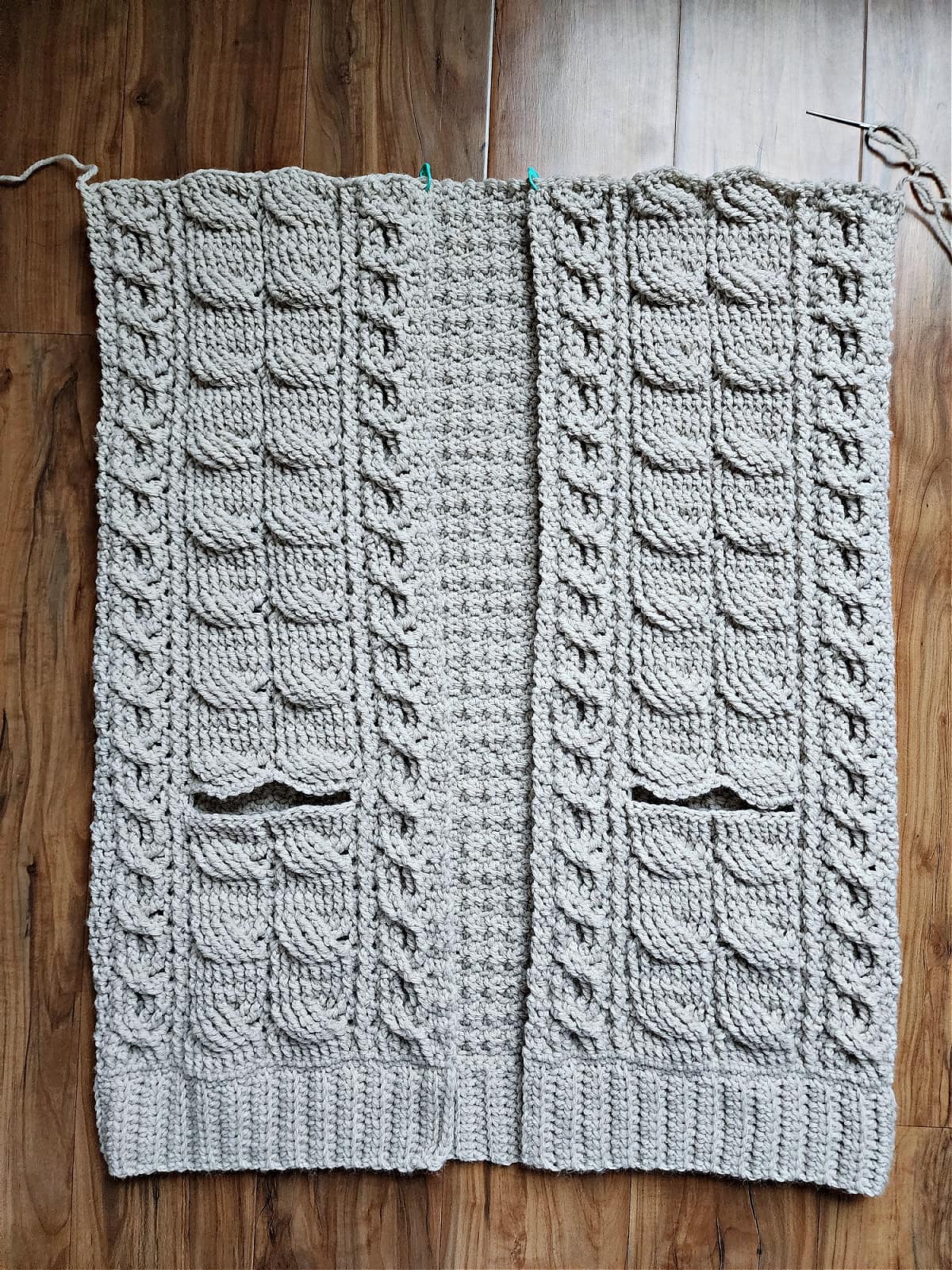
Step 2: Leave a 2″ (2″, 2″, 4″, 5″, 5″, 6″, 6″, 6″) W gap between the front panels, along the top edge of the Back Panel. Use locking stitch markers to hold the panels in place. See photo above.
Step 3: With the right side facing out, use a yarn needle and the tail of yarn left after completing the front panels and whipstitch a front panel to the back panel. Repeat for the second front panel.
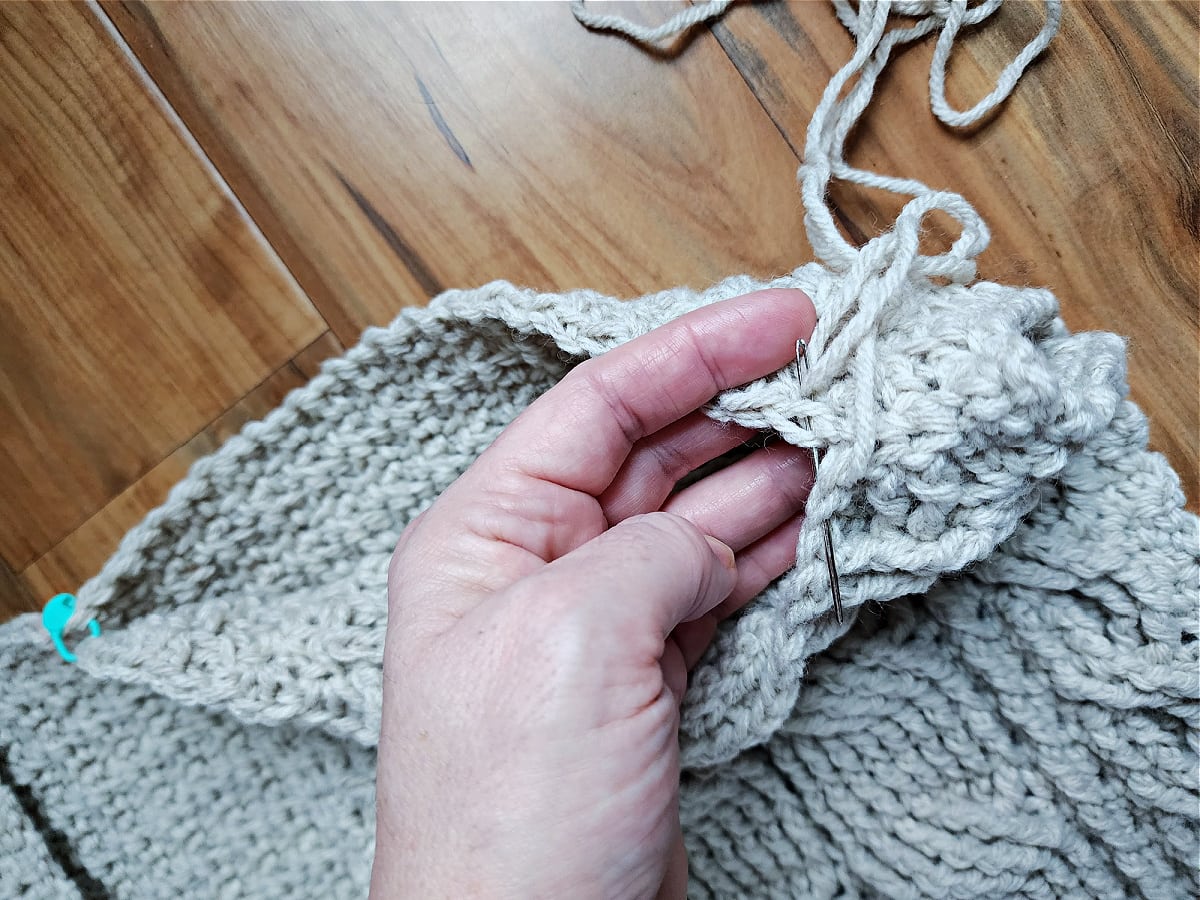
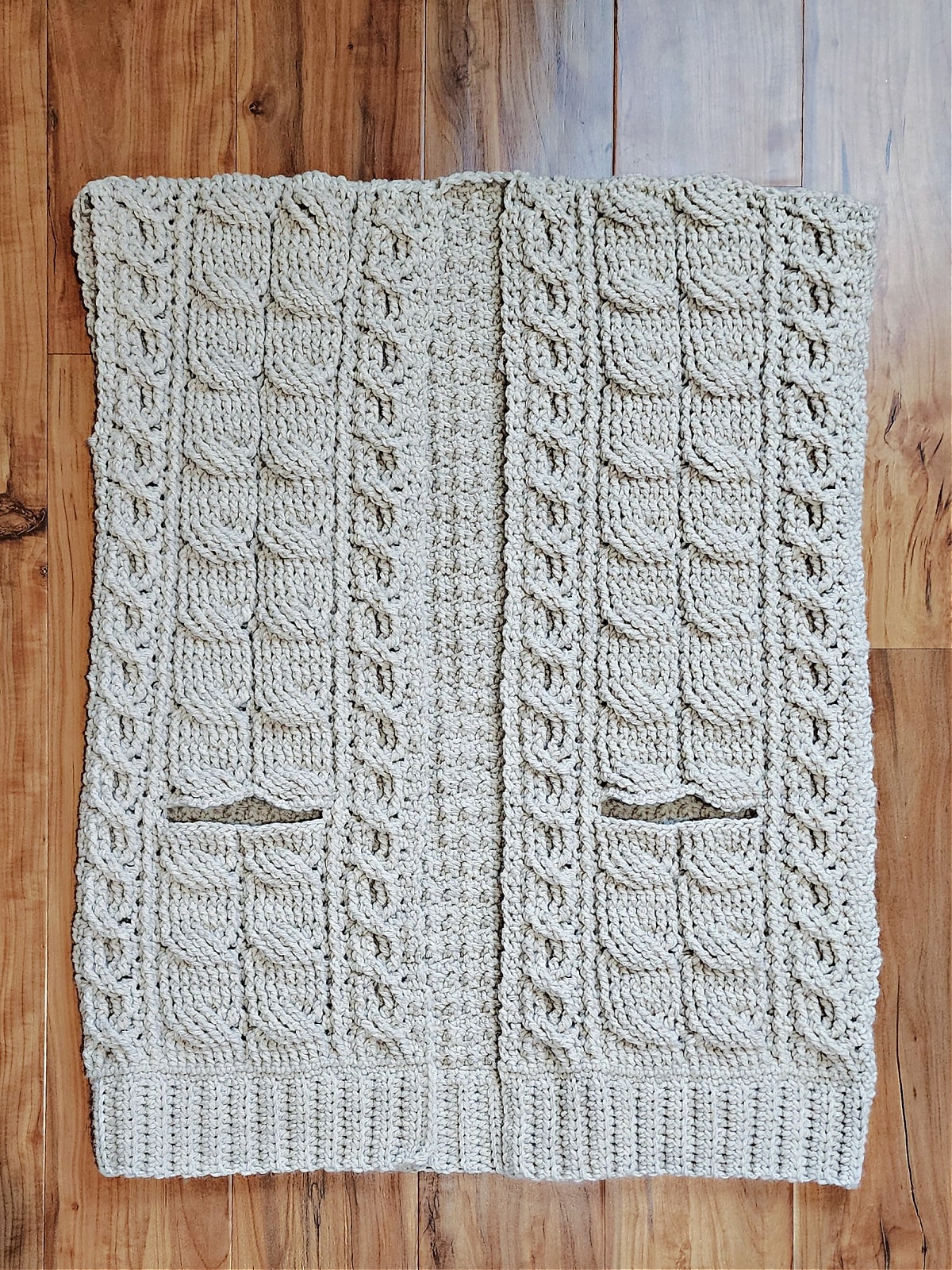
Weave in ends. Continue on to the Sleeve Set-Up below.
Sleeve Set-Up
Continue on to the size you’re making.
X-Small & Small
Rnd 1 (RS): With yarn & a 6.00mm crochet hook, join yarn with a standing sc in a stitch nearest the bottom of the armhole opening, sc in the next st, (2 sc in the next st, sc in each of the next 2 sts) work from ( to ) 10 times. Join with a sl st to the 1st st. (42, 42 sts)
Do not fasten off. Continue on to the Sleeves below.
Medium
Rnd 1 (RS): With yarn & a 6.00mm crochet hook, join yarn with a standing sc in a stitch nearest the bottom of the armhole opening, sc in the next st, 2 sc in the next st, (sc in each of the next 2 sts, 2 sc in the next st) work from ( to ) 11 times. Join with a sl st to the 1st st. (48 sts)
Do not fasten off. Continue on to the Sleeves below.
Large
Rnd 1 (RS): With yarn & a 6.00mm crochet hook, join yarn with a standing sc in a stitch nearest the bottom of the armhole opening, sc in each of the next 5 sts, (2 sc in the next st, sc in the next st) work from ( to ) 14 times, then sc in each of the last 6 sts. Join with a sl st to the 1st st. (54 sts)
Do not fasten off. Continue on to the Sleeves below.
X-Large
Rnd 1 (RS): With yarn & a 6.00mm crochet hook, join yarn with a standing sc in a stitch nearest the bottom of the armhole opening, sc in the next st, (2 sc in the next st, sc in each of the next 2 sts) work from ( to ) 14 times. Join with a sl st to the 1st st. (58 sts)
Do not fasten off. Continue on to the Sleeves below.
2XL & 3XL
Rnd 1 (RS): With yarn & a 6.00mm crochet hook, join yarn with a standing sc in a stitch nearest the bottom of the armhole opening, sc in the next st, 2 sc in the next st, (sc in each of the next 2 sts, 2 sc in the next st) work from ( to ) 15 times. Join with a sl st to the 1st st. (64, 64 sts)
Do not fasten off. Continue on to the Sleeves below.
4XL & 5XL
Rnd 1 (RS): With yarn & a 6.00mm crochet hook, join yarn with a standing sc in a stitch nearest the bottom of the armhole opening, sc in each of the next 3 sts, (sc in each of the next 2 sts, 2 sc in the next st) work from ( to ) 16 times. Join with a sl st to the 1st st. (68, 68 sts)
Do not fasten off. Continue on to the Sleeves below.
Sleeves – Sizes XS, S, M, L & XL
Gauge: With a 6.00mm crochet hook, in ext sc alternating FLO & BLO: 12 sts = 3.5″; 11 rows = 4.25″.
Rnd 1 (RS): Ch 1, (ext sc in the BLO of the next st, ext sc in the FLO of the next st) rep from ( to ) around. Join. Turn. (42, 42, 48, 54, 58 sts)
Rnd 2 (WS): Ch 1, (ext sc in the FLO of the next st, ext sc in the BLO of the next st) rep from ( to ) around. Join. Turn. (42, 42, 48, 54, 58 sts)
Rnds 3 – 4: Rep Rnds 1 – 2.
Rnd 5: Ch 1, Both Loops extsc2tog, (ext sc in the BLO of the next st, ext sc in the FLO of the next st) rep from ( to ) around to the last 2 sts, Both Loops extsc2tog. Join. Turn. (40, 40, 46, 52, 56 sts) Stitch count decreases by 2.
Rnd 6: Ch 1, (ext sc in the BLO of the next st, ext sc in the FLO of the next st) rep from ( to ) around. Join. Turn. (40, 40, 46, 52, 56 sts) Stitch count does not decrease.
Rnd 7: Ch 1, (ext sc in the FLO of the next st, ext sc in the BLO of the next st) rep from ( to ) around. Join. Turn. (40, 40, 46, 52, 56 sts) Stitch count does not decrease.
Do not fasten off. Continue on with the instructions for the size sleeves you’re making.
Sizes XS & S
Rnds 8 – 10: Re pRnds 5 – 7. (38, 38 sts)
Rnds 11 – 12: Rep Rnds 6 – 7. (38, 38 sts)
Rnds 13 – 18: Rep Rnds 5 – 7. (34, 34 sts)
Rnds 19 – 22: Rep Rnds 6 – 7. (34, 34 sts)
Rnds 23 – 28: Rep Rnds 5 – 7. (30, 30 sts)
Rnds 29 – 38: Rep Rnds 6 – 7. (30, 30 sts)
Rnd 39 (RS): Ch 1, sc in each st around. Join. Do not turn. (30, 30 sts)
If you need to lengthen your sleeve, simply repeat Rnd 39. Note that the cuff will add 2″ to the length of your sleeve.
Do not fasten off. Continue onto the Sleeve Cuff below. Sleeve should measure 14-1/2″ L before the cuff.
Size Medium
Rnds 8 – 31: Rep Rnds 5 – 7. (30 sts) at the end of Rnd 29.
Rnds 32 – 38: Rep Rnds 6 – 7, ending with a Rnd 6. (30 sts)
Rnd 39 (RS): Ch 1, sc in each st around. Join. Do not turn. (30 sts)
If you need to lengthen your sleeve, simply repeat Rnd 39. Note that the cuff will add 2″ to the length of your sleeve.
Do not fasten off. Continue onto the Sleeve Cuff below. Sleeve should measure 14-1/2″ L before the cuff.
Size Large
Rnds 8 – 28: Rep Rnds 5 – 7. (38 sts) at the end of Rnd 26.
Rnds 29 – 38: Rep Rnds 6 – 7. (38 sts)
Rnd 39 (RS): Ch 1, sc in each st around. Join. Do not turn. (38 sts)
If you need to lengthen your sleeve, simply repeat Rnd 39. Note that the cuff will add 2″ to the length of your sleeve.
Do not fasten off. Continue onto the Sleeve Cuff below. Sleeve should measure 14-1/2″ L before the cuff.
Size X-Large
Rnds 8 – 34: Rep Rnds 5 – 7. (38 sts) at the end of Rnd 32.
Rnds 35 – 38: Rep Rnds 6 – 7. (38 sts)
Rnd 39 (RS): Ch 1, sc in each st around. Join. Do not turn. (38 sts)
If you need to lengthen your sleeve, simply repeat Rnd 39. Note that the cuff will add 2″ to the length of your sleeve.
Do not fasten off. Continue onto the Sleeve Cuff below. Sleeve should measure 14-1/2″ L before the cuff.
Sleeves – Sizes 2XL, 3XL, 4XL, 5XL
Gauge: With a 6.00mm crochet hook, in ext sc alternating FLO & BLO: 12 sts = 3.5″; 11 rows = 4.25″.
Rnd 1: Ch 1, Both Loops extsc2tog, (ext sc in the BLO of the next st, ext sc in the FLO of the next st) rep from ( to ) around to the last 2 sts, Both Loops extsc2tog. Join. Turn. (64, 64, 68, 68 sts) Stitch count decreases by 2.
Rnd 2: Ch 1, (ext sc in the BLO of the next st, ext sc in the FLO of the next st) rep from ( to ) around. Join. Turn. (62, 62, 66, 66 sts)
Rnd 3: Ch 1, (ext sc in the FLO of the next st, ext sc in the BLO of the next st) rep from ( to ) around. Join. Turn. (62, 62, 66, 66 sts)
If you need to lengthen your sleeve, simply repeat Rnd 39. Note that the cuff will add 2″ to the length of your sleeve.
Do not fasten off. Continue on with the instructions for the size sleeves you’re making.
Sizes 2X & 3X
Rnds 4 – 38: Rep Rnds 1 – 3, ending with a Rnd 2. (38, 38 sts) at the end of Rnd 37.
Rnd 39 (RS): Ch 1, sc in each st around. Join. Do not turn. (38, 38 sts)
If you need to lengthen your sleeve, simply repeat Rnd 39. Note that the cuff will add 2″ to the length of your sleeve.
Do not fasten off. Continue onto the Sleeve Cuff below. Sleeve should measure 14-1/2″ L before the cuff.
Sleeves – Sizes 4X & 5X
Rnds 4 – 37: Rep Rnds 1 – 3, ending with a Rnd 1. (42, 42 sts) at the end of Rnd 37.
Rnd 38: Rep Rnd 1. (40, 40 sts)
Rnd 39 (RS): Ch 1, sc in each st around. Join. Do not turn. (40, 40 sts)
If you need to lengthen your sleeve, simply repeat Rnd 39. Note that the cuff will add 2″ to the length of your sleeve.
Do not fasten off. Continue onto the Sleeve Cuff below. Sleeve should measure 14-1/2″ L before the cuff.
Ribbed Sleeve Cuff – All Sizes
Row 1: Continuing on from the sleeve with a 6.00mm crochet hook, ch 6, working into the back humps of the ch, hdc in the 2nd ch from your hook, hdc in each of the next 3 sts, hdc2tog in next stand same st as ch 6. Do not turn yet. (5sts)
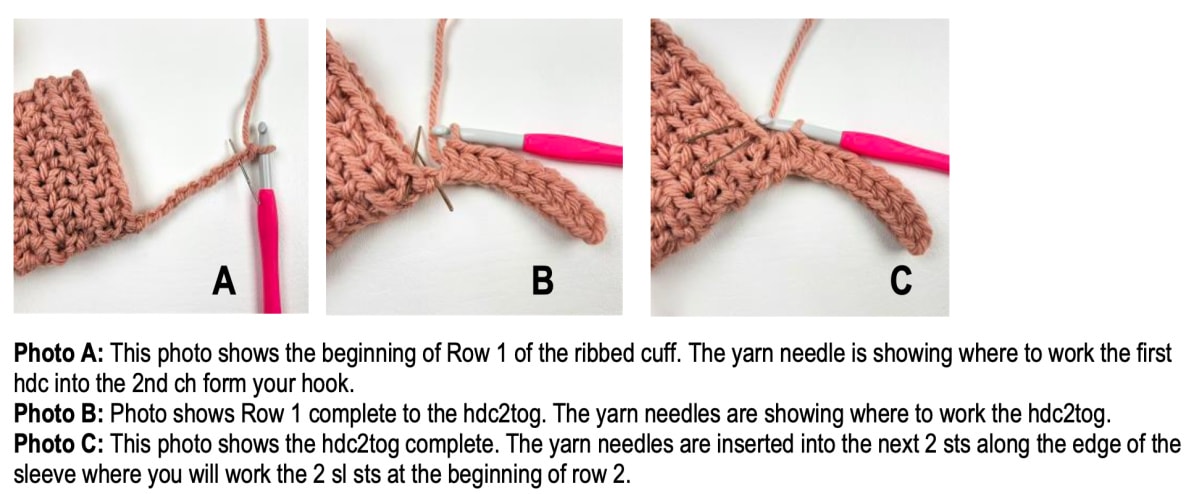
Row 2: (Sl st into the NEXT st along the edge of the sleeve) 2 times, Turn, BLO hdc in each of the next 5 sts. Turn. (5 sts)
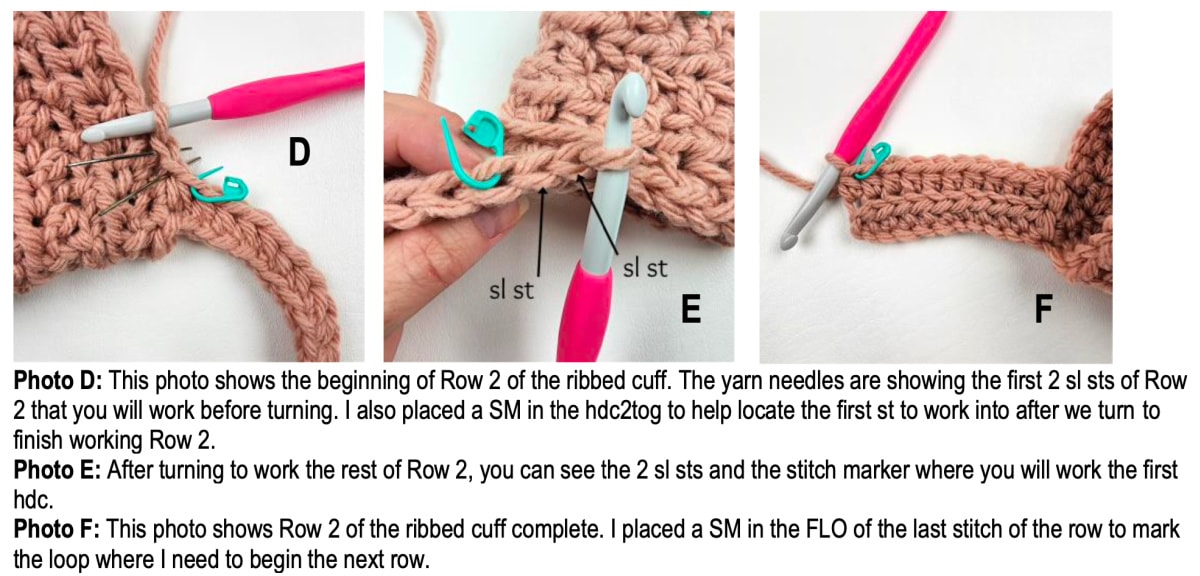
Row 3: Ch 1, BLO hdc in the first st, BLO hdc in each of the next 3 sts, BLO hdc2tog in the next st and the NEXT st along the edge of the sleeve. (5 sts)
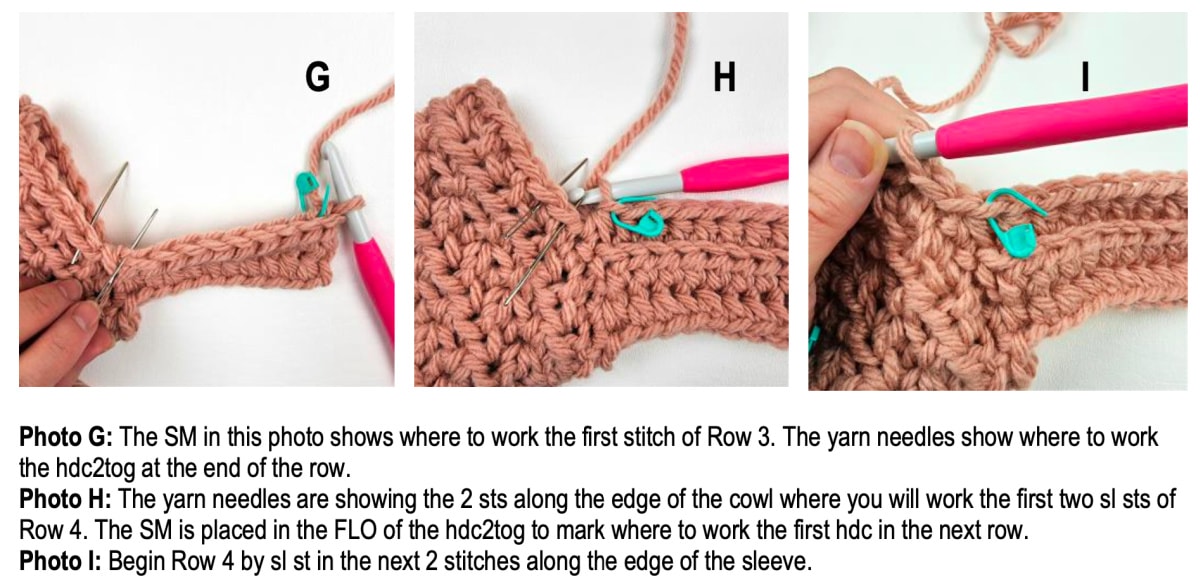
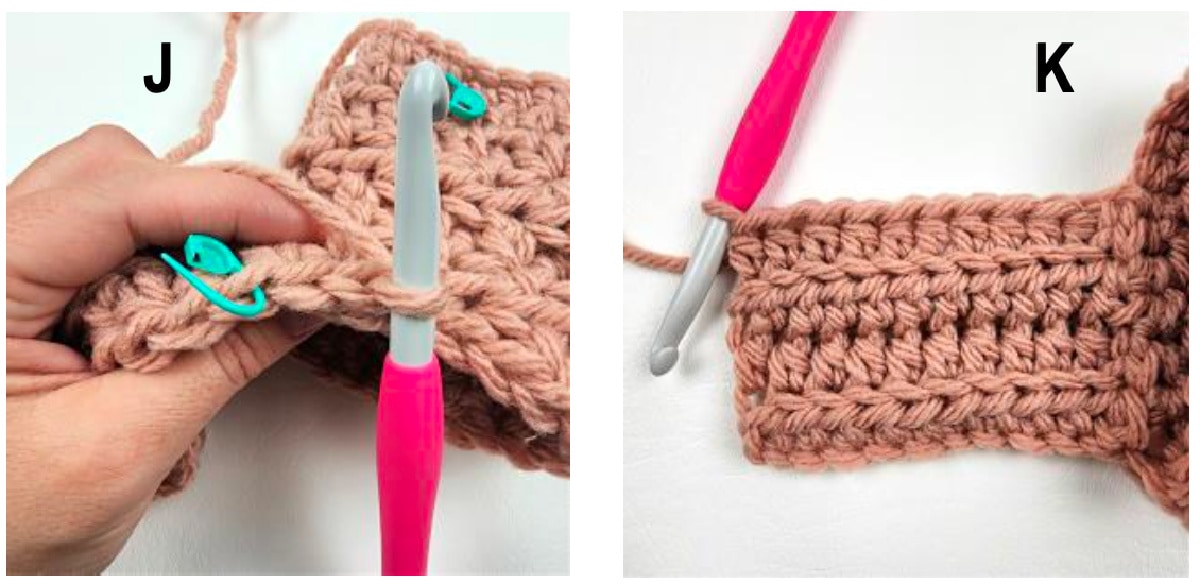
Photo K: This photo shows Rows 1 – 4 complete.
Do not fasten off. Continue below to the size you’re making.
Sizes XS, S & M
Rows 4 – 20: Rep Rows 2 – 3, ending with a Row 2. (5 sts)
Fasten off leaving an 8″ tail of yarn. Using a yarn needle and the tail of yarn, whipstitch the last row to the first row. Weave in ends. Sleeve should measure 16″ L. Continue on to the Pockets below.
Sizes L, XL, 2X & 3X
Rows 4 – 25: Rep Rows 2 – 3. (5 sts)
Row 26: Sl st into the NEXT st along the edge of the sleeve, Turn, BLO hdc in each of the next 5 sts. Turn. (5 sts)
Fasten off leaving an 8″ tail of yarn. Using a yarn needle and the tail of yarn, whipstitch the last row to the first row. Weave in ends. Sleeve should measure 16″ L. Continue on to the Pockets below.
Sizes 4X & 5X
Rows 4 – 27: Rep Rows 2 – 3. (5 sts)
Fasten off leaving an 8″ tail of yarn. Using a yarn needle and the tail of yarn, whipstitch the last row to the first row. Weave in ends. Sleeve should measure 16″ L. Continue on to the Pockets below.
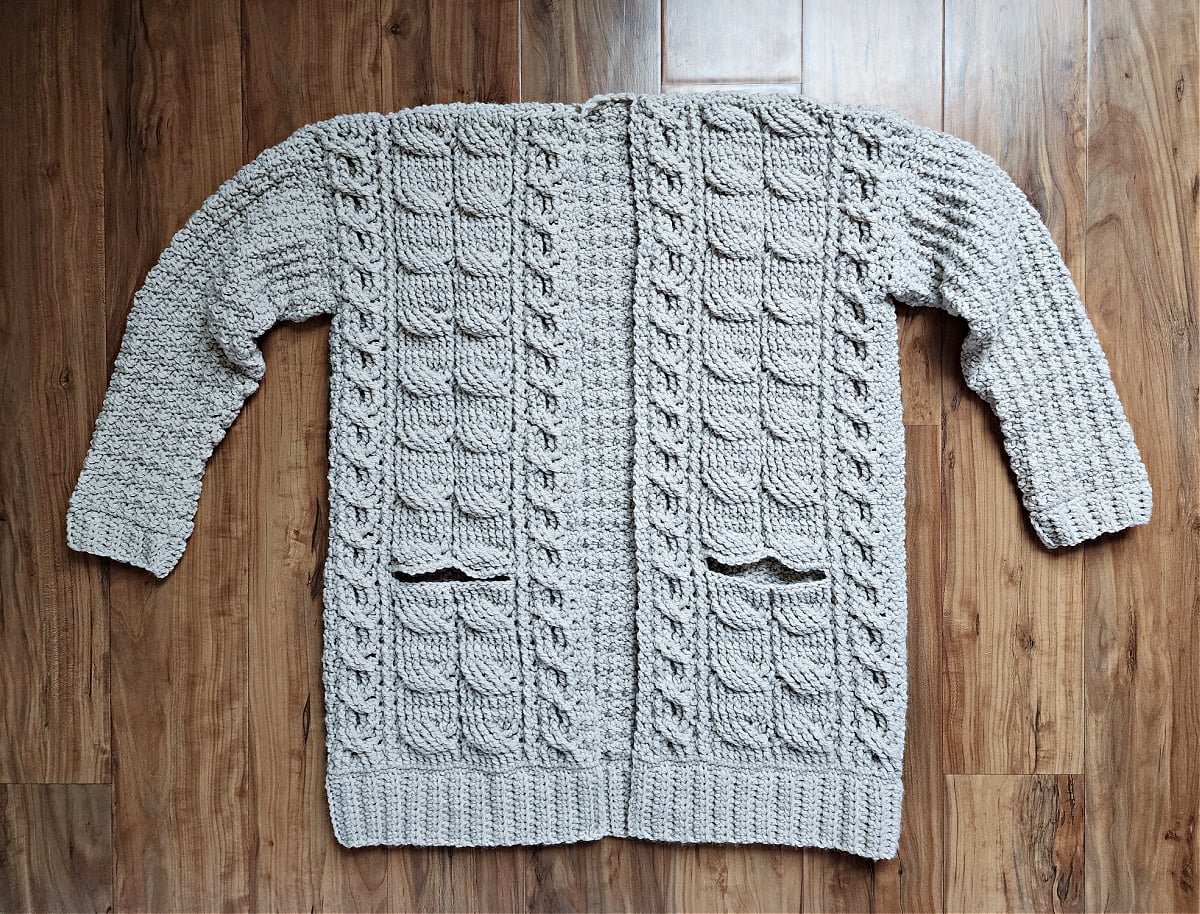
Pocket Pouch (Make 2)
Rnd 1: With a 6.00mm crochet hook & yarn, make a chain that is the same size as the perimeter of the pocket opening, join with a sl st to the 1st ch to form a circle. Stitch count isn’t crucial.
Rnd 2: Ch 1, working in the back humps of the ch, sc in each ch around. Join.
Rnds 3 – 23: Ch 1, sc in each st around. Join.
Pocket Seam: Lay the pocket flat so that you have a double layer of stitches from the last round. Line up stitches from the last round, then seam the pocket by working a sc across, making sure to work through both layers.
Fasten off. Weave in ends. Make the second pocket, then continue on to Attaching the Pockets.
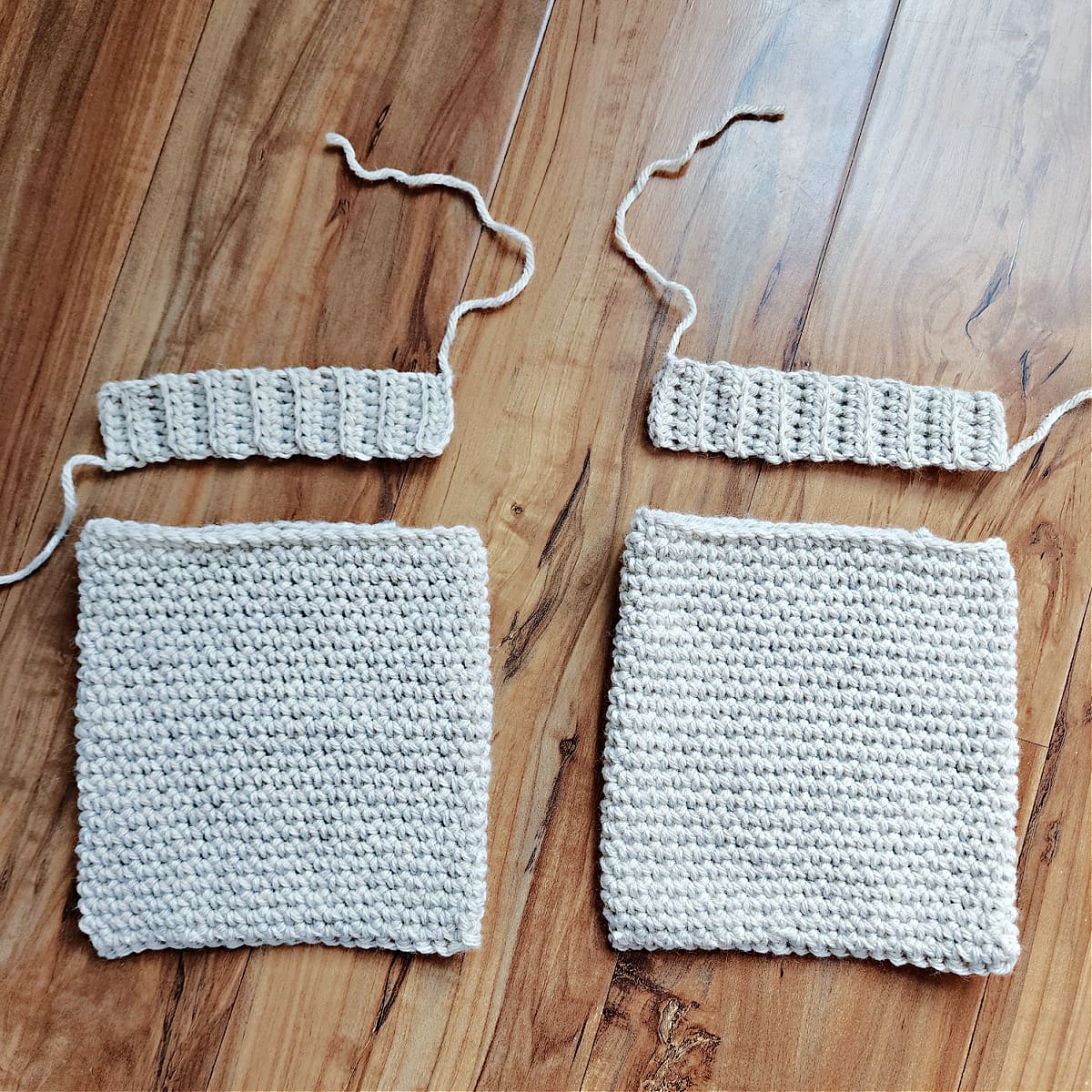
Attaching the Pockets
Step One: Insert a pocket into the pocket opening. Line up the opening in the pocket with the pocket opening on the cardigan. Use a few locking stitch markers to hold it in place while attaching it to the cardigan.
Step Two: With a yarn needle and piece of yarn that is 3 – 4 times the perimeter of the pocket, whipstitch the open edge of the pocket to the pocket opening in the cardigan.
Weave in ends. Repeat for the second pocket. Continue on to the Pocket Ribbing.
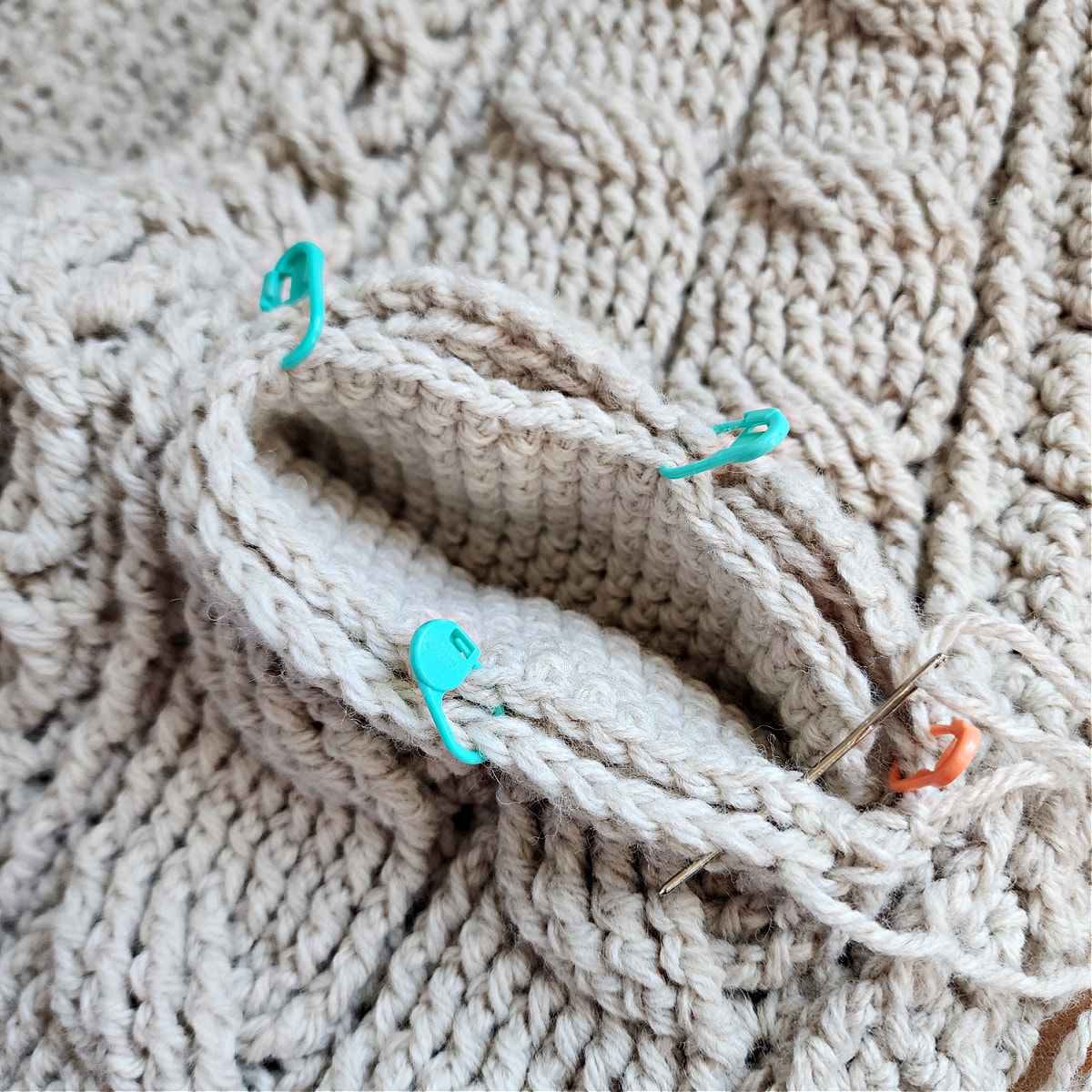
Pocket Ribbing (Make 2)
Row 1: With a 4.00mm crochet hook and yarn, ch 7, working in the back hump of the foundation ch, hdc in the 2nd ch from your hook and in each ch across. Turn. (6 sts)
Row 2: Ch 1, BLO hdc in each st across. Turn. (6 sts)
Rep Row 2 until your pocket ribbing measures just a tad shorter than the length of the pocket opening. So when stretched a little, it should measure the length of the pocket opening.
Fasten off, leaving a tail of yarn 3 – 4 times the length of the pocket ribbing. Line up the long edge of the pocket ribbing with the pocket opening. Use a yarn needle and tail of yarn and whipstitch the pocket ribbing to the top of the pocket opening. Then, sew the short edges of the pocket ribbing onto the cardigan.
Weave in ends. Continue on to the Front Opening Edge below.
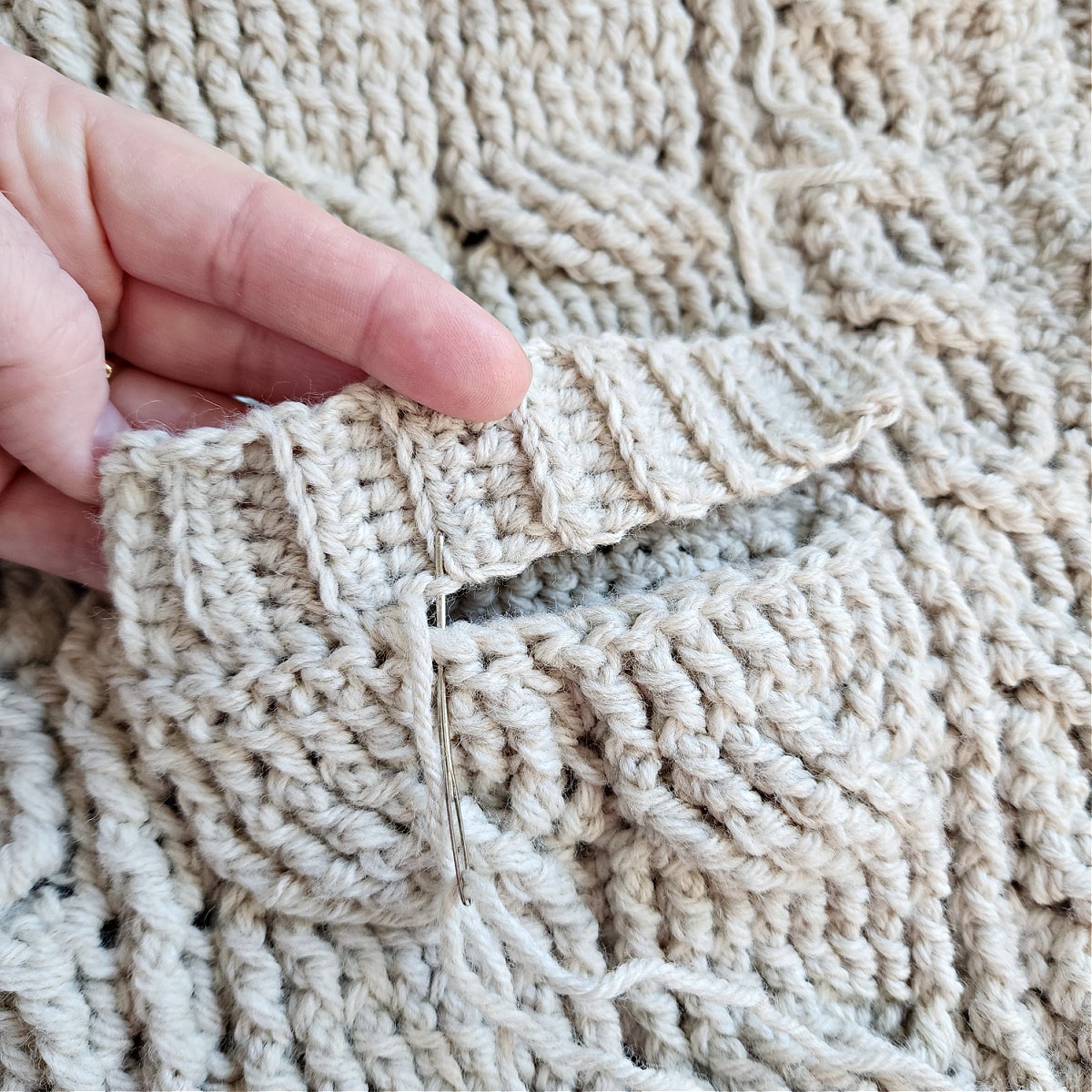
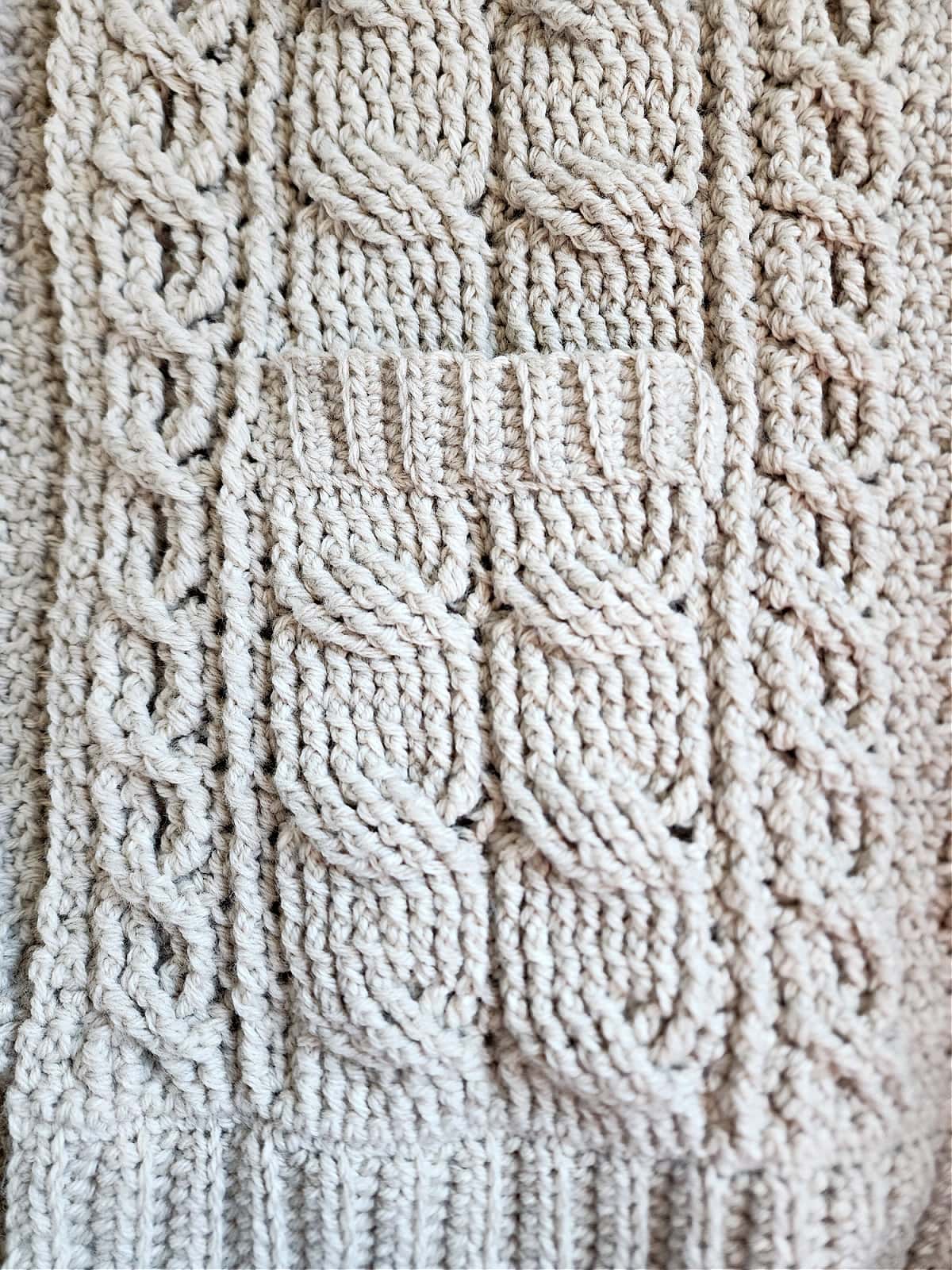
Front Opening Edge
Row 1 (RS): Position the cardigan so that the right side is facing you, with yarn & a 6.00mm crochet hook, join yarn with a standing sc in the bottom corner of the cardigan’s right panel, sc in each st across the bottom ribbing, sc in each st up along the front opening of the cardigan, sc in each st across the back neck opening, sc in each st down along the left side of the front opening to the bottom ribbing, sc in each st across the bottom ribbing. Turn. Stitch count is not crucial.
Row 2: Ch 1, BLO hdslst in each st around the opening. Turn. Stitch count stays the same.
Row 3: Ch 1, BLO sc in each st around. Turn. Stitch count stays the same.
Row 4: Rep Row 2. Stitch count stays the same.
Fasten off. Weave in ends. Block your cardigan, if desired and then your crochet cable stitch cardigan is ready to wear!
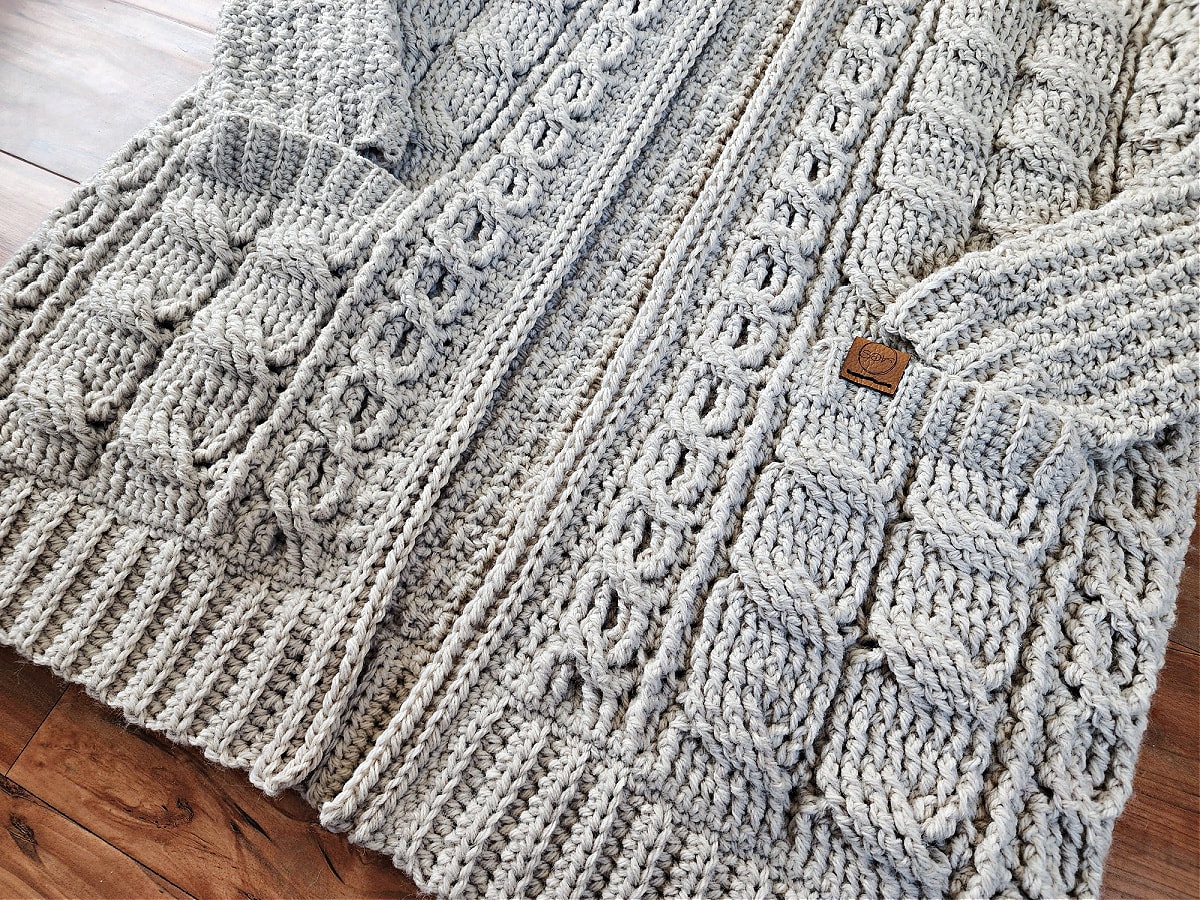
Crochet Cable Stitch
The following are photo tutorials for both crochet cable stitch patterns used on the front of this cardigan.
Narrow Cable Twists in Rows 4, 8 & 12
This photo tutorial is for the narrow cable twists that are in Rows 4, 8 & 12 and their repeats.
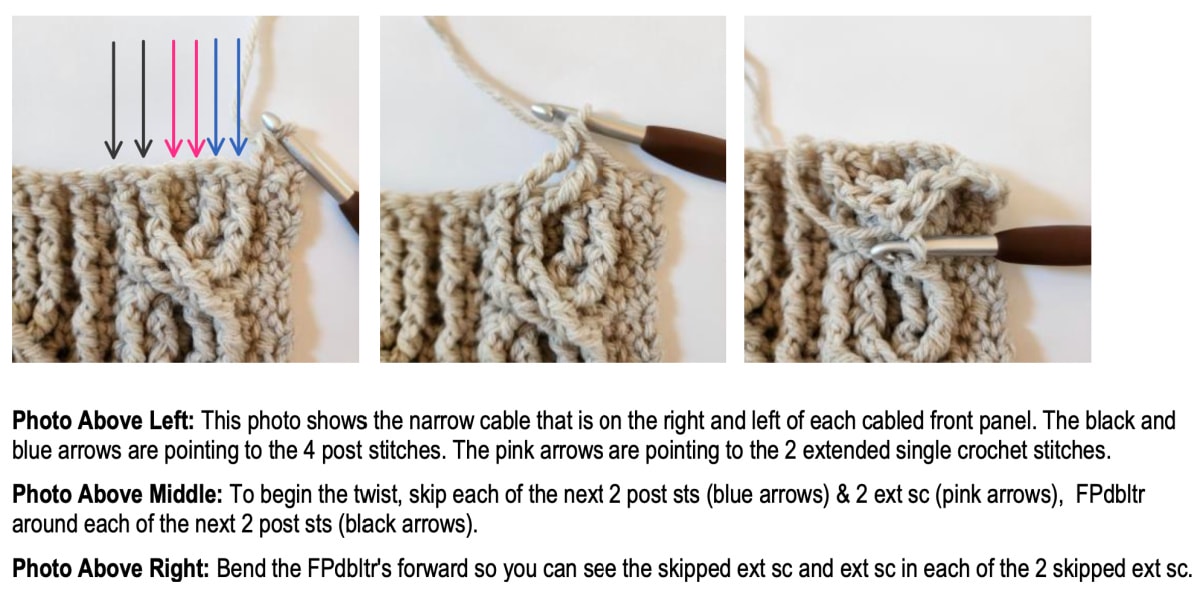
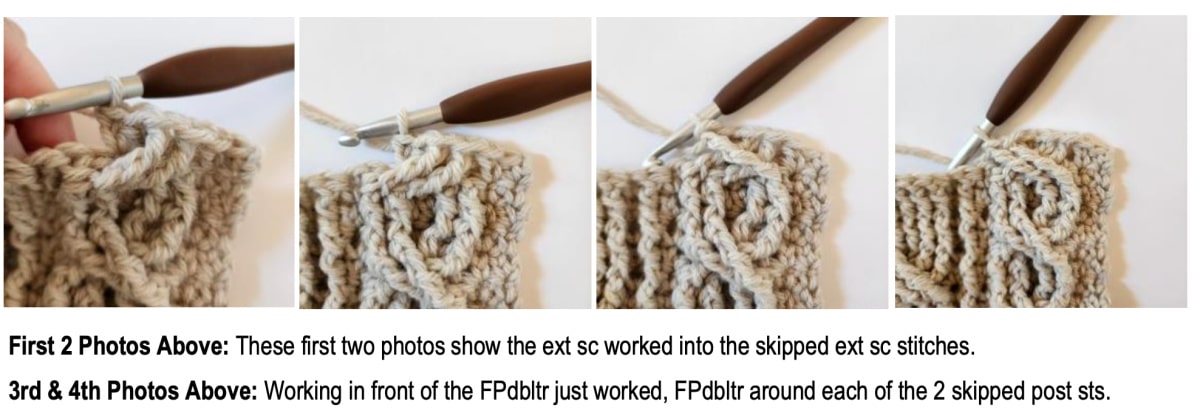
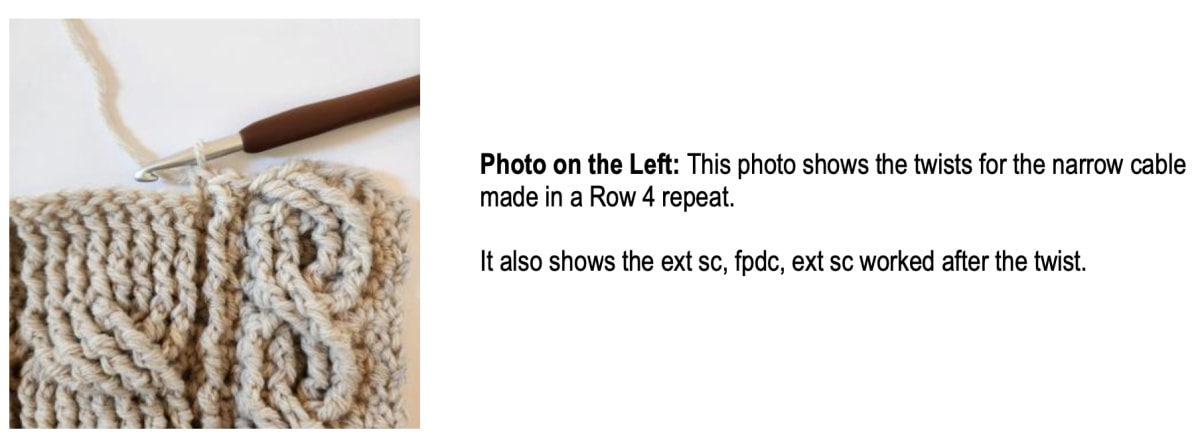
Wide Cable Twists in Rows 4 & 10
This photo tutorial is for the wide cable twists that are in Rows 4 & 10 and their repeats.
Note: The photos below are of the size Medium cables which are 8 stitches wide. If you are making a size XS or S, your wide cables are only 6 stitches wide. However, the steps for working them is the same.
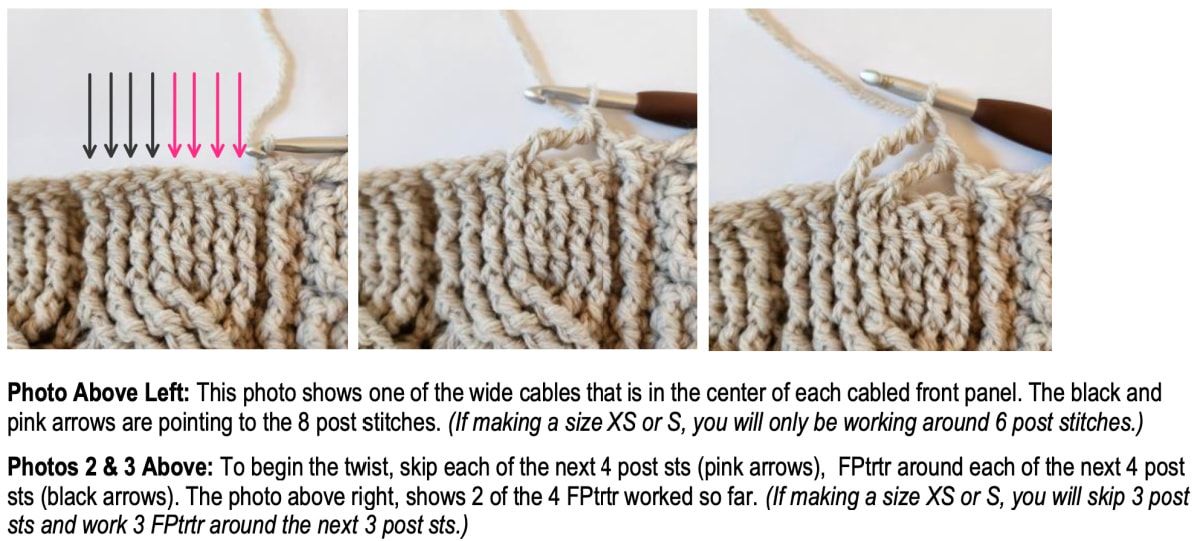
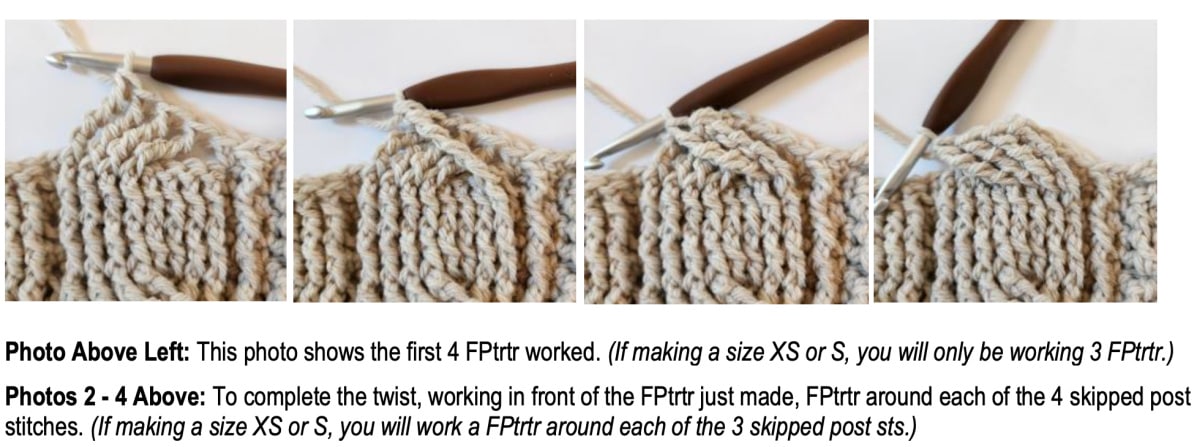
Additional Photos of the Cabled Rows
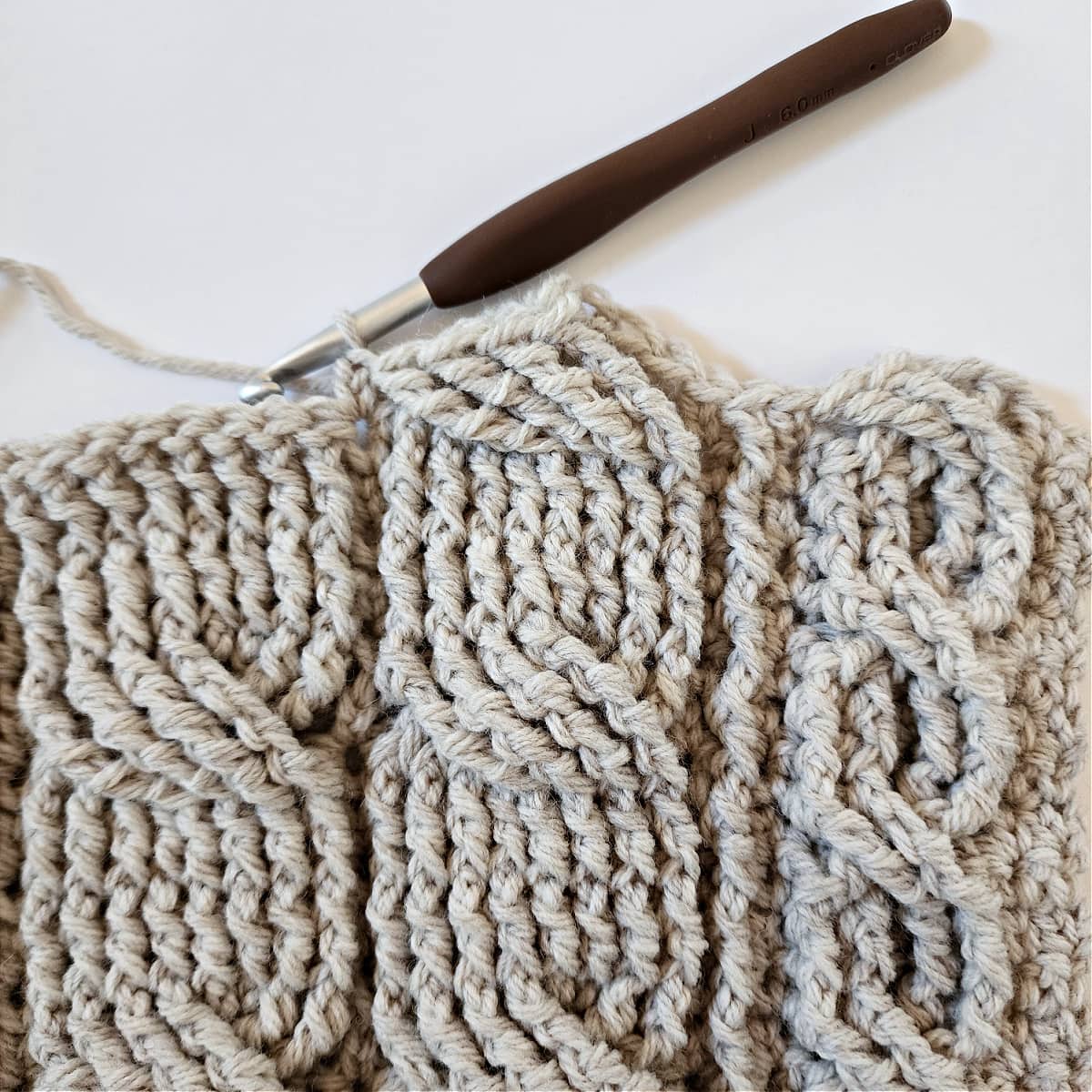
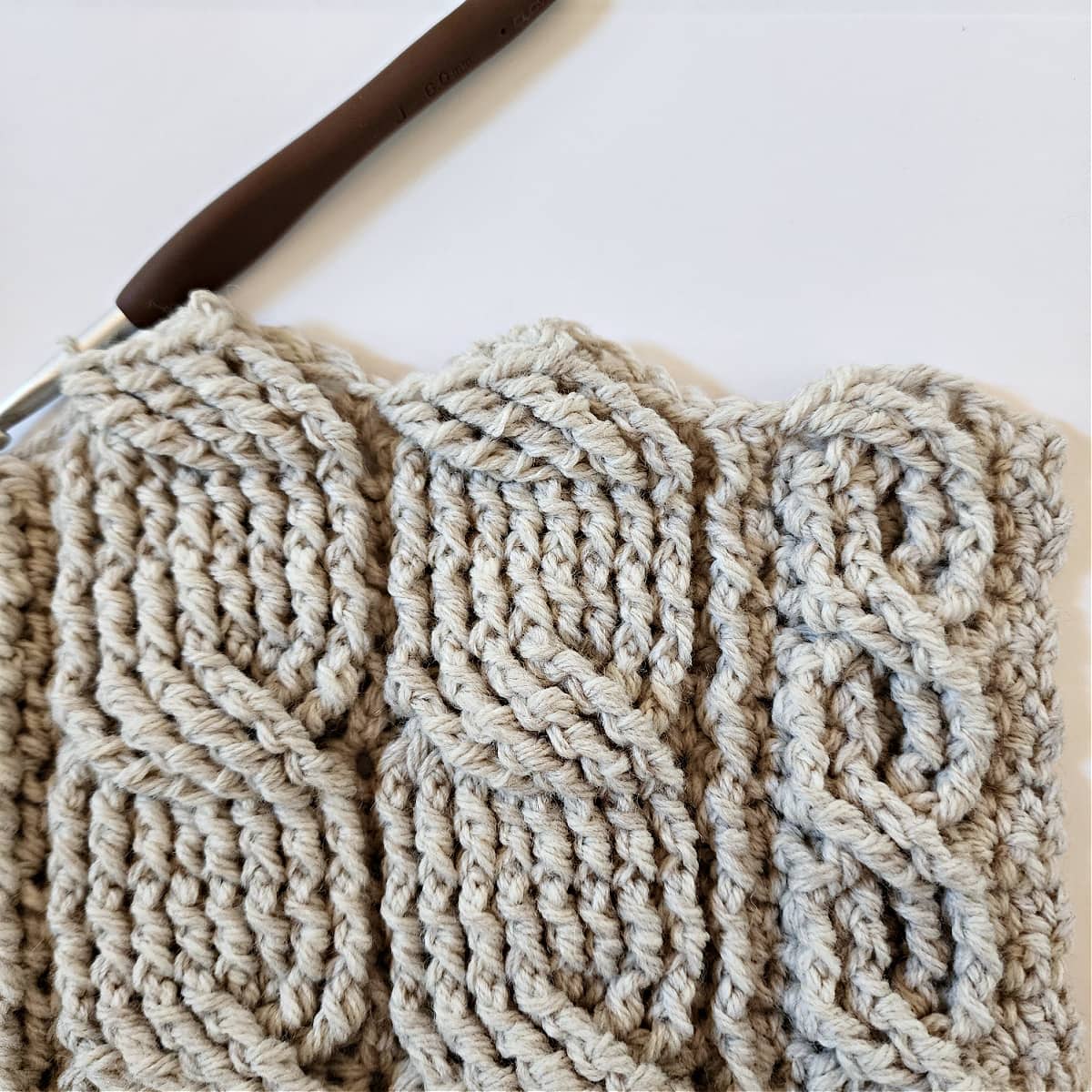
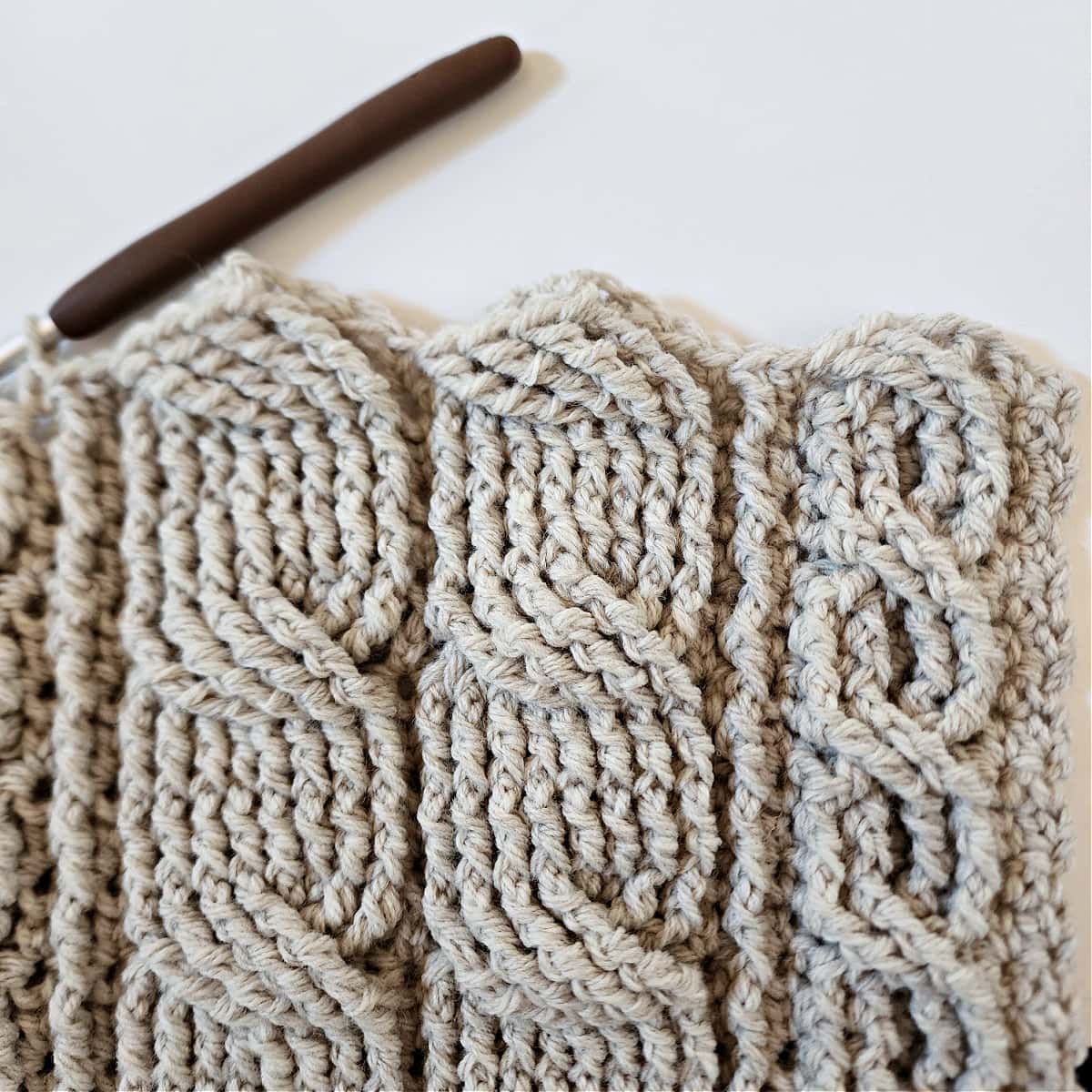
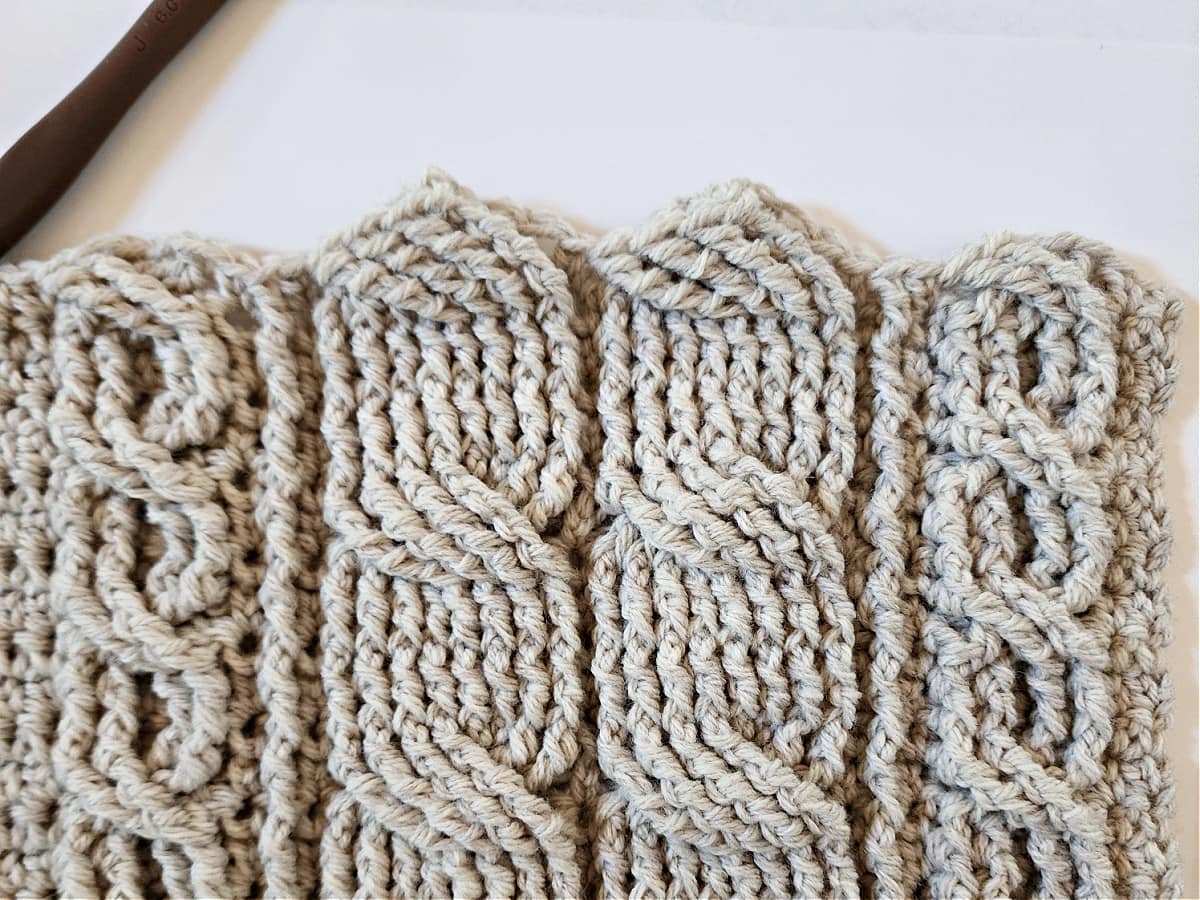
Related: If you need to learn how to block a crochet sweater, check out my post on 3 blocking methods!

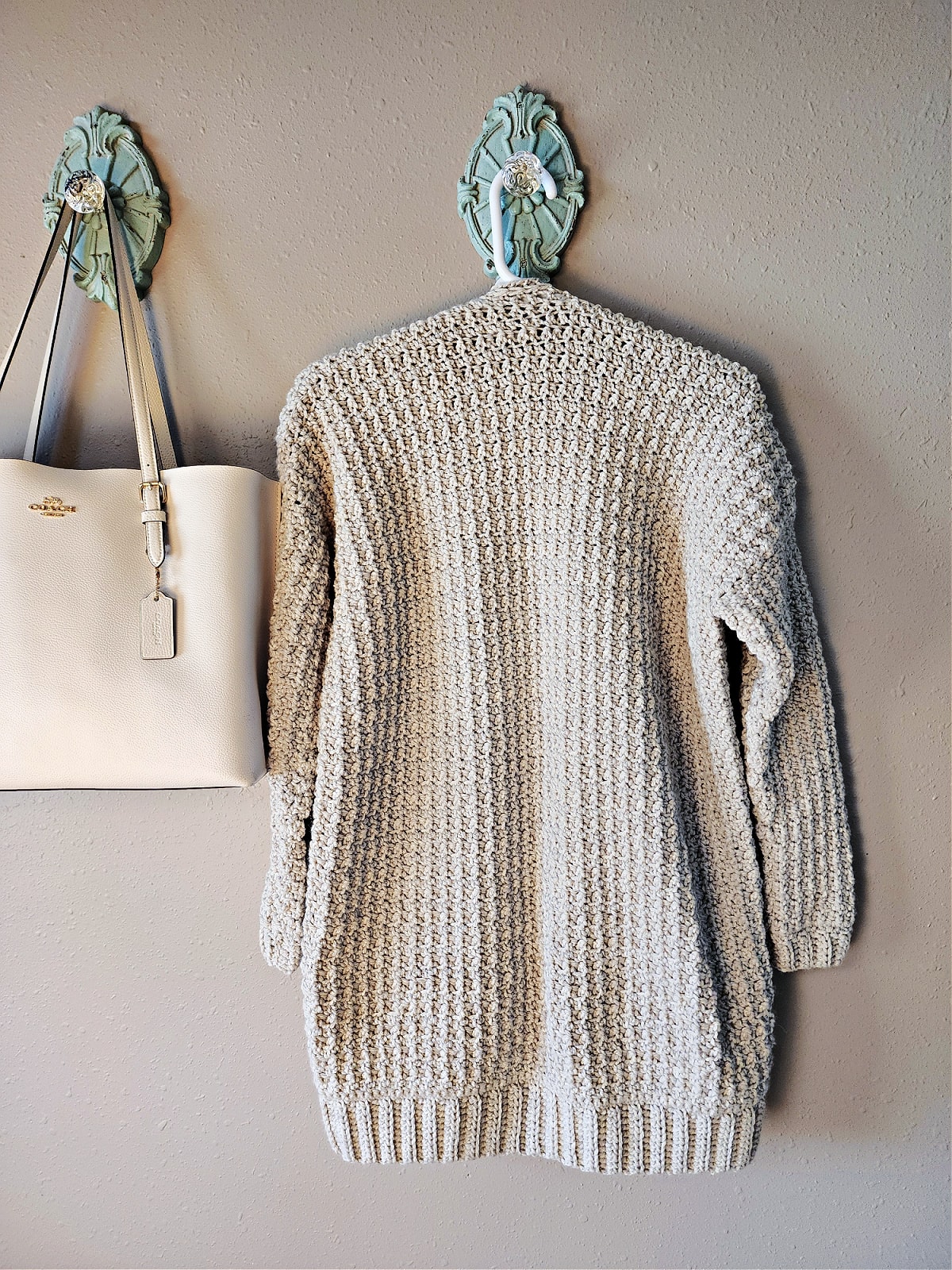
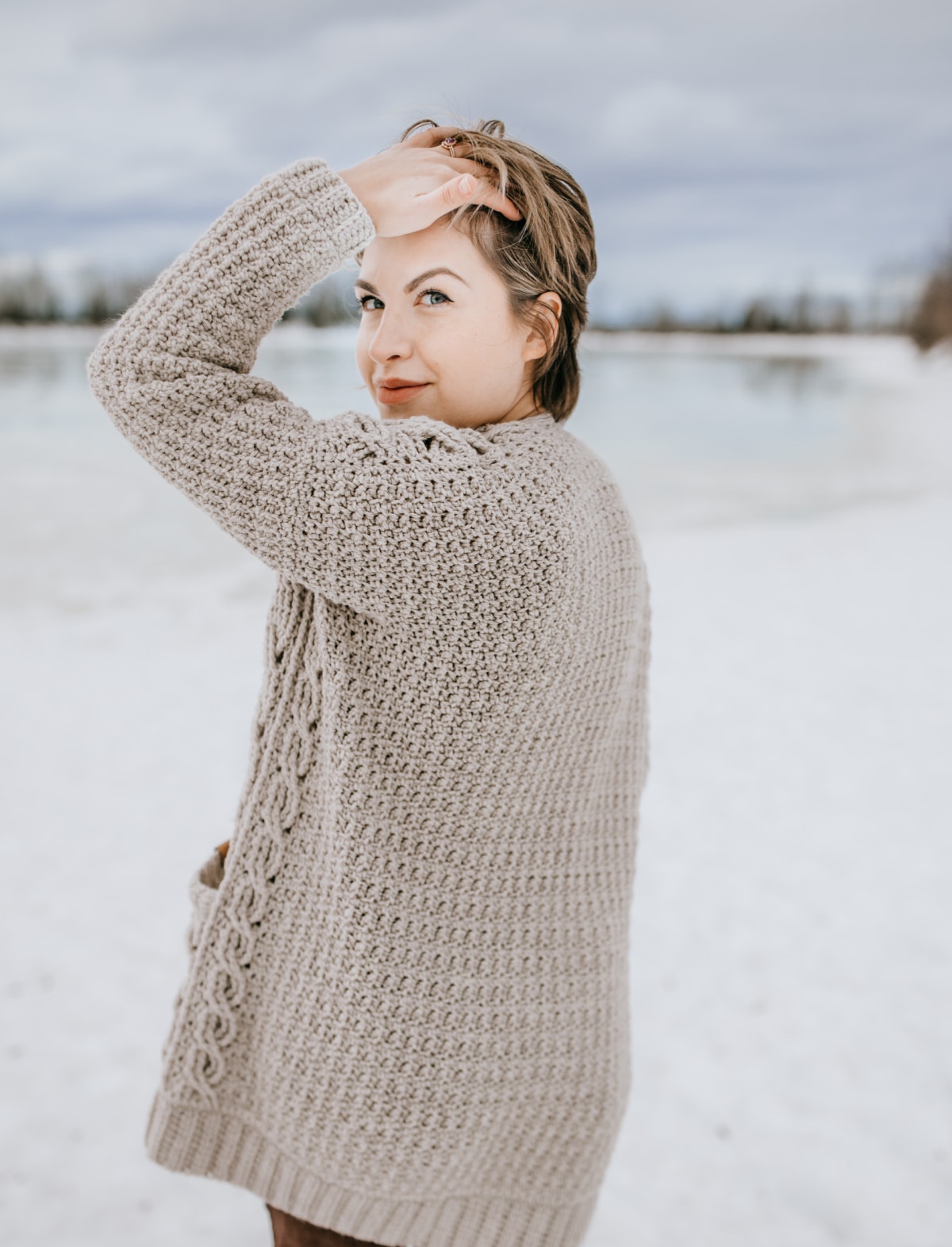
I MADE IT! NOW WHAT?
Pin this post!: Save this crochet cable cardigan pattern to your Pinterest boards so that you can come back and make it again.
Leave a comment below: We love to hear your feedback.
Share Your Finished Projects on Facebook or Instagram: I love to see your finished projects! Share with us on social media and tag me @acrochetedsimplicity or use the hashtag #ACrochetedSimplicity so I can find your posts.
Join us in the Facebook Community Group!
Come share your finished projects with us in the A Crocheted Simplicity Crochet Community Group on Facebook. Join us for fun community events such as crochet alongs, join in on crochet conversations, ask questions, get advice, and share your love for crochet!

More Crochet Patterns for Cardigan Sweaters I Think You’ll Love
More Crochet Sweater Patterns
Are you looking for more crochet sweater patterns? We have several more patterns for crochet clothes, including matching sweaters for mothers and daughters and even for fathers and sons.

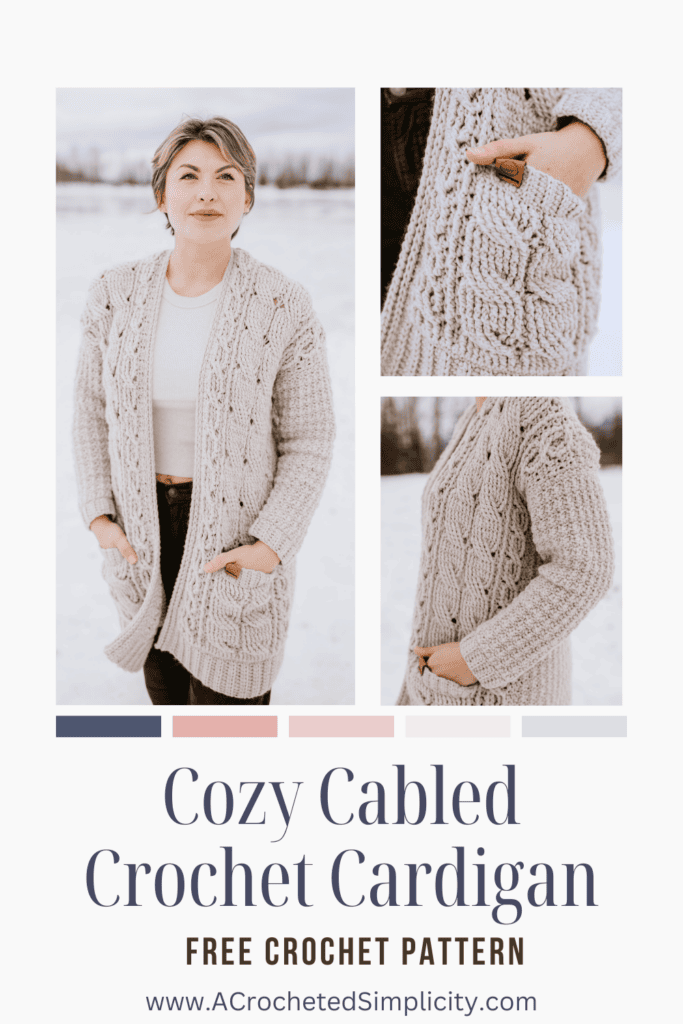

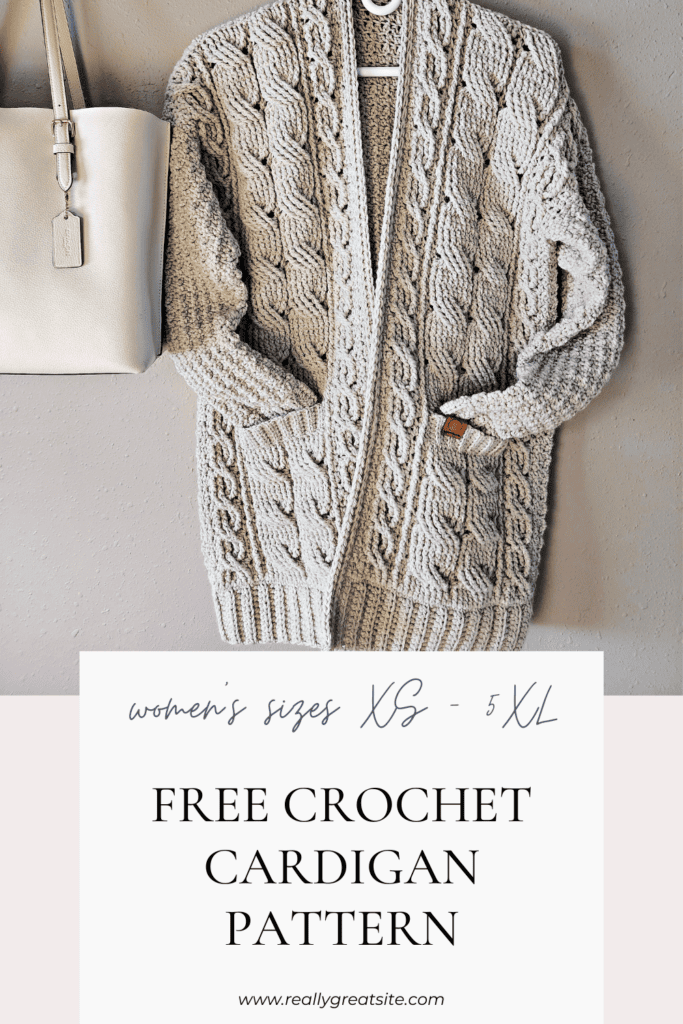
Back panel small page 19, row 1 should have 66 st at the end. is this right?
Hi Dawn,
Yes, the upper right and left panels have 35 sts and the back panel has 66 sts.
PATTERN VERY DESIGNED AND CREATIVE!!!!!
I’m 6 feet tall and 39″ length does not fall in the right spot. Any suggestions for making it longer?
Hi Lori,
Simply repeat Rows 4 – 7 until the Body of Cardigan length is long enough for you. This will be from the bottom of the underarm to the bottom hem.
Happy Crocheting,
Jennifer
Thank you so much❤️
I really like this sweater! thanks so much for sharing it
I’m so glad to hear it. Thank you, Diane!